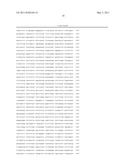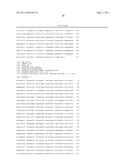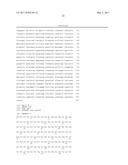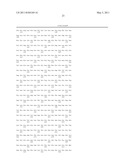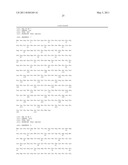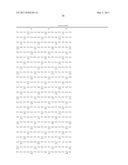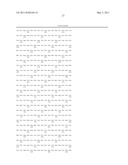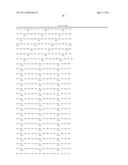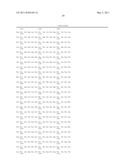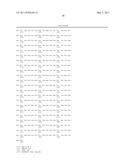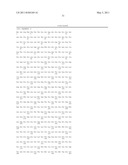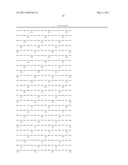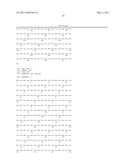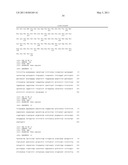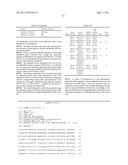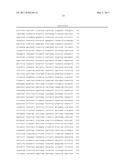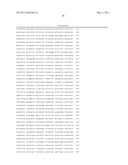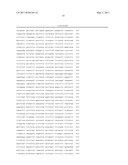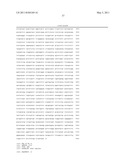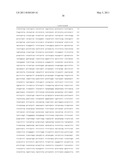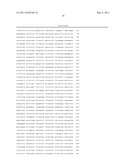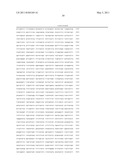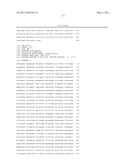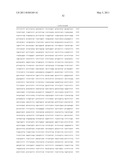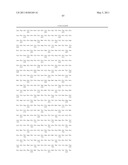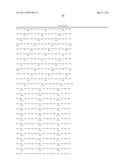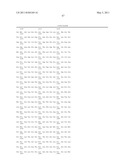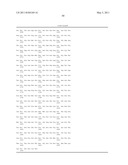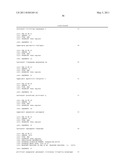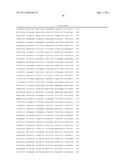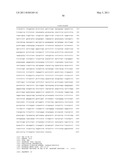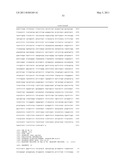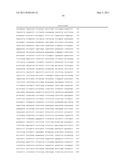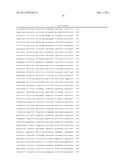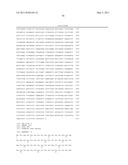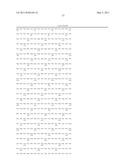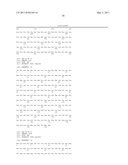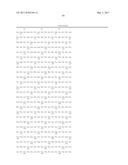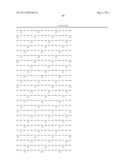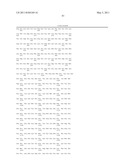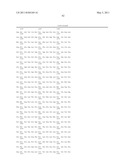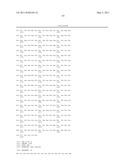Patent application title: REGULATOR GENES OF ANGIOGENESIS, PHARMACEUTICAL PREPARATIONS CONTAINING THEM AND THEIR APPLICATIONS
Inventors:
Salman Al-Mahmood (Paris, FR)
Sylvie Colin (Paris, FR)
Christophe Schneider (Reims, FR)
Assignees:
GENE SIGNAL INTERNATIONAL
IPC8 Class: AA61K39395FI
USPC Class:
4241391
Class name: Drug, bio-affecting and body treating compositions immunoglobulin, antiserum, antibody, or antibody fragment, except conjugate or complex of the same with nonimmunoglobulin material binds antigen or epitope whose amino acid sequence is disclosed in whole or in part (e.g., binds specifically-identified amino acid sequence, etc.)
Publication date: 2011-05-05
Patent application number: 20110104169
Claims:
1. A pharmaceutical composition comprising a pharmaceutically acceptable
carrier and an active agent comprising at least one substance selected
from the group consisting of: (i) a nucleic acid molecule, the expression
of which is induced in an endothelial cell by an angiostatic agent, or a
complementary sequence or a fragment or derivative thereof; (ii) a
polypeptide sequence coded by said nucleic acid molecule or the
complement fragment or derivative thereof, (iii) an antisense nucleic
acid molecule that inhibits the expression of a nucleic acid molecule
according to (i); and (iv) an antibody capable of binding to a
polypeptide sequence according to (ii).
2. The pharmaceutical composition according to claim 1, wherein the nucleic acid molecule is selected from among the group consisting of SEQ ID No. 1, SEQ ID No. 2, SEQ ID No. 3, SEQ ID No. 4, SEQ ID No. 5, SEQ ID No. 27, SEQ ID No. 28, SEQ ID No. 29 and SEQ ID No. 30.
3. The pharmaceutical composition according to claim 1, wherein the antisense nucleic acid molecule is an angiogenesis inhibitory sequence and comprises a nucleic acid sequence selected from among the group consisting of SEQ ID No. 1, SEQ ID No. 2, SEQ ID No. 3, SEQ ID No. 4, SEQ ID No. 5, SEQ ID No. 27, SEQ ID No. 28, SEQ ID No. 29 and SEQ ID No. 30.
4. The pharmaceutical composition according to claim 1, wherein the antisense sequence is selected from the group consisting of SEQ ID No. 11, SEQ ID NO. 12, SEQ ID No. 13 and SEQ ID No.
5. The pharmaceutical composition according to claim 1, wherein the polypeptide sequence is selected from the group consisting of SEQ ID No. 7, SEQ ID No. 8, SEQ ID No. 9, SEQ ID No. 10, SEQ ID No. 31, SEQ ID No. 33 and SEQ ID No. 34.
6. The pharmaceutical composition according to claim 1, comprising at least one antibody having an affinity for one or more polypeptide sequences identified by the numbers SEQ ID. No. 6 to SEQ ID. No. 10 or by the numbers SEQ ID. No. 31 to SEQ ID No. 34, or fragments of said one or more polypeptide sequences.
7. An antisense nucleotide sequence comprising at least 10 nucleotides of a nucleotide sequence selected from among the sequences identified by the numbers SEQ ID. No. 1 to SEQ ID No. 5 and SEQ ID No. 27 to SEQ ID No. 30.
8. The antisense sequence according to claim 7 having an identity of at least about 85%, wherein the antisense sequence is selected from the group consisting of SEQ ID. No. 11, SEQ ID No. 12, SEQ ID No. 13 and SEQ ID No. 14.
9. A mammalian expression vector comprising at least one antisense sequence according to claim 7.
10. The mammalian expression vector according to claim 9, wherein the vector is selected from the group consisting of vectors GS-V1, GS-V2, GS-V3 and GS-V4.
11. A diagnostic and/or prognostic method for an angiogenic pathology in a mammal, comprising detecting in vitro in cells from said mammal the overexpression or the underexpression of one or more nucleotide sequences identified by the numbers SEQ ID No. 1 to SEQ ID No. 5 and SEQ ID No. 27 to SEQ ID No. 30 or one or more polypeptide sequences identified by the numbers SEQ ID No. 6 to SEQ ID No. 10 or SEQ ID No. 31 to SEQ ID No. 34.
12. The method according to claim 11, further comprising: detecting the expression of one or more of said nucleotide sequences SEQ ID No. 1 to SEQ ID No. 5 and SEQ ID No. 27 to SEQ ID No. 30 or one or more of said polypeptide sequences SEQ ID No. 6 to SEQ ID No. 10 or SEQ ID No. 31 to SEQ ID No. 34 in a mammalian cell population; detecting the expression of one or more of said nucleotide sequences in a reference cell population, the angiogenic state of which is known; and identifying the differences in the level of expression of said nucleotide sequences in the mammalian and reference cell populations.
13. The diagnostic or prognostic method according to claim 11, wherein the angiogenic disorder is selected from the group consisting of: tumor vascularization, retinopathies, rheumatoid arthritis, Crohn's disease, atherosclerosis, hyperstimulation of the ovary, psoriasis, endometriosis associated with neovascularization, restenosis due to balloon angioplasty, tissue overproduction due to cicatrization, peripheral vascular disease, hypertension, vascular inflammation, Raynaud's disease and phenomena, aneurism, arterial restenosis, thrombophlebitis, lymphangitis, lymphedema, tissue cicatrization and repair, ischemia, angina, myocardial infarction, chronic heart disease, cardiac insufficiencies such as congestive heart failure, age-related macular degeneration and osteoporosis.
14. The diagnostic and/or prognostic method according to claim 11, wherein the detection of the expression of the nucleotide sequences is performed after contacting the endothelial cells with a biological fluid from a patient.
15. A method for the verification of the therapeutic efficacy of an angiogenic treatment in a mammal, comprising identifying in vitro in a cell population from said mammal the overexpression or the underexpression of at least one gene implicated in an angiogenic disorder, wherein said gene is identified by one of the nucleotide sequences identified by the numbers SEQ ID No. 1 to SEQ ID No. 5 and SEQ ID No. 27 to SEQ ID No. 30.
16. The method for the verification of therapeutic efficacy according to claim 15, further comprising the following steps: detecting the expression of one or more of said nucleotide sequences in a cell population isolated from a mammal, to which mammal was administered a composition comprising a test compound intended to treat an angiogenic disorder; detecting the expression of said nucleotide sequences in a reference cell population, the angiogenic state of which is known; and identifying the differences in the level of expression of said sequences in the mammalian and reference cell populations.
17. The method for the verification of therapeutic efficacy according to claim 15, wherein the angiogenic disorder is selected from the group consisting of: tumor vascularization, retinopathies, rheumatoid arthritis, Crohn's disease, atherosclerosis, hyperstimulation of the ovary, psoriasis, endometriosis associated with neovascularization, restenosis due to balloon angioplasty, tissue overproduction due to cicatrization, peripheral vascular disease, hypertension, vascular inflammation, Raynaud's disease and phenomena, aneurism, arterial restenosis, thrombophlebitis, lymphangitis, lymphedema, tissue cicatrization and repair, ischemia, angina, myocardial infarction, chronic heart disease, cardiac insufficiencies such as congestive heart failure, age-related macular degeneration and osteoporosis.
18. The method for the verification therapeutic efficacy according to claim 15, wherein the detection of the expression of the sequences is performed after contacting the endothelial cells with a biological fluid from a patient.
19. A method for screening for compounds useful for the treatment of an angiogenic disorder of a mammal, comprising: a) detecting the expression of one or more nucleotide sequences SEQ ID No. 1 to SEQ ID No. 5 and SEQ ID No. 27 to SEQ ID No. 30 in a mammalian cell population contacted with a test compound; b) detecting the expression of said nucleotide sequences in a reference cell population, the angiogenic state of which is known; c) identifying the differences in the level of expression of said nucleotide sequences in the mammalian and reference cell populations, wherein a difference in expression of said nucleotide sequences in the mammalian and reference cell population indicates that the test compound has a therapeutic effect on an angiogenic disorder.
20. The screening method according to claim 19, wherein the detection of the expression of the sequences is performed after contacting the endothelial cells with a biological fluid from a patient.
21. A device comprising a support comprising one or more specific probes of one or more nucleotide sequences identified by the numbers SEQ ID No. 1 to SEQ ID No. 5 and SEQ ID. No. 27 to SEQ ID. No. 30.
22. A kit for measuring the differential display of genes implicated in angiogenic disorders, comprising a device according to claim 21; and specific primers and accessories required for the amplification of the sequences extracted from a sample, hybridization with the probes of the device and the performance of differential display measurements.
Description:
[0001] This application is a new divisional application of co-pending U.S.
application Ser. No. 10/947,476 filed on Sep. 9, 2004, which is the 35
U.S.C. §371 national stage of International PCT/FR03/00912 filed on
Mar. 21, 2003, which claimed priority to French Application No. FR
02/03655 filed on Mar. 22, 2002. The entire contents of each of the
above-identified applications are hereby incorporated by reference.
FIELD OF THE INVENTION
[0002] The present invention pertains to the treatment of angiogenic disorders, in particular to pharmaceutical compositions that are useful for the treatment of pathologies resulting from a deregulation of the angiogenesis mechanism.
BACKGROUND OF THE INVENTION
[0003] Angiogenesis is a fundamental process by means of which new blood vessels are formed. This process is essential in many normal physiological phenomena such as reproduction, development and cicatrization. Angiogenesis is under strict control in these normal biological phenomena; i.e., it is triggered during a brief period of several days and then completely inhibited. However, many pathologies are linked to invasive, uncontrolled angiogenesis. Arthritis, for example, is a pathology caused by damage caused to cartilage by invasive neovessels. In diabetic retinopathy, the invasion of the retina by neovessels results in the patients going blind; neovascularization of the ocular apparatus is the major cause of blindness and this neovascularization dominates at least twenty diseases of the eye. Lastly, the growth and metastasis of many tumors are directly dependent on angiogenesis. The tumor stimulates the growth of the neovessels for its own use. Furthermore, these neovessels present escape routes by means of which the tumors can reach the blood circulatory system and cause metastases in remote sites such as the liver, lungs or bones.
[0004] Angiogenesis can present an important therapeutic basis in other pathologies such as cardiovascular diseases, diseases of the peripheral arteries and vascular or cerebral lesions. In fact, the promotion of angiogenesis in damaged areas can lead to the formation of lateral blood neovessels as alternatives to the damaged vessels, thereby providing the damaged area with oxygen and other nutritive and biological factors necessary for the survival of the tissues in question.
[0005] The formation of neovessels by endothelial cells involves the migration, growth and differentiation of endothelial cells. Regulation of these biological phenomena is directly linked to genetic expression. An increasing number of studies have shown that the regulation of angiogenesis is implemented via an equilibrium among the factors acting directly on the endothelial cells. These factors can be stimulatory on the one hand, such as (among others) VEGF, FGFs, IL-8, HGF/SF and PDGF. The factors can also be inhibitory, such as (among others) IL-10, IL-12, gro-[alpha] and gro-[gamma], platelet factor 4, angiostatin, the human chondrocyte derivative inhibitor, thrombospondin and the leukemia inhibitor. (Jensen, 1998 Surg. Neural., 49, 189-195; Tamatani et al., 1999, Carcinogenesis, 20, 957-962; Tanaka et al., 1998, Cancer Res., 58, 3362-3369; Ghe et al., 1997, Cancer Res., 57, 3733-3740; Kawahara et al., 1998, Hepatology, 28, 1512-1517; Chandhuni et al., 1997, Cancer Res., 57, 1814-1819; Jendraschak and Sage, 1996, Semin. Cancer Biol., 7, 139-146; Majewski et al., 1996, J. Invest. Dermatol., 106, 1114-1119.)
[0006] The regulation of angiogenesis as described at present is implemented via an equilibrium of two types of factors:
the angiogenic factors (extracellular polypeptides, primarily mitogenic) acting directly on endothelial cells inducing angiogenesis; and the angiostatic factors (extracellular polypeptides, also mostly mitogenic and acting on mitogenesis), also acting directly on endothelial cells so as to inhibit angiogenesis.
[0007] The equilibrium between these two types of extracellular factors regulates angiogenesis. It should be noted at this stage that the control of angiogenesis is implemented via the production of angiogenic and angiostatic factors. For example, it has already been shown that the stimulation of the endothelial cell by an angiogenic factor induces the expression of 1) urokinase plasminogen activator (uPA) and its inhibitor PAI-I (Pepper et al., 1990, J. Cell Biol. 111(2), 743-44; Pepper et al., 1996, Enzyme Protein, 49 (1-3), 138-62); 2) matrix metalloproteinases (MMPs) and physiological inhibitors of the activity of these MMPs (TIMPs) (Cornelius et al., 1995, J. Invest. Dermatol., 105(2), 170-6; Jackson and Nguyen, 1997, Int. J. Biochem. Cell Biol., 29(10), 1167-77); 3) inhibitors such as angiopoietin-2 (Ang-2) or thrombospondin-1 (TSP-1) (Mandriota and Pepper, 1998, Circ. Res. 83, 852-859; Oh et al., 1999, J. Biol. Chem. 274(22), 15732-9; Suzuma et al., 1999, American Journal of Pathology, 154, 343-354.) It thus appears that an endothelial cell in the angiogenic state normally produces not only angiogenic factors but also produces angiostatic factors as well. The production of these angiostatic factors enables control of angiogenesis.
[0008] Parallel to this operation, endothelial cells stimulated by an angiostatic factor produce not only angiostatic factors, but also produce angiogenic factors for controlling the angiostatic state. This phenomenon has already been described for other types of cells that produce factors implicated in angiogenesis when they are stimulated by an angiostatic factor such as interferon-gamma (Kobayashi et al., 1995, Immunopharmacology, 31(1), 93-101; Arkins et al., 1995, Mol. Endocrinol., 9(3), 350-60; Kodelja et al., 1997, Immunobiology, 197(5), 478-93).
[0009] Angiopartnerine is homologous with the negative regulator of the prostaglandin F2 receptor (PTGFRN), (access no. XM--040709, nucleic sequence: 5975 bp, protein sequence: 560 aa), with the protein 6 associated with the human smooth muscle cell (SMAP6) (accession no. AB014734, nucleic sequence: 2197 bp, partial protein sequence: 186 aa), identified by the numbers SEQ ID No. 27 and SEQ ID No. 28 respectively in the attached sequence listing, itself being similar to the regulatory protein of the prostaglandin F2 alpha (FPRP) also designated CD9P-1 and renamed EWI-F by Stipp et al. (2001, J. Biol. Chem., 276, 44, 40545-40554). The sequence GS-N1 comprises the sequences SEQ ID No. 27 and SEQ ID No. 28, presenting 99% of homology with them.
[0010] FPRP is a type 1 transmembrane glycoprotein containing 6 extracellular immunoglobulin domains. It was originally identified and characterized by its capacity to combine with prostaglandin F2 alpha and inhibit the binding of this prostaglandin with its receptor. It can also combine with other receptors that are coupled to G protein and contain 7 transmembrane domains, and reduce the ligand-receptor interaction (Orlicky and Nordeen, 1996, Prostaglandins Leukot. Essent. Fatty Acids, 55: 261-268; Orlicky et al., 1998, J. Lip. Res., Vol. 39, 1152-1161). The augmentation of the expression of FPLP has already been associated with cell differentiation, notably that of adipocytes (Orlicky et al., 1998, J. Lip. Res., Vol. 39, 1152-1161). Different studies have shown that CD9P-1 or FPLP is a major partner of two member of the tetraspanin family (also called TM4SF), CD9 and CD81 in protein complexes, combining specifically either with CD81 or with CD9 and CD81 (Charrin S. et al., 2001, J. Biol. Chem.; Stipp et al. (2001, J. Biol. Chem., 276, 7, 4854-4862). The tetraspanins have been implicated in many cellular functions such as adhesion, migration, co-stimulation, transduction of the signal and differentiation, the various functions attributed to the tetraspanins can be linked to their specific combination with the specific partner molecules (Le Naour et al., 2000, Science, 287, 319-321).
[0011] The protein CD9 has a broad tissue distribution; it has notably been found in various types of tumors (Si and Hersey, 1993, Int. J. Cancer, 54: 37-43; Miyake et al., 1996, Cancer Res., 56: 1244-1249) as well as in the vessels formed by endothelial cells (Zola et al., 1989, Immunol. Cell Biol.; 67: 63-70). This protein has been implicated in functions such as transduction of the signal, cell adhesion, motility, tumor progression (Ozaki et al., 1995, J. Biol. Chem., 270: 15119-15124; Forsyth, 1991, Immunology, 72: 292-296; Anton et al., 1995, J. Neurosci., 15: 584-595; Shaw et al., 1995, J. Biol. Chem., 270: 24092-24099; Ikeyama et al., 1993, J. Exp. Med., 177: 1231-1237) and notably the adhesion and migration of endothelial cells during angiogenesis (Klein-Soyer et al., 2000, Arterioscler. Thromb. Vasc. Biol., 20: 360-9). The overexpression of CD9 in adenocarcinoma cells suppresses their motility and metastatic potential (Ikeyama et al., 1993, J. Exp. Med., 177: 1231-1237); its expression is inversely correlated with the primary tumors and the appearance of metastases in melanomas, lung cancer, colon cancer and breast cancer (Si and Hersey, 1993, Int. J. Cancer, 54, 37-43; Miyake et al., 1995, Cancer Res., 55: 4127-4131; Adachi et al., 1998, J. Clin. Oncol., 15, 1397-1406; Mori et al., 1998, Clin. Cancer Res., 4, 1507-1510).
[0012] The protein CD9P-1 (or FPLP) was identified as being the major partner molecule of CD9 in cancer lines (Serru et al., 1999, Biochem. J., 340, 103-111).
[0013] It has also been reported that the protein CD81 is implicated in various functions such as cell signalization and activation of the B lymphocytes (Fearon and Carter, 1995), regulation of the proliferation of the T lymphocytes (Miyazaki et al., 1997, EMBO J., 16, 4217-4225); it could also play a role in cancer because CD81 is a possible receptor for hepatitis C virus, a major cause of hepatic carcinoma (Pileri et al., 1998, Science, 282, 938-941).
[0014] Although the exact role of CD9P-1 or FPRP has yet to be defined, its association with CD9 or CD81 can suggest a role in the regulation functions of the CD9 or CD81 receptors. However, no role in the regulation of angiogenesis has been reported to date for the protein called angiopartnerine, identified by the number SEQ ID No. 6 in attached sequence listing, nor for the proteins PTGFRN, CD9P-1/FPRP.
[0015] The protein NKX3.1 is a member of the NK class of Homeobox proteins, closely linked to the protein NK-3 of Drosophila (Kim, Y. and Nirenberg, 1989, Proc. Natl. Acad. Sci. USA, 86, 7716-7720; He et al., 1997, Genomics, 43, 69-77). Studies on the mouse showed the expression of the gene NKX3.1 in the fetus and embryo in development in a variety of tissue types such as the mesoderm, vascular smooth muscle, epithelium and regions of the central nervous system (Kos et al., 1998, Mech. Dev., 70, 25-34; Tanaka et al., 1999, Mech. Dev., 85, 179-182; Bhatia-Gaur et al., 1999, Genes Dev., 13, 966-977). In the adult, the protein NKX3.1 is localized predominantly in the prostate, more particularly in the epithelial cells, and its expression is regulated by the androgens (He et al., 1997, Genomics, 43, 69-77; Prescott et al., 1998, Prostate, 35, 71-80; Sciavolino et al., 1997, Dev. Dyn., 209, 127-138; Omstein et al., 2001, J. Urol., 165(4): 1329-34). It appears to play an essential role in the function of the prostate and regulates the proliferation of the epithelial cells of the prostate; the gene NKX3.1 was proposed to be a suppressor gene of the specific tumors of the prostate (Bhatia-Gaur et al., 1999, Genes Dev., 13(8): 966-966). The loss of expression of NKX3.1 in the human cancers of the prostate was recently correlated with the progression of tumors (Bowen et al., 2000, Cancer Res., 60(21): 6111-5). Moreover, it has already been reported that the homeobox proteins are implicated in the regulation of angiogenesis (review: Gorski and Walsh, 2000, Circulation Research, 87: 865-872).
[0016] However, no role for the homeobox protein NKX3.1 has been reported to date in the regulation of angiogenesis.
[0017] The protein hZFH (human zinc-finger helicase) belongs to the family of Snf2 type helicases known to act as transcriptional regulators for multiple genes (Aubry et al., 1998, Eur. J. Biochem., 243(3): 558-64). It also contains a chromodomain and is homologous with the protein CHD3 ("chromodomain helicase DNA binding protein 3") identified by the sequence SEQ ID No. 29 and SEQ ID No. 30 in the attached sequence listing. It has been reported that the CHD3 proteins could regulate the expression of genes by repressing transcription via an alteration of the structure of chromatin (Zhang et al., 1998, Cell, 95, 279-289; Kehle et al., 1998, Science, 282, 1898-1900). No role has been reported to date in the regulation of the expression of the genes implicated in angiogenesis either for the protein hZFH or for the protein CHD3.
[0018] Factor 3 of initiation of eukaryote translation (EIF3), the largest initiation factor of protein synthesis, with a size of 650 kDa, is composed of at least nine peptide subunits (Hershey et al., 1996, Biochimie, 78, 903-907), including subunit 8 (p110) (Asano et al., 1997, J. Biol. Chem., 272, 1101-1109). EIF3 plays a central role in the initiation process of protein biosynthesis notably in the binding of the initiator methionyl-tRNA and mRNA to the ribosome subunit 40S so as to form the initiation complex 40S (Merrick and Hershey, 1996, The pathway and mechanisms of eukaryotic protein synthesis. In: Hershey J W B, Mathews M B, Sonenberg N, eds. Translational Control. Cold Spring Harbor, N.Y.: Cold Spring Harbor Press; 1996; 31-67). EIF3 appears to play a central role in the initiation by interaction with numerous other translational components (Vornlocher et al., 1999, J. Biol. Chem., Vol. 274, Issue 24, 16802-16812). The functions of each subunit are still poorly understood. High levels of expression of certain subunits are detected in tumors such as p150, p170; it has been proposed that p170 plays another role in addition to its functions in the initiation of translation (Lin et al., 2001, J. Cell Biochem., 80(4): 483-90; Pincheira et al., 2000, Eur. J. Cell Biol., 80(6): 410-8). Overexpression of subunit 8 (p 110) has also been demonstrated in a tumor of the germinal cells by Roche et al. (2000, American Journal of Pathology, 157: 1597-1604) which suggests a role of this subunit in the development of the tumor by augmenting translation in general, leading to augmented growth and cell division. No implication in the regulation of angiogenesis of subunit 8 of EIF3 nor of its similar protein have been reported to date.
[0019] The control of angiogenesis thus represents a strategic axis both for fundamental research (in order to improve the comprehension of numerous pathological phenomena linked to angiogenesis) and for the development of new therapies intended to treat pathologies linked to angiogenesis.
[0020] In order to control angiogenesis, multiple pharmaceutical groups have therefore developed therapeutic strategies based directly on the use of paracrine stimulatory and inhibitory factors as agents for promoting or inhibiting angiogenesis. These strategies are based essentially on the use of such factors in their polypeptide form as stimulatory or inhibitory agents of angiogenesis, or more recently in the form of expression vectors coding for the selected factors.
SUMMARY OF THE INVENTION
[0021] The invention pertains to compositions comprising sequences of new genes, the function of which had not been identified to date. The implication of these genes in the angiogenesis mechanism has been demonstrated for the first time by the Applicant. Other gene sequences, at least one function of which had been previously identified, but for which the implication in the angiogenesis mechanism was demonstrated for the first time by the Applicant are also described. These genes are identified by their nucleotide sequences in the attached sequence listing. The present invention also pertains to the polypeptide sequences of the factors coded by said genes, which find their application in the clinical study of the angiogenesis process, the prognosis, diagnosis and treatment of pathologies linked to this process, as well as in the implementation of pharmacological, pharmacogenomic and drug identification trials.
[0022] The invention thus provides to a pharmaceutical composition comprising a pharmaceutically acceptable carrier and an active agent, comprising at least one substance selected from the group consisting of (i) a nucleic acid molecule, the expression of which is induced in an endothelial cell by an angiostatic agent, or a complementary sequence or a fragment of the nucleic acid molecule; (ii) a polypeptide sequence coded by the nucleic acid molecule or a fragment thereof; (iii) an antisense nucleic acid molecule that inhibits the expression of a nucleic acid molecule according to (i); and (iv) an antibody capable of binding to a polypeptide sequence according to (ii).
[0023] This invention also provides an antibody that has an affinity for one or more of the polypeptide sequences identified by SEQ ID No. 6 to SEQ ID No. 10 or by SEQ ID No. 31 to SEQ ID No. 34, or fragments thereof.
[0024] This invention further provides a pharmaceutical composition comprising a pharmaceutically acceptable carrier and an active compound comprising one or more antibodies.
[0025] This invention still further provides an antisense nucleotide sequence comprising at least 10 contiguous nucleotides of a nucleotide sequence selected from among the sequences identified by the numbers SEQ ID No. 1 to SEQ ID No. 5, SEQ ID No. 12 to SEQ ID No. 14, and SEQ ID No. 27 to SEQ ID No. 30.
[0026] This invention also further provides a mammalian expression vector comprising at least one antisense sequence.
[0027] This invention also provides a method for the preparation of a genetically modified cell underexpressing a gene implicated in an angiogenic disorder, comprising inserting the vector into a mammalian cell.
[0028] This invention also provides a genetically modified cell, wherein the cell overexpresses at least one gene implicated in angiogenesis, and wherein the gene is identified by a nucleotide sequence selected from among the group of sequences identified by the numbers SEQ ID No. 1 to SEQ ID No. 5 and SEQ ID No. 27 to SEQ ID No. 30, or fragments thereof.
[0029] This invention further still relates to a pharmaceutical composition comprising a genetically modified cell and a pharmaceutically acceptable carrier.
[0030] This invention also provides a method for the preparation of a recombinant protein, comprising the steps of a) constructing an expression vector comprising at least one sequence selected from those identified by the numbers SEQ ID No. 1 to SEQ ID No. 5 and SEQ ID No. 27 to SEQ ID No. 30, or fragments thereof; b) introducing the vector into a cellular host; c) culturing the cells in a suitable medium; and d) purifying the expressed protein so that the recombinant protein or a fragment thereof is expressed.
[0031] This invention also provides a method for the diagnosis and/or prognosis of an angiogenic pathology in a mammal, comprising detecting in cells isolated from the mammal the overexpression or the underexpression of one or more polypeptide sequences identified by the numbers SEQ ID No. 6 to SEQ ID No. 10 or SEQ ID No. 31 to SEQ ID No. 34, or fragments thereof.
[0032] This invention also provides a method for the verification of the therapeutic efficacy of an angiogenic treatment in a mammal, including identifying in vitro in a cell population from the mammal, the overexpression or the underexpression of at least one gene implicated in an angiogenic disorder, wherein the gene is identified by one of the nucleotide sequences identified by the numbers SEQ ID No. 1 to SEQ ID No. 5 and SEQ ID No. 27 to SEQ ID No. 30.
[0033] This invention also provides a method for screening for compounds useful for the treatment of an angiogenic disorder of a mammal, comprising a) detecting the expression of at least one nucleotide sequence identified by SEQ ID No. 1 to SEQ ID No. 5 and SEQ ID No. 27 to SEQ ID No. 30 in a mammalian cell population contacted with a test compound; b) detecting the expression of the at least one nucleotide sequence in a reference cell population, the angiogenic state of which is known; and c) identifying the differences in the level of expression of the nucleotide sequences in the mammalian and reference cell populations, wherein a difference in expression of the nucleotide sequences in the mammalian and reference cell population indicates that the test compound has a therapeutic effect on an angiogenic disorder.
[0034] This invention also provides a device comprising a support comprising one or more specific probes of one or more nucleotide sequences identified by the numbers SEQ ID No. 1 to SEQ ID No. 5 and SEQ ID No. 27 to SEQ ID No. 30.
[0035] The invention also provides a kit for measuring the differential display of genes implicated in angiogenic disorders, comprising a device comprising a support comprising one or more specific probes of one or more nucleotide sequences; and specific primers and accessories required for the amplification of nucleotide sequences extracted from a sample, hybridization of such nucleotide sequences with the probes, and the performance of differential display measurements.
BRIEF DESCRIPTION OF THE DRAWING
[0036] FIGS. 1A-F are a photomicrographs of a human endothelial cell cultures showing capillary tube formation upon transfection of cells with the following expression vectors: 1A) GS-V1 coding for the specific antisense transcript of GS-N1; 1B) GS-V2 coding for the specific antisense transcript of GS-N2; 1C) GS-V3 coding for the specific antisense transcript of GS-N3; 1D) GS-V4 coding for the specific antisense transcript of GS-N4 and its homologue GS-N5; and 1F) empty vector (control).
DETAILED DESCRIPTION OF THE INVENTION
[0037] A method for the identification of new genes implicated in the regulation of angiogenesis has been developed. This method was the object of a French patent application published as FR no. 2798674 and of an International patent application published as WO 01/218312, the entire disclosures of which are herein incorporated by reference. This method has the distinctive characteristic of faithfully translating the innermost mechanisms regulating angiogenesis, taking into account all of the extracellular factors described as regulatory agents of angiogenesis; i.e., the angiogenic factors and angiostatic factors as well as the different components of the extracellular matrix. This method consists of bringing to bear these different extracellular factors via four clearly defined experimental conditions, in which endothelial cells are cultured on a component and/or on a clearly defined mixture of multiple components of the extracellular matrix and placed under the four experimental conditions, i.e.:
[0038] A control condition in which the endothelial cells are not stimulated.
[0039] An angiogenic condition in which the endothelial cells are stimulated by one or more angiogenic factors.
[0040] An angiogenesis inhibition condition in which the endothelial cells are stimulated by one or more angiogenic factors and brought into the presence of one or more angiostatic conditions.
[0041] Another control condition in which the endothelial cells are stimulated by one or more angiostatic factors.
[0042] By means of these four conditions, it is possible to obtain mRNA preparations specific of angiogenesis, i.e., of the angiogenic state and/or the inhibition of angiogenesis, and to make it possible to detect genes coding for the cellular constituents implicated in the regulation of angiogenesis, including positive regulators and negative regulators. Thus, the method described above enables the systematic screening of all of the angiogenic and angiostatic factors, as well as the different components of the extracellular matrix, for the purpose of revealing and identifying the genes coding for the cellular constituents implicated in the regulation of angiogenesis. Moreover, given that the gene expression can be analyzed all along the pathway of the formation of neovessels by endothelial cells, this approach constitutes an in vitro methodology making it possible to link the gene expression with the biological functional parameters of angiogenesis.
[0043] The identification of the five genes reported below was performed according to the above-described method, using the angiogenic and angiostatic factors as well as type I collagen as component of the extracellular matrix, in order to reproduce the four experimental conditions.
[0044] The five genes identified by the sequences SEQ ID No. 1 to SEQ ID No. 5 in the attached sequence listing are implicated in the regulation mechanism of angiogenesis.
[0045] In the present invention, the applicant demonstrated that the stimulation of endothelial cells by an angiostatic factor leads to the expression of genes coding for the cellular constituents implicated in the promotion of angiogenesis.
[0046] Thus, the stimulation of endothelial cells by an angiogenic factor or an angiostatic factor can induce expression of both positive and negative regulators of angiogenesis in those cells.
[0047] The invention more particularly pertains to a pharmaceutical composition active on angiogenesis phenomena, comprising a pharmaceutically acceptable carrier and an active agent comprising at least one substance selected from among: (i) a nucleic acid molecule from a gene of an endothelial cell, the expression of which is induced by an angiostatic factor, or a complementary sequence or a fragment or derivative thereof; (ii) a polypeptide sequence coded by (i); and (iii) a molecule capable of inhibiting the expression of a nucleic acid molecule according to (i) or of binding to a polypeptide sequence according to (ii).
[0048] Pharmaceutical compositions of the invention can be for human or veterinary use, and are preferably sterile and pyrogen free. Pharmaceutical compositions of the invention comprise, in addition to at least one active ingredient, at least one pharmaceutically acceptable carrier. Suitable pharmaceutically acceptable carriers include water (e.g., sterile water for injection); saline solutions such as physiological saline or phosphate buffered saline (PBS); polyethylene glycols, glycerine, propylene glycol or other synthetic solvents; antibacterial agents such as benzyl alcohol or methyl parabens; antioxidants such as ascorbic acid or sodium bisulfite; chelating agents such as ethylenediaminetetraacetic acid; buffers such as acetates, citrates or phosphates and agents for the adjustment of tonicity such as sodium chloride or dextrose; stabilizing or preservative agents, such as sodium bisulfite, sodium sulfite and ascorbic acid, citric acid and its salts, ethylenediaminetetraacetic acid, benzalkonium chloride, methyl- or propylparaben chlorobutanol; and combinations thereof.
[0049] According to one particular embodiment, the pharmaceutical composition of the invention comprises as an active compound at least one nucleotide sequence selected from among the group of nucleotide sequences identified by numbers SEQ ID No. 1 to SEQ ID No. 5 and SEQ ID No. 27 to SEQ ID No. 30 in the attached sequence listing, their complementary sequences and their corresponding antisense sequences, or one of their fragments or derivatives.
[0050] In the context of the present invention, the term "equivalent sequences" (also called "derivative sequences" or "derivatives") with respect to the present nucleic acid sequences includes nucleotide sequences presenting minor structural modifications not modifying their function, such as deletions, mutations or additions of bases, the identity of which is at least about 90%, for example at least about 95%, at least about 98%, or at least about 99%, with the nucleotide sequences identified by the numbers SEQ ID No. 1 to SEQ ID No. 5, and SEQ ID No. 27 to SEQ ID No. 30 in the attached sequence listing. One skilled in the art can readily identify derivatives of the present nucleic acids by testing them for the ability to regulate angiogenesis in the human endothelial cell culture assays described in the "Examples" section below. As used herein, "fragments" of the present nucleic acids comprise a smaller, contiguous sequence of nucleotides found within a larger nucleic acid sequence.
[0051] According to another embodiment, the pharmaceutical composition of the invention comprises at least one angiogenesis inhibitory sequence.
[0052] According to one embodiment, the pharmaceutical composition of the invention comprises one or more angiogenesis inhibitory sequences comprising an antisense sequence of at least one sequence selected from among SEQ ID No. 1 to SEQ ID No. 5 and SEQ ID No. 27 to SEQ ID No. 30 in the attached sequence listing, or fragments or derivatives thereof.
[0053] The pharmaceutical composition of the invention preferably comprises one or more antisense sequences selected from among SEQ ID No. 11 to SEQ ID No. 14 in the attached sequence listing.
[0054] The invention also provides a pharmaceutical composition intended for the diagnosis, prognosis and/or treatment of pathologies linked to angiogenesis, characterized in that it comprises at least one polypeptide sequence selected from among the polypeptide sequences identified by the numbers SEQ ID No. 6 to SEQ ID No. 10 or among the polypeptide sequences identified by the numbers SEQ ID No. 31 to SEQ ID No. 34 in the attached sequence listing, or their fragments or derivatives.
[0055] In the context of the present invention, the term "equivalent sequences" with respect to the present polypeptide sequences (also called "derivative sequences" or "derivatives") should be understood to encompass polypeptide sequences presenting minor structural modifications not modifying their function, such as deletions, mutations or additions of amino acid residues, the identity of which is at least about 85%, preferably at least about 90%, for example at least about 95%, at least about 98% or at least about 99%, with the polypeptide sequences identified by the numbers SEQ ID No. 6 to SEQ ID No. 10 or with the polypeptide sequences identified by the numbers SEQ ID No. 31 to SEQ ID No. 34 in the attached sequence listing. One skilled in the art can readily identify derivatives of the present polypeptides by testing them for the ability to regulate angiogenesis in the human endothelial cell culture assays described in the "Examples" section below. As used herein, "fragments" of the present polypeptides comprise a smaller, contiguous sequence of amino acids found within a larger polypeptide sequence.
[0056] The invention also provides a pharmaceutical composition intended for the diagnosis, prognosis and/or treatment of pathologies linked to angiogenesis comprising at least one antagonist of one or more of the above-mentioned polypeptide sequences.
[0057] As used herein, the term "antagonist" is understood to mean any compound inhibitory of the biological activity of said polypeptide sequences in the angiogenesis mechanism, for example as measured by the endothelial cell culture assays described in the "Examples" section below.
[0058] Suitable antagonists comprise antibodies having an affinity for the present polypeptide sequences.
[0059] The invention also pertains to antibodies having an affinity for each of the polypeptide sequences identified by the numbers SEQ ID No. 6 to SEQ ID No. 10 or with the polypeptide sequences identified by the numbers SEQ ID No. 31 to SEQ ID No. 34 in the attached sequence listing, or for one of their fragments or derivatives, as well as pharmaceutical compositions containing them.
[0060] The antibodies of the invention can be obtained from an immunocompetent cell of an animal by any in vivo or in vitro immunization method, notably an immunocompetent cell from a vertebrate and preferably a mammal, with any one of the polypeptide sequences identified by the numbers SEQ ID No. 6 to SEQ ID No. 10 or with the polypeptide sequences identified by the numbers SEQ ID No. 31 to SEQ ID No. 34 in the attached sequence listing, or one of their fragments or derivatives conserving the immunogenicity of the total protein. Suitable immunization methods that can be used to produce antibodies of the invention are within the skill in the art; see, e.g., Kohler G. and Milstein C., Nature 1975 Aug. 7; 256(5517): 495-497, the entire disclosure of which is herein incorporated by reference.
[0061] The antibodies of the invention can be polyclonal or monoclonal antibodies.
[0062] The invention also pertains to a pharmaceutical or diagnostic composition comprising one or more antibodies having an affinity for one or more of the polypeptide sequences identified by the numbers SEQ ID No. 6 to SEQ ID No. 10 or with the polypeptide sequences identified by the numbers SEQ ID No. 31 to SEQ ID No. 34, or by one of their fragments or derivatives conserving this affinity or prepared as indicated above.
[0063] The invention also provides antisense nucleotide sequences identified by the numbers SEQ ID No. 1 to SEQ ID No. 5 and SEQ ID No. 27 to SEQ ID No. 30 in the attached sequence listing.
[0064] In the context of the present invention, the term "antisense sequence" is understood to mean any DNA sequence of at least 10 contiguous nucleotides complementary to at least a portion of an mRNA, which inhibits its expression of that mRNA; i.e., inhibits its translation into a protein.
[0065] The antisense sequences of the invention can have an identity of at least about 80%, at least about 85% or at least about 90%, preferably at least about 95%, and more preferably at least about 99%, with a sequence selected from among the sequences identified by the numbers SEQ ID No. 11 to SEQ ID No. 14 in the attached sequence listing.
[0066] The invention also provides a mammalian expression vector comprising at least one antisense sequence as defined above for expression of the antisense sequence
[0067] According to a preferred embodiment, said mammalian expression vector comprises at least one antisense sequence of at least one of the sequences identified by the numbers SEQ ID No. 1 to SEQ ID No. 5 and SEQ ID No. 27 to SEQ ID No. 30, or fragments or derivatives thereof, in the attached sequence listing, as well as a promoter which enables expression of said antisense DNA.
[0068] Said vector is more particularly selected from among the group of vectors GS-V1 to GS-V4 identified by their sequence bearing the numbers SEQ ID No. 15 to SEQ ID No. 18 in the attached sequence listing.
[0069] Moreover, introduction of said antisense sequences identified by the numbers SEQ ID No. 11 to SEQ ID No. 14 in the attached sequence listing, or one of their derivatives, into the mammalian expression vectors and subsequent insertion of said vectors in mammalian cells enables production of cell lines underexpressing genes intervening in the angiogenesis mechanism.
[0070] The invention thus also provides a genetically modified cell comprising at least one of the vectors comprising antisense sequences for underexpressing at least one nucleotide sequence selected from among the sequences SEQ ID No. 1 to SEQ ID No. 5 and SEQ ID No. 27 to SEQ ID No. 30 in the attached sequence listing.
[0071] The invention also provides a method for the preparation of such a genetically modified cell underexpressing a gene implicated in an angiogenic disorder, characterized in that it comprises the insertion into a mammalian cell of one of the previously described expression vectors.
[0072] Thus, for the construction of these vectors, specific primers are designated for each of the identified sequences. These primers comprise restriction sites at their ends that are not contained in the cloned fragment or present in the multiple cloning region of the expression vector.
[0073] Preferred primers are indicated in Table I and are identified by the sequence numbers SEQ ID No. 19 to SEQ ID No. 26 in the attached sequence listing.
[0074] The invention also provides a mammalian expression vector comprising at least one nucleotide sequence selected from among the group of sequences identified by the numbers SEQ ID No. 1 to SEQ ID No. 5 and SEQ ID No. 27 to SEQ ID No. 30 in the attached sequence listing, or one of their fragments or derivatives.
[0075] The expression vectors described above are useful for preparing therapeutic compositions intended for treatment by cell therapy of angiogenic disorders and, for verifying the efficacy of a treatment of an angiogenic disorder in a mammal, notably in a human being, or for verifying the functionality of genes possibly implicated in the angiogenesis mechanism in said mammal.
[0076] The invention also pertains to a method for the preparation of a genetically modified cell line stably expressing an expression vector, said vector comprising at least one antisense sequence of at least one of the sequences identified by the numbers SEQ ID No. 1 to SEQ ID No. 5 and SEQ ID No. 27 to SEQ ID No. 30 in the attached sequence listing or fragments or derivatives thereof, as well as a promoter which enables expression of said antisense DNA, comprising the following steps:
a) introducing at least one antibiotic resistance gene into said genetically modified cell; b) culturing the cells obtained in step a) in the presence of said antibiotic; and c) selecting the viable cells.
[0077] The invention also pertains to a genetically modified cell comprising at least one vector comprising a nucleotide sequence selected from among the group of sequences identified by the numbers SEQ ID No. 1 to SEQ ID No. 5 and SEQ ID No. 27 to SEQ ID No. 30 in the attached sequence listing, or one of their fragments or derivatives overexpressing said sequence.
[0078] The invention also pertains to a pharmaceutical composition intended for the diagnosis, prognosis and/or treatment of pathologies linked to angiogenesis, comprising as an active agent said genetically modified cell, and a pharmaceutically acceptable carrier.
[0079] The invention thus pertains to a method for the preparation of a genetically modified cell line stably expressing an expression vector, said vector comprising at least one of the sequences identified by the numbers SEQ ID No. 1 to SEQ ID No. 5 and SEQ ID No. 27 to SEQ ID No. 30 in the attached sequence listing, or one of their fragments or derivatives, as well as a promoter which enable expression of said sequence, comprising the following steps:
a) introducing at least one antibiotic resistance gene into said genetically modified cell; b) culturing the cells obtained in step a) in the presence of said antibiotic; and c) selecting the viable cells.
[0080] It is thus possible to isolate human cells and transfect them in vitro with at least one of the vectors defined above, which vectors comprise at least one of the sequences defined by the numbers SEQ ID No. 1 to SEQ ID No. 5 and SEQ ID No. 27 to SEQ ID No. 30, or one of their fragments or derivatives. These genetically modified cells can then be administered to a mammal, preferably to a human being.
[0081] The therapeutic compositions containing such cells can be administered in the form of simple cell suspensions, but they can also be encapsulated in a suitable device using, e.g., semipermeable membranes.
[0082] The invention also provides a method for preparing a protein encoded by at least one of the genes the sequences of which are identified by the numbers SEQ ID No. 1 to SEQ ID No. 5 and SEQ ID No. 27 to SEQ ID No. 30 in the attached sequence listing, or one of their fragments or derivatives.
[0083] The proteins identified by the sequences SEQ ID No. 6 to SEQ ID No. 10 and SEQ ID No. 31 to SEQ ID No. 34 in the attached sequence listing, or their fragments or derivatives can be produced in the form of recombinant proteins in vitro by introducing into a suitable host a suitable expression vector. The proteins (or fragments or derivatives thereof) can then be purified and subsequently used as a therapeutic agent.
[0084] Such a method for the preparation of a recombinant protein according to the invention comprises the following steps:
a) constructing an expression vector comprising at least one sequence from among those identified by the numbers SEQ ID No. 1 to SEQ ID No. 5 and SEQ ID No. 27 to SEQ ID No. 30 in the attached sequence listing or one of their fragments or derivatives; b) introducing said vector into a cellular host; c) culturing said cells in a suitable medium; and d) purifying the expressed proteins or one of their fragments or derivatives.
[0085] The invention also provides to a recombinant protein obtained by the above method.
[0086] The invention also provides a pharmaceutical composition comprising such a recombinant protein and a pharmaceutically acceptable carrier.
[0087] As an example, expression systems of recombinant proteins in bacteria such as E. coli can be used for expressing non-glycosylated proteins or polypeptides
[0088] The coding sequence or a partial sequence of the gene of interest can be amplified by PCR using specific primers of this gene preferably with different restriction enzyme sites at their ends so as to enable the orientation of the amplified gene sequence in the expression vector. The amplified DNA is purified, then digested by the restriction enzymes and inserted by ligation into the expression vector previously digested by these same restriction enzymes. A large number of different vectors can be used, such as the vector pBR322 (Bolivar et al., Gene 2 (1977) 95-113, the entire disclosure of which is herein incorporated by reference) or its derivatives, containing, e.g., the promoter of the RNA polymerase of the bacteriophage T7 for a high level of expression, or the plasmid pET3a (Studier and Moffatt, 1986, J. Mol. Biol., 189(1): 113-30, the entire disclosure of which is herein incorporated by reference), preferably containing sequences coding for the selection markers (e.g., resistance to antibiotics), a multiple cloning site containing restriction enzyme sites suitable for the insertion of DNA. The cell/host system is preferably an inducible system such as that used for the in vivo radiotagging of the growth factor FGF2 (Colin et al., 1997, Eur. J. Biochem., 249, 473-480, the entire disclosure of which is herein incorporated by reference) and previously described by Patry et al. (1994, FEBS Lett., 349(1): 23-8, the entire disclosure of which is herein incorporated by reference); it can also contain a region coding for a polyhistidine tail at the end of the polypeptide of interest in order to facilitate purification.
[0089] The amplified DNA can be ligated in the plasmid, which is then transformed into the bacterium according to the method described by Sambrook et al. (1989, Molecular Cloning: A Laboratory Manual, 2nd ed., Cold Spring Harbor Laboratory Press, Cold Spring Harbor, N.Y.). The transformed cells were spread on LB agar medium containing the antibiotics, the colonies resistant to the antibiotics were then controlled by PCR and then analyzed on gel. The plasmid DNA can then be isolated then sequenced to confirm the construction of the vector. Other suitable methods for producing recombinant protein are known in the art. For example, the production and purification of the recombinant protein can be performed as described (Patry et al., 1994, FEBS Lett., 349(1): 23-8, 473-480, the entire disclosure of which is herein incorporated by reference).
[0090] In brief, an isolated colony is inoculated in the liquid culture medium such as LB broth medium with the addition of the antibiotics. After incubation overnight, the preculture can be used to seed a culture of a larger volume. The expression of the polypeptide was then induced, the cells developed over several hours and were then collected by centrifugation. The cellular deposit can by lysed by chemical agents known in the art or mechanically, e.g., by sonication. The protein can be purified by means of its physicochemical properties as described for the purification of recombinant FGF2 (Colin et al., 1997, Eur. J. Biochem., 249, 473-480, the entire disclosure of which is herein incorporated by reference) or, if the protein is tagged with a polyhistidine tail, it can be purified via this tail by immobilization on a metallic ion chelator support as described (Tang et al., Protein Expr. Purif. 1997 Dec. 11(3): 279-83, the entire disclosure of which is herein incorporated by reference).
[0091] As an example, eukaryotic recombinant protein expression systems (e.g., from yeasts, plants, insects) for expressing polypeptides having post-translational modifications such as glycosylation can be used.
[0092] Thus, the recombinant protein can be produced, e.g., in the yeast Pichia pastoris as described by Sreekrishna et al. (1988, J. Basic Microbiol., 28(4): 265-78, the entire disclosure of which is herein incorporated by reference). The amplified DNA can be introduced in the same manner described above after digestion and ligation in an expression vector of Pichia pastoris, preferably containing a sequence coding for a selection marker (Scorer et al., Biotechnology (NY), 1994 February; 12(2): 181-184, the entire disclosure of which is herein incorporated by reference). The protein can be either intracellular or secreted if the vector contains sequences for introducing into the expressed sequence a sequence coding for a secretion signal sequence such as, e.g., the prepropeptide factor of Saccharomyces cerevisiae (Cregg et al., 1993; Scorer et al., 1993, the entire disclosure of which is herein incorporated by reference). A histidine tail can also be added to one of the ends of the recombinant protein in order to facilitate purification (Mozley et al., 1997, Photochem. Photobiol., 66(5): 710-5, the entire disclosure of which is herein incorporated by reference).
[0093] Said host is preferably selected from among: a bacterium, a yeast, an insect cell, a mammal cell, and a plant cell.
[0094] The administration of pharmaceutical compositions comprising recombinant proteins as described above can be implemented, e.g., via the topical, oral, intradermal, transdermal intra-ocular or intravenous route, or any other suitable enteral or parenteral route.
[0095] In the practice of the present invention, the fragments of said proteins can be used as antagonists of the protein from which they originate. Thus, the suitable administration to an animal of a pharmaceutical composition comprising such fragments is recommended for inducing a diminution in the activity of said protein in the angiogenesis mechanism of a given pathology.
[0096] The present invention also pertains to a method for the diagnosis and/or prognosis of an angiogenic pathology in a mammal, notably in a human being, consisting of detecting in the cells of said mammal the overexpression or the underexpression of one or more nucleotide sequences identified by the numbers SEQ ID No. 1 to SEQ ID No. 5 and SEQ ID No. 27 to SEQ ID No. 30 in the attached sequence listing.
[0097] Such a diagnostic and/or prognostic method comprises the following steps:
detecting the expression of one or more of said nucleotide sequences SEQ ID No. 1 to SEQ ID No. 5 and SEQ ID No. 27 to SEQ ID No. 30 in a mammalian cell population; detecting the expression of the nucleotide sequences in a reference cell population, the angiogenic state of which is known; and identifying the differences in the level of expression of the nucleotide sequences in the two cell populations, wherein a difference in the expression of more nucleotide sequences in the mammalian and reference cell populations indicates the presence of, or susceptibility to, an angiogenic pathology in the mammal.
[0098] As used herein, a "cell population of a mammal" or "mammalian cell population" is a collection of mammalian cells of a certain type or lineage, or which are obtained from the same tissue or organ. It is understood that a cell population of a mammal can comprise different cell types; for example, when the population is obtained from the same tissue (e.g., blood) or organ (e.g., the liver). A cell population of a mammal can be obtained from both in vivo and in vitro (i.e., cultured cell) sources.
[0099] As used herein, a "reference cell population" is a collection of cells of a certain type or lineage, or which are obtained from the same tissue or organ, for which the angiogenic state is known. It is understood that a "reference cell population" can comprise different cell types, and can also be obtained from both in vivo and in vitro sources.
[0100] As used herein, a gene is "overexpressed" when that gene produces an amount of RNA and/or corresponding protein in a cell population of a mammal which is greater than the amount of RNA and/or corresponding protein produced from the same gene in a reference cell population.
[0101] As used herein, a gene is "underexpressed" when that gene produces an amount of RNA and/or corresponding protein in a cell population of a mammal which is less than the amount of RNA and/or corresponding protein produced from the same gene in a reference cell population.
[0102] The present invention also pertains to a method for the diagnosis and prognosis of an angiogenic pathology in a mammal, notably in a human being, consisting of detecting in the cells of said mammal the overexpression or underexpression of one or more polypeptides identified by the numbers SEQ ID No. 6 to SEQ ID No. 10 or by the numbers SEQ ID No. 31 to SEQ ID No. 34 in the attached sequence listing.
[0103] According to a preferred embodiment, said method comprises the following steps:
a) detecting the expression of one or more polypeptide sequences SEQ ID No. 6 to SEQ ID No. 10 or SEQ ID No. 31 to SEQ ID No. 34 in a mammalian cell population; b) detecting the expression of the polypeptide sequences in a reference cell population, the angiogenic state of which is known; and c) identifying the differences in the level of expression of the polypeptide sequences in the two cell populations, wherein a difference in expression of the polypeptide sequences in the mammalian and reference cell populations indicates the presence of, or susceptibility to, an angiogenic pathology in the mammal.
[0104] According to one particular embodiment, in the diagnostic and prognostic method of the invention, the detection of expression of the sequences is performed after having contacted the endothelial cells with a biological fluid obtained from a patient.
[0105] The present invention also pertains to a method for the verification of the therapeutic efficacy of an angiogenic treatment in a mammal, notably in a human being, by the identification of a cell population in said mammal that overexpresses or underexpresses one or more nucleotide sequences identified by the numbers SEQ ID No. 1 to SEQ ID No. 5 and SEQ ID No. 27 to SEQ ID No. 30 in the attached sequence listing.
[0106] Such a method for the verification of therapeutic efficacy can comprise the following steps: detecting the expression of one or more of said nucleotide sequences SEQ ID No. 1 to SEQ ID No. 5 and SEQ ID No. 27 to SEQ ID No. 30 by a cell population from a mammal contacted with a test compound intended to treat an angiogenic disorder. As used herein, such a test compound is a compound which is suspected or is capable of having, or which has, a therapeutic effect on an angiogenic pathology;
detecting the expression of the nucleotide sequences in a reference cell population, the angiogenic state of which is known; and identifying the differences in the level of expression of the nucleotide sequences in the two cell populations, wherein a difference in expression of the nucleotide sequences in the mammalian and reference cell populations indicates that the test compound has therapeutic efficacy.
[0107] According to a preferred embodiment, the verification method is performed on a cell population from a mammal in vivo, ex-vivo or on a cell population isolated from said mammal in vitro.
[0108] According to one particular embodiment, in the verification method of the invention the detection of the expression of the sequences is performed after having contacted the endothelial cells with a biological fluid from a patient.
[0109] The present invention also pertains to a method for screening for compounds useful for the angiogenic treatment of a mammal, notably a human being.
[0110] According to one preferred embodiment, such a screening method comprises the following steps:
detecting the expression of one or more of said nucleotide sequences SEQ ID No. 1 to SEQ ID No. 5 and SEQ ID No. 27 to SEQ ID No. 30 in a mammalian cell population contacted with a test compound suspected of or capable of having, or which has, a therapeutic effect on an angiogenic pathology; detecting the expression of the nucleotide sequences in a reference cell population, the angiogenic state of which is known; and identifying the differences in the level of expression of the nucleotide sequences in the two cell populations, wherein a difference in expression of nucleotide sequences in the mammalian and reference cell populations indicates that the test compound has a therapeutic effect on an angiogenic pathology.
[0111] According to another preferred embodiment, such a screening method also comprises the following steps:
detecting the expression of one or more of said polypeptide sequences identified by the numbers SEQ ID No. 5 to SEQ ID No. 10 or with the polypeptide sequences identified by the numbers SEQ ID No. 31 to SEQ ID No. 34 in the attached sequence listing in a cell population contacted with a test compound suspected of or capable of having, or which has, a therapeutic effect on an angiogenic pathology; detecting the expression of the polypeptide sequences in a reference cell population, the angiogenic state of which is known, and identifying the differences in the level of expression of the polypeptide sequences in the two cell populations, wherein a difference in expression of polypeptide sequences in the mammalian and reference cell populations indicates that the test compound has a therapeutic effect on an angiogenic disorder.
[0112] According to one particular embodiment of the screening method of the invention, the detection of the expression of the sequences is performed after having contacted the endothelial cells with a biological fluid from a patient.
[0113] As used herein, a compound has a "therapeutic effect" or "therapeutic efficacy" on an angiogenic pathology when, upon administration of that compound to an individual suffering from an angiogenic pathology, the symptoms of the angiogenic pathology are lessened, prevented or otherwise alleviated, or the growth of new blood vessels in the region of the angiogenic pathology is slowed or halted. In the practice of the present method, it is understood that a test compound which causes a difference in the expression of nucleotide sequences between a cell population of a mammal and a reference population indicates that the test compound has a therapeutic effect on an angiogenic pathology.
[0114] The following can be cited among the angiogenic disorders (also called "angiogenic pathologies") that could be diagnosed or treated with the pharmaceutical compositions of the invention: tumor vascularization, retinopathies (e.g., diabetic retinopathy), rheumatoid arthritis, Crohn's disease, atherosclerosis, hyperstimulation of the ovary, psoriasis, endometriosis associated with neovascularization, restenosis due to balloon angioplasty, tissue overproduction due to cicatrization, peripheral vascular disease, hypertension, vascular inflammation, Raynaud's disease and phenomena, aneurism, arterial restenosis, thrombophlebitis, lymphangitis, lymphedema, tissue cicatrization and repair, ischemia, angina, myocardial infarction, chronic heart disease, cardiac insufficiencies such as congestive heart failure, age-related macular degeneration and osteoporosis.
[0115] The invention also provides a device comprising a support comprising one or more specific probes of one or more nucleotide sequences identified by the numbers SEQ ID No. 1 to SEQ ID No. 5 and SEQ ID No. 27 to SEQ ID No. 30 in the attached sequence listing, or fragments or derivatives thereof, for the implementation of the screening method of the invention.
[0116] In the framework of the present invention, the term "probe" is understood to mean any single-stranded DNA fragment, the sequence of which is complementary to a targeted sequence: this sequence can be detected by hybridization with the tagged sequence (tagged by radioactive atoms or fluorescent groups) which play the role of a molecular "fish hook."
[0117] According to a preferred embodiment, the support of said device is selected from among a glass membrane, a metal membrane, a polymer membrane and a silica membrane.
[0118] Such devices can comprise, e.g., DNA chips comprising one or more nucleotide sequences identified by the numbers SEQ ID No. 1 to SEQ ID No. 5 and SEQ ID No. 27 to SEQ ID No. 30 in the attached sequence listing, or fragments or derivatives thereof.
[0119] The invention also provides a kit for measuring the differential display of genes implicated in angiogenic disorders, comprising a device as previous described, specific primers and the accessories required for the amplification of sequences extracted from a sample, their hybridization with the probes of the device, and the performance of the measurements of the differential display.
[0120] The invention also provides a kit intended for the measurement of the differential display of genes implicated in angiogenic disorders, comprising a line of genetically modified cells stably expressing a vector expressing at least one of the nucleotide sequences identified by the numbers SEQ ID No. 1 to SEQ ID No. 5 and SEQ ID No. 27 to SEQ ID No. 30 in the attached sequence listing, or one of their fragments or derivatives, as a reference cell population and the means necessary for the measurement of said differential display.
[0121] The invention also provides a kit intended for the measurement of the differential display of genes implicated in angiogenic disorders, comprising a line of genetically modified cells stably expressing a vector expressing at least one antisense sequence of one of the nucleotide sequences identified by the numbers SEQ ID No. 1 to SEQ ID No. 5 and SEQ ID No. 27 to SEQ ID No. 30 in the attached sequence listing, or one of their fragments or derivatives, as a reference cell population, and the means necessary for the measurement of said differential display.
[0122] Verification of the implication of the five identified genes and their homologues in the angiogenesis mechanism was performed according to the methodology described in the Materials and Methods section.
[0123] This verification is further illustrated by means of the attached FIG. 1, which shows the results obtained on the formation of capillary tubes on human endothelial cells under the effect of the expression of the vectors GS-V1, GS-V2, GS-V3 and GS-V4:
[0124] FIG. 1A shows that the formation of capillary tubes is inhibited in endothelial cells transfected with the vector GS-V1 coding for the specific antisense transcript of GS-N1.
[0125] FIG. 1B shows that the formation of capillary tubes is inhibited in endothelial cells transfected with the vector GS-V2 coding for the specific antisense transcript of GS-N2.
[0126] FIG. 1C shows that the formation of capillary tubes is inhibited in endothelial cells transfected with the vector GS-V3 coding for the specific antisense transcript of GS-N3.
[0127] FIG. 1D shows that the formation of capillary tubes is inhibited in endothelial cells transfected with the vector GS-V4 coding for the specific antisense transcript of GS-N4 and its homologue GS-N5.
[0128] FIG. 1E shows that the formation of capillary tubes is not modified by endothelial cells transfected with the empty vector (control).
[0129] The invention will now be illustrated by the following non-limiting examples. Throughout the Examples, certain suitable or preferred embodiments or elements of the invention beyond those which were employed in the Examples are indicated.
EXAMPLES
Material and Methods
1. Culture of the Cells and Angiogenesis Test
[0130] Human endothelial cells from umbilical veins (HUVEC) grown under the following four culture conditions (see WO 01/218312, supra) were used for identifying the genes coding for the cellular constituents implicated in the regulation of angiogenesis:
[0131] A control condition in which the endothelial cells are not stimulated.
[0132] An angiogenic condition in which the endothelial cells are stimulated by one or more angiogenic factors.
[0133] An angiogenesis inhibition condition in which the endothelial cells are stimulated by one or more angiogenic factors and brought into the presence of one or more angiostatic conditions.
[0134] Another control condition in which the endothelial cells are stimulated by one or more angiostatic factors.
[0135] The endothelial cells were maintained in complete medium (EGM-2-MV from Clonetics).
[0136] For the identification of the genes implicated in angiogenesis in the in vitro angiogenesis test according to the model of Montesano et al. (1986, Proc. Natl. Acad. Sci. USA, 83(19), 7297-301, the entire disclosure of which is herein incorporated by reference), the cells were first cultured on a collagen type I gel in complete medium until confluence. The reference HUVEC cells were then cultured in serum-poor medium without growth factors: EBM-2-MV+2% serum and different factors were added in the test conditions as follows.
[0137] FGF2: at concentrations comprised between 5 ng/ml and 60 ng/ml, preferably between 10 and 40 ng/ml; VEGF: at concentrations comprised between 10 ng/ml and 60 ng/ml, preferably comprised between 30 ng/ml and 50 ng/ml; PF4: at concentrations between 0.1 and 5μg/ml, preferably between 0.5μg/ml and 1μg/ml; TNF-alpha: at concentrations comprised between 20 ng/ml and 100 ng/ml, preferably comprised between 30 ng/ml and 60 ng/ml; IFN-gamma: at concentrations comprised between 50 ng/ml and 200 ng/ml, preferably between 80 ng/ml and 120 ng/ml.
[0138] The human endothelial cells placed under the previously mentioned four culture conditions were then used to identify the genes coding for the cellular constituents implicated in the regulation of angiogenesis.
2. Angiogenic and Angiostatic Factors
[0139] The angiogenic and angiostatic factors which were found to have an effect on the expression of the genes identified in correlation with the formation of neovessels or the inhibition of neovessels respectively, are described below.
VEGF=vascular endothelial growth factor. PF4=platelet factor 4. TNF-α=tumor necrosis factor alpha
[0140] TNF-α, which is a regulator of angiogenesis, can induce angiogenesis in vivo but also inhibit the formation of vessels in vitro (Frater-Schroder et al., 1987, Proc. Natl. Acad. Sci. USA, 84(15), 5277-81; Sato et al., 1987, J. Natl. Cancer Inst. 79(6), 1383-91; Fajardo et al., 1992, Am. J. Pathol. Mar, 140(3), 539-44; Niida et al., 1995, Neurol. Med. Chir. (Tokyo), 35(4), 209-14). In the in vitro model of angiogenesis used herein, TNF-α was used under angiogenesis inhibition conditions.
3. Comparison of the Gene Expression
[0141] Gene expression can then be compared using DNA chips, SAGE, quantitative PCR amplification reaction, viral vectors to construct subtractive banks or differential display analysis. In the framework of the experimental studies supporting the present invention, the Applicant preferentially used the differential display technique for the identification of said genes.
Differential Display
[0142] RNA was prepared from HUVEC cells cultured on a collagen gel in the presence of the different factors employed by means of the RNeasy Mini kit (Qiagen) method integrating a step of DNase I digestion as recommended by the manufacturer.
[0143] Differential display from the total RNAs was performed according to the method described by Liang and Pardee (1992, Science, 14; 257(5072), 967-7, the entire disclosure of which is herein incorporated by reference) using alpha_P33-ATP in isotopic dilution during the PCR amplification, for the visualization by autoradiography of the electrophoresis gels.
[0144] Thus, the DNA fragments differentially present on the gel as a function of the culture conditions analyzed were cut out, reamplified, cloned in a PGEM easy vector plasmid (Promega), sequenced and identified by querying the BLAST bank.
4. Verification of the Implication of the Identified Genes in the Angiogenesis Mechanism Functionality Test of the Genes
[0145] In a second step, the functionality of each identified sequence was tested in the in vitro angiogenesis model, with endothelial cells transfected with an expression vector comprising an antisense oligonucleotide of said sequence.
[0146] For the construction of these vectors, specific primers for each of the identified sequences were designated. These primers are indicated in Table I below and identified with the numbers of SEQ ID No. 19 to SEQ ID No. 26 in the attached sequence listing.
TABLE-US-00001 TABLE I ID SEQ of the identified gene Name of primer SEQ ID No. 1 (GS-N1) GV1-1 GV1-2 SEQ ID No. 2 (GS-N2) GV2-1 GV2-2 SEQ ID No. 3 (GS-N3) GV3-1 GV3-2 SEQ ID No. 4 (GS-N4) GV4-1 GV4-2 SEQ ID No. 5 (GS-N5) GV5-1 GV5-2 Each of these primers contain at their ends a different restriction enzyme site (SalI GTCGAC or MluI: ACGCGT).
[0147] Amplified fragments of each gene were obtained by PCR from bacterial plasmids containing the fragment of the identified gene using said primers.
[0148] These fragments were purified, digested by the restriction enzymes SalI and MluI and inserted in an expression vector of the type pCI-neo vector (Promega), which itself had been digested by these two restriction enzymes.
[0149] Each fragment was introduced into the vector in the antisense orientation.
[0150] Generally speaking, the vectors that could be used for the demonstration of the functionality of the identified genes in the present invention in the angiogenesis mechanism comprise any expression vector systems in mammals comprising a promoter enabling expression of a cloned gene; for example, the strong promoter of the human cytomegalovirus (CMV).
[0151] Constitutive or inducible vectors capable of being used in the practice of the present invention are indicated in the nonexhaustive list below:
[0152] The vectors pCI Mammalian Expression vector, Expression Vector System cloning vector pALTER®*-MAX (Promega), vectors pcDNA3.1, -/hygro, -/Zeo, pcDNA4/H isMAx, -E, pBudCE4, pRcRSV, pRcCMV2, pSecTag2, -/hygro secretion vectors, the vectors pEBVHis A, B and C) (Invitrogen), the expression vectors in mammals pIES, pIRES-EYFP pIRES2-EGFP, pCMV-Myc and pCMV-HA, Epitope-Tagged pTRE, the vectors VP16 Minimal Domain (ptTA 2, ptTA 3 and ptTA 4), the expression vectors Tet bidirectional (pBI, pBI-EGFP, pBI-G, pBI-L), pRevTRE, pTRE2, pLEGFP-N1 Vector Retroviral pLEGFP-C1, the adenoviral expression systems Adeno-X, pCMS-EGFP, pd1EGFP-N1, pd2ECFP-N1, pd2EYFP-N1, pEGFP(-C1, -C2, -C3, -N1, -N2, -N3), pEYFP-C1, -N1 (Clontech).
[0153] Each vector comprising said antisense fragment was then produced in E. coli, extracted, purified and quantified. Oneμg of each vector was incubated in the presence of a transfectant agent (Effectene, Qiagen) according to the protocol recommended by the manufacturer with the endothelial cells. Twenty-four hours after transfection, the endothelial cells were trypsinized and spread on the extracellular matrix containing the angiogenesis factors in Matrigel according to the model described by Grant et al. (1989, Cell, 58(5), 933-43, the entire disclosure of which is herein incorporated by reference). After 24 h of incubation, the formation of vessels was observed and compared to the control cells transfected with the empty mammalian expression vector.
5. Establishment of the Bank of Stable Lines Expressing the Expression Vectors Containing the Gene Sequences or their Fragments or their Antisense Sequences
[0154] The expression systems can comprise an antibiotic selection marker (an antibiotic resistance gene) in order to select the transfected cells expressing in a stable manner the vector comprising the nucleic acid cloned in said vector either in this same vector or in a second co-transfected vector.
[0155] This expression vector can be a constitutive or inducible expression system.
[0156] In the particular example described below, the stable lines for the expression of the antisense oligonucleotide corresponding to each identified gene were obtained with a constitutive expression vector after selection in the presence of antibiotic.
[0157] In order to do this, 24 h after the transfection performed under the conditions described above, the BAEC endothelial cells were trypsinized and sown at the rate of 80,000 cells/well in six-well plates in the presence of 700μg/ml of the antibiotic G418 (Promega). A control well was sown with non-transfected cells. The medium was changed every three days with a recharge of the antibiotic. The control cells were eliminated after 8 to 10 days. The cells resistant to the antibiotic were collected at confluence (after 2 to 3 weeks) then transferred to culture flasks still in the presence of the antibiotic. The stable lines were then tested for their capacity to form or not form vessels in the in vitro angiogenesis test.
6. Results
6.1 Identification of the Genes
[0158] The nucleic acid sequence designated GS-N1 and the protein coded by said nucleic acid sequence GS-N1 identified by the number SEQ ID No. 6, designated angiopartnerine, had not previously been identified as having any biological role, least of all a role in the angiogenesis process or the differentiation of endothelial cells into capillary tubes. The nucleic acid sequences designated GS-N2 to GS-N5 identified by the numbers SEQ ID No. 2 to SEQ ID No. 5 in the attached sequence listing and, respectively, the proteins coded by said nucleic acids identified by the numbers SEQ ID No. 7 to SEQ ID No. 10 in the attached sequence listing, had not previously been identified as having a biological role in the angiogenesis process or in the differentiation of endothelial cells into capillary tubes. These sequences are described below.
[0159] The previously described differential display method allowed identification of the following mRNAs:
GS-N1: a 6160-bp mRNA identified by the sequence SEQ ID No. 1 in the attached sequence listing. A BLAST search on the GENBANK sequence database identified it by the accession number AB037857.
[0160] The coding sequence of this mRNA has a partial coding sequence from nucleotide 1 to nucleotide 2777. There was thus identified a protein GS-P1 resulting from the translation of this RNA. This protein was composed of 924 aa, identified by the number SEQ ID No. 6 in the attached sequence listing, called angiopartnerine.
[0161] GS-N2: a 3266-bp mRNA identified by the sequence SEQ ID No. 2 in the attached sequence listing. A BLAST search of the GENBANK sequence database identified it as accession number AF247704.
[0162] The sequence of this mRNA has a coding sequence from nucleotide 49 to nucleotide 753. There was thus identified a protein GS-P2 resulting from the translation of this mRNA. This protein is composed of 234 aa, identified by the number SEQ ID No. 7 in the attached sequence listing; it is called protein homeobox NKX3.1.
[0163] G3-N3: a 6711-bp mRNA identified by the sequence SEQ ID No. 3 in the attached sequence listing. A BLAST search of the GENBANK sequence database identified it as accession number U91543.
[0164] The sequence of this mRNA has a coding sequence from nucleotide 151 to nucleotide 6153. There was thus identified a protein GS-P3 resulting from the translation of this mRNA. This protein is composed of 2000 aa, identified by the number SEQ ID No. 8 in the attached sequence listing, called zinc finger helicase.
[0165] GS-N4: a 3041-bp mRNA identified by the sequence SEQ ID No. 4 in the attached sequence listing. A BLAST search of the GENBANK sequence database identified it as accession number BC001571.
[0166] The sequence of this mRNA has a coding sequence from nucleotide 67 to nucleotide 2808. There was thus identified a protein GS-P4 resulting from the translation of this mRNA. This protein is composed of 913 aa, identified by the number SEQ ID No. 9 in the attached sequence listing, designated initiation factor of eukaryote translation, subunit 8 (110 kDa) (E1F3S8).
[0167] This sequence GS-N4 presents an homology with the following sequence:
GS-N5: a 1507-pb mRNA identified by the sequence SEQ ID No. 5 in the attached sequence listing. A BLAST search on the GENBANK sequence database identified it as accession number BC000533.
[0168] The sequence of this mRNA has a coding sequence from nucleotide 407 to nucleotide 1384. There was thus identified a protein GS-P5 resulting from the translation of this mRNA. This protein is composed of 325 aa, identified by the number SEQ ID No. 10 in the attached sequence listing, designated protein similar to the initiation factor of eukaryote translation, subunit 8 (110 kDa).
[0169] The expression of the above identified mRNAs is observed in human endothelial cells when the formation of capillary tubes, synonymous with angiogenesis, is inhibited following the action of an angiostatic factor.
[0170] The Applicant has demonstrated that the augmentation of the expression of the gene corresponding to each of these mRNAs accompanies the inhibition of the formation of neovessels by endothelial cells.
[0171] In fact, the human endothelial cells forming neovessels following stimulation by an angiogenic factor exhibit a very weak expression of these mRNAs, whereas the same human endothelial cells stimulated by the same angiogenic factor and contacted with an angiostatic factor (where angiogenesis is inhibited) and/or the same endothelial cells stimulated solely by the angiostatic factor, exhibit an elevated expression of this gene (as shown in Table II). These results indicate the existence of a direct correlation between the expression of each of these genes and the angiostatic state (i.e., the inhibition of angiogenesis) of human endothelial cells.
TABLE-US-00002 TABLE II ID SEQ Inducers of expression SEQ ID No. 1 (GS-N1) TNF-alpha SEQ ID No. 2 (GS-N2) TNF-alpha SEQ ID No. 3 (GS-N3) TNF-alpha SEQ ID No. 4 (GS-N4) PF4 SEQ ID No. 5 (GS-N5) PF4
6.2 Verification of the Role of the Identified Genes in the Regulation of Angiogenesis
[0172] The functional role of the above-described genes in the formation of neovessels by human endothelial cells was also demonstrated.
[0173] In fact, a specific nucleotide sequence of each of the identified genes, selected from among the nucleotide sequences identified by the sequences SEQ ID No. 11 to SEQ ID No. 14, was introduced into the expression vector pCI-neo Vector in the antisense orientation.
[0174] The resultant vectors, designated GS-V1 to GS-V4 and identified by their sequences SEQ ID No. 15 to SEQ ID No. 18, were used to repress the expression of the gene coding for this mRNA in human endothelial cells following the transfection of these cells by these vectors.
[0175] The human endothelial cells were then stimulated by angiogenic factors. The results obtained for each of the sequences GS-N1 to GS-N5 using the antisense sequences and the corresponding vectors show that repression of the expression of the genes identified by the sequence numbers SEQ ID No. 1 to SEQ ID No. 5 inhibits the formation of neovessels by human endothelial cells.
[0176] The results obtained for each of the sequences using the antisense sequences and the corresponding vectors, indicated in Table III below, are further illustrated in FIGS. 1A to 1E.
TABLE-US-00003 TABLE III Vector with Genes Proteins Antisens Inserted Control Name SEQ ID SEQ ID SEQ ID antisens FIG. FIG. 1 SEQ ID SEQ ID No. 6 SEQ ID SEQ ID 1A 1F No. 1 (GS-P1) No 11 No 15 (GS-N1) angiopartnerine (392 bp) (GS-V1) 2 SEQ ID SEQ ID No. 7 SEQ ID SEQ ID 1B 1F No. 2 (GS-P2) No 12 No 16 (GS-N2) homeobox (250 bp) (GS-V2) NFX3.1 3 SEQ ID SEQ ID No. 8 SEQ ID SEQ ID 1C 1F No. 3 (GS-P3) No 13 No 17 (GS-N3) zinc finger (bp) (GS-V3) helicase 4 SEQ ID SEQ ID No. 9 SEQ ID SEQ ID 1D 1F No. 4 (GS-P4) No 14 No 18 (GS-N4) initiation factor (167 bp) (GS-V4) of eukaryote translation, subunit 8 e 5 SEQ ID SEQ ID No. 10 SEQ ID SEQ ID 1F No. 5 (GS-P5) No 14 No 18 (GS-N5) initiation factor (167 bp) (GS-V4) of eukaryote translation, subunit 8
[0177] A variety of modifications to the embodiments described will be apparent to those skilled in the art from the disclosure provided herein. Thus, the invention may be embodied in other specific forms without departing from the spirit or essential attributes thereof and, accordingly, reference should be made to the appended claims, rather than to the foregoing specification, as indicating the scope of the invention.
Sequence CWU
1
SEQUENCE LISTING
<160> NUMBER OF SEQ ID NOS: 34
<210> SEQ ID NO 1
<211> LENGTH: 6160
<212> TYPE: DNA
<213> ORGANISM: Homo sapiens
<300> PUBLICATION INFORMATION:
<308> DATABASE ACCESSION NUMBER: GenBank/AB037857
<309> DATABASE ENTRY DATE: 2000-03-14
<313> RELEVANT RESIDUES IN SEQ ID NO: RELEVANT RESIDUES: (1)..(6160)
<400> SEQUENCE: 1
ctcgcgagga gagcggagca ggcgcgcggc ccaggcggag gagcgccgac tctggagcag 60
ccggagctgg aagaggagga ggaggagagg cggcggggaa ggaggaggag ggggagagtc 120
gctcccgccg ggcgagcatg gggcgcctgg cctcgaggcc gctgctgctg gcgctcctgt 180
cgttggctct ttgccgaggg cgtgtggtga gagtccccac agcgaccctg gttcgagtgg 240
tgggcactga gctggtcatc ccctgcaacg tcagtgacta tgatggcccc agcgagcaaa 300
actttgactg gagcttctca tctttgggga gcagctttgt ggagcttgca agcacctggg 360
aggtggggtt cccagcccag ctgtaccagg agcggctgca gaggggcgag atcctgttaa 420
ggcggactgc caacgacgcc gtggagctcc acataaagaa cgtccagcct tcagaccaag 480
gccactacaa atgttcaacc cccagcacag atgccactgt ccagggaaac tatgaggaca 540
cagtgcaggt taaagtgctg gccgactccc tgcacgtggg ccccagcgcg cggcccccgc 600
cgagcctgag cctgcgggag ggggagccct tcgagctgcg ctgcactgcc gcctccgcct 660
cgccgctgca cacgcacctg gcgctgctgt gggaggtgca ccgcggcccg gccaggcgga 720
gcgtcctcgc cctgacccac gagggcaggt tccacccggg cctggggtac gagcagcgct 780
accacagtgg ggacgtgcgc ctcgacaccg tgggcagcga cgcctaccgc ctctcagtgt 840
cccgggctct gtctgccgac cagggctcct acaggtgtat cgtcagcgag tggatcgccg 900
agcagggcaa ctggcaggaa atccaagaaa aggccgtgga agttgccacc gtggtgatcc 960
agccatcagt tctgcgagca gctgtgccca agaatgtgtc tgtggctgaa ggaaaggaac 1020
tggacctgac ctgtaacatc acaacagacc gagccgatga cgtccggccc gaggtgacgt 1080
ggtccttcag caggatgcct gacagcaccc tacctggctc ccgcgtgttg gcgcggcttg 1140
accgtgattc cctggtgcac agctcgcctc atgttgcttt gagtcatgtg gatgcacgct 1200
cctaccattt actggttcgg gatgttagca aagaaaactc tggctactat tactgccacg 1260
tgtccctgtg ggcacccgga cacaacagga gctggcacaa agtggcagag gccgtgtctt 1320
ccccagctgg tgtgggtgtg acctggctag aaccagacta ccaggtgtac ctgaatgctt 1380
ccaaggtccc cgggtttgcg gatgacccca cagagctggc atgccgggtg gtggacacga 1440
agagtgggga ggcgaatgtc cgattcacgg tttcgtggta ctacaggatg aaccggcgca 1500
gcgacaatgt ggtgaccagc gagctgcttg cagtcatgga cggggactgg acgctaaaat 1560
atggagagag gagcaagcag cgggcccagg atggagactt tattttttct aaggaacata 1620
cagacacgtt caatttccgg atccaaagga ctacagagga agacagaggc aattattact 1680
gtgttgtgtc tgcctggacc aaacagcgga acaacagctg ggtgaaaagc aaggatgtct 1740
tctccaagcc tgttaacata ttttgggcat tagaagattc cgtgcttgtg gtgaaggcga 1800
ggcagccaaa gcctttcttt gctgccggaa atacatttga gatgacttgc aaagtatctt 1860
ccaagaatat taagtcgcca cgctactctg ttctcatcat ggctgagaag cctgtcggcg 1920
acctctccag tcccaatgaa acgaagtaca tcatctctct ggaccaggat tctgtggtga 1980
agctggagaa ttggacagat gcatcacggg tggatggcgt tgttttagaa aaagtgcagg 2040
aggatgagtt ccgctatcga atgtaccaga ctcaggtctc agacgcaggg ctgtaccgct 2100
gcatggtgac agcctggtct cctgtcaggg gcagcctttg gcgagaagca gcaaccagtc 2160
tctccaatcc tattgagata gacttccaaa cctcaggtcc tatatttaat gcttctgtgc 2220
attcagacac accatcagta attcggggag atctgatcaa attgttctgt atcatcactg 2280
tcgagggagc agcactggat ccagatgaca tggcctttga tgtgtcctgg tttgcggtgc 2340
actcttttgg cctggacaag gctcctgtgc tcctgtcttc cctggatcgg aagggcatcg 2400
tgaccacctc ccggagggac tggaagagcg acctcagcct ggagcgcgtg agtgtgctgg 2460
aattcttgct gcaagtgcat ggctccgagg accaggactt tggcaactac tactgttccg 2520
tgactccatg ggtgaagtca ccaacaggtt cctggcagaa ggaggcagag atccactcca 2580
agcccgtttt tataactgtg aagatggatg tgctgaacgc cttcaagtat cccttgctga 2640
tcggcgtcgg tctgtccacg gtcatcgggc tcctgtcctg tctcatcggg tactgcagct 2700
cccactggtg ttgtaagaag gaggttcagg agacacggcg cgagcgccgc aggctcatgt 2760
cgatggagat ggactaggct ggcccgggag gggagtgaca gagggacgtt ctaggagcaa 2820
ttggggcaag aagaggacag tgatatttta aaacaaagtg tgttacacta aaaaccagtc 2880
ctctctaatc tcaggtggga cttggcgctc tctcttttct gcatgtcaag ttctgagcgc 2940
ggacatgttt accagcacac ggctcttctt cccacggcac tttctgatgt aacaatcgag 3000
tgtgtgtttt cccaactgca gctttttaat ggttaacctt catctaattt tttttctccc 3060
actggtttat agatcctctg acttgtgtgt gtttatagct tttgtttcgc ggggttgtgg 3120
tgaggaaggg gtgatggcat gcggagttct ttatcttcag tgagaatgtg cctgcccgcc 3180
tgagagccag cttccgcgtt ggaggcacgt gttcagagag ctgctgagcg ccaccctcta 3240
cccggctgac agacaacaca gacctgtgcc gaaggctaat ttgtggcttt tacgacccta 3300
ccccaccccc tgttttcagg ggtttagact acatttgaaa tccaaacttg gagtatataa 3360
cttcttattg agcccaactg cttttttttt tttttttttt gcttctctgc cccttttcca 3420
tttcttttgt atttgttttc tgtgagagca ctgaaatggc agccctggaa tctacaattt 3480
ggctctccac tgagcacctt atcttgccac cttagcctta agaatgaata tgaagaaaaa 3540
tacacagcca cctctgtcca gggcagtaag aagggctgca aggaagggga ggatggggac 3600
aaggaaagga tcagatacct gctccagtag ttgtgaggcc actgtgtctc aggggactcc 3660
aggaggagca gaagagggat cccacgaagt tattcttacg cagctggggc caggagggtc 3720
agagtggtgc caggtgcaag ttaggctaaa gaagccacca ctattcctct ctcttgccca 3780
ttgtgggggg caaaggcatt ggtcaccaag agtcttgcag ggggacccac agatatgcca 3840
tgtccttcac acgtgcttgg gctccttaac ctgaaggcaa attgctactt gcaagactga 3900
ctgacttcaa ggaatcagaa attacctaga agcaccatgt tttttctatg accttttcag 3960
tccttcaggt cattttaagg tccactgcag ggggttagtg agaaagggta tactttgtgg 4020
tatgttttgc tttcctaata gggacatgaa ggaaacccag caatttgctg ttatgtgaat 4080
ggcctgtaga gcagagtcaa gagcggtgtg ctttgcccga ctgctcccat caggaatagg 4140
agagtagaca gagatcttcc acatcccagg cttctgctgc tgctttaaaa gctctgtcct 4200
tggagcctcc cgctccctga agtgtctcgc cccctgcaca gcactggcct ttcggaagca 4260
tcccagtagg gttttctgag gctcgctggt gactcatgcc ctaattgcaa tcctctgctt 4320
ttatcttgac tttgaaggat ctaacactgc tctctcttcc aaaggggaaa aaaagattca 4380
tttgttttga gcaataaact aatacaaaat gatggccatt catgtgcagc tctttgtcac 4440
catgggccgg atgagttgtg ctcctcctgg ctcaccattt ccccctgctc ccccacagcc 4500
ggttctgcac ttatcaccga gtcgcccctg gaagcagatt cccattgagt tttccccacc 4560
aaggggacca tgcacatggt agaaacatta gattctgcat tgacagtagc ctttccttgg 4620
cccgggcctg tggtgggaag acgggcaaca agtatacccc accagggcct gagtgactag 4680
aggaagagga cgaggccttg ttggcactag atttgggtat tttctgcatg tcataacata 4740
tcctaactgc tatttcagaa gaggcagctt gtaggtgatt gtacaagtga gaattaaaga 4800
gagaacagat atttaaacag gtgctgtatt agtaacagcc agtgcccttt cagcccttgc 4860
atctattaaa aggagattca ggattttatt ggcacaggcc cttcttagta ggaagaaagg 4920
gtgcttagct ttggacctga ccgggtgtgt gtaaaaccat ggactgagtc acagcagaca 4980
ctcgatggtg gtaaatgtga tgggtgctta cacactgtac cttttccttt catactgatg 5040
ctgcagttca gggctggagt tgttaaggca ttgacctcca cccacctgcc ccatgtccac 5100
tgggctgccc aagctgcatg tcacctgagg gctggcagga aggggcgaga aatcccaggg 5160
cattgtacca aggacctagt tccttctagg gatataaatt tccaggaatg tgtattttta 5220
atgtggtgag atgcactctt ttgttgtacc aaatagggct ccccacccca cccctgcgac 5280
aagtgctctt ctagaacagg ttcctaccag cagcactggt gtgaatgaaa gagagaccca 5340
gccgcgtctc acacaggtgg aattgcactt cttaacaaaa aggaacttta taaaagtttg 5400
ggattttttt tcctaatcat aaaaatagcc ccagaaagag cctaagctat gttcagatag 5460
aagcctcgaa attcctgtaa attgtttact ttatgatgtt tacatacacg tttcactttg 5520
aaaaaaaatg caaatcgact ttttaacaac tgttgagatg tttcatggga cagtagaact 5580
ctgactcacc aactgggcta aattttaatt taaaaatgta tttatttgag tgtctttccc 5640
cccctcaccc tcaccatctg aggggctccc tgagatcttg gtagaggagg cccctcctgc 5700
ccagaccttc gtttgtttcc ccggtggccc ttgcttcttg ctttgcagac tgcctgcagc 5760
catgattttg tcactgacat ctgtgagcca aagactgagc ctttttggca ggaataataa 5820
gcaatactac acaacttgct actttcagaa aacttttttt tagcttcacc gatgacaaca 5880
gaggaagaag ggaactggga tttgggtaag ttctcctcca ctgtttgacc aaattctcag 5940
tgataaatat gtgtgcagat ccctagaaga gaaaacgctg actttctttt taagtgtggc 6000
acataaggat ctgcagaatt ttccgtagac aaagaaagga tcttgtgtat ttttgtccat 6060
atccaatgtt atatgaacta attgtattgt tttatactgt gaccacaaat attatgcaat 6120
gcaccatttg ttttttattt cattaaagga agtttaattt 6160
<210> SEQ ID NO 2
<211> LENGTH: 3266
<212> TYPE: DNA
<213> ORGANISM: Homo sapiens
<300> PUBLICATION INFORMATION:
<308> DATABASE ACCESSION NUMBER: GenBank/AF247704
<309> DATABASE ENTRY DATE: 2000-09-02
<313> RELEVANT RESIDUES IN SEQ ID NO: RELEVANT RESIDUES: (1)..(3266)
<400> SEQUENCE: 2
gcggtgcggg ccgggcgggt gcattcaggc caaggcgggg ccgccgggat gctcagggtt 60
ccggagccgc ggcccgggga ggcgaaagcg gagggggccg cgccgccgac cccgtccaag 120
ccgctcacgt ccttcctcat ccaggacatc ctgcgggacg gcgcgcagcg gcaaggcggc 180
cgcacgagca gccagagaca gcgcgacccg gagccggagc cagagccaga gccagaggga 240
ggacgcagcc gcgccggggc gcagaacgac cagctgagca ccgggccccg cgccgcgccg 300
gaggaggccg agacgctggc agagaccgag ccagaaaggc acttggggtc ttatctgttg 360
gactctgaaa acacttcagg cgcccttcca aggcttcccc aaacccctaa gcagccgcag 420
aagcgctccc gagctgcctt ctcccacact caggtgatcg agttggagag gaagttcagc 480
catcagaagt acctgtcagc ccctgaacgg gcccacctgg ccaagaacct caagctcacg 540
gagacccaag tgaagatatg gttccagaac agacgctata agactaagcg aaagcagctc 600
tcctcggagc tgggagactt ggagaagcac tcctctttgc cggccctgaa agaggaggcc 660
ttctcccggg cctccctggt ctccgtgtat aacagctatc cttactaccc atacctgtac 720
tgcgtgggca gctggagccc agctttttgg taatgccagc tcaggtgaca accattatga 780
tcaaaaactg ccttccccag ggtgtctcat atgaaaagca caaggggcca aggtcaggga 840
gcaagaggtg tgcacaccaa aactattgga gaattgcgtg gaaatcttca gattcttcac 900
tggtgagaca atgaaacaac agagacagtg aaagttttaa tacctaagtc attcccccag 960
tgcatactgt agcgtcaagt ttttgcttct ggctacctgt ttgaagggga gagagggaaa 1020
atcaagtggt attttccagc actttgtatg attttggatg agctgtacac ccaaggattc 1080
tgttctgcaa ctccatcctc ctgtgtcact gaatatcaac tctgaaagag caaacctaac 1140
aggagaaagg acaaccagga tgaggatgtc accaactgaa ttaaacttaa gtccagaagc 1200
ctcctgttgg ccttggaata tggccaaggc tctctctgtc cctgtaaaag agaggggcaa 1260
atagtctcca aagagaacgc cctcatgctc agcacatatt tgcatggaag ggggagatgg 1320
gtgggaggag atgaaaatat cagcttttct tattcctttt tattcctttt aaaatggtat 1380
gccaacttaa gtatttacag ggtggcccaa atagaacaag atgcactcgc tgtgatttta 1440
agacaagctg tataaacaga actccactgc aagagggagg gccgggccag gagaatctcc 1500
gcttgtccaa gacaggggcc taaggagggt ctccacactg ctgctagggg ctgttgcatt 1560
tttttattag tagaaagtgg aaaggcctct tctcaacttt tttcccttgg gctggagaat 1620
ttagaatcag aagtttcctg gagttttcag gctatcatat atactgtatc ctgaaaggca 1680
acataattct tccttccctc cttttaaaat tttgtgttcc tttttgcagc aattactcac 1740
taaagggctt cattttagtc cagattttta gtctggctgc acctaactta tgcctcgctt 1800
atttagcccg agatccggtc tttttttttt tttttttttc cgtctcccca aagctttatc 1860
tgtcttgact ttttaaaaaa gtttgggggc agattctgaa ttggctaaaa gacatgcatt 1920
tttaaaacta gcaactctta tttctttcct ttaaaaatac atagcattaa atcccaaatc 1980
ctatttaaag acctgacagc ttgagaaggg tcactactgc atttatagga ccttctggtg 2040
gttctgctgt tacgtttgaa gtctgacaat ccttgagaat ctttgcatgc agaggaggta 2100
agaggtattg gattttcaca gagggaagaa cacagcgcag aatgaaggcg caggcttact 2160
gagctgtcca gtggagggct catgggtggg acatggaaaa gaaggcagcc taggccctgg 2220
ggagcccagt ccactgagca agcaagggac tgagtgagcc ttttgcagga aaaggctaag 2280
aaaaaggaaa accattctaa aacacaacaa gaaactgtcc aaatgctttg ggaactgtgt 2340
ttattgccta taatggggtc cccaaaatgg gtaacctaga cttcagagag aatgagcaga 2400
gagcaaagga gaaatctggg ctgtccttcc attttcattc tgttatctca ggtgagctgg 2460
tagaggggag acattagaaa aaaatgaaac aacaaaacaa ttactaatga ggtacgctga 2520
ggcctgggag tctcttgagc tccacgactt caaaattaaa atgagccatg agtcaaacca 2580
ctgcaatcca gcctgggcaa cgagcaagac ccagtctcta ctgttggtgg caaaattgcc 2640
aacataagtt aatagaaagt tggccaattt caccccattt tctgtggttt gggctccaca 2700
ttgcaatgtt caatgccacg tgctgctgac accgaccgga gtactagcca gcacaaaagg 2760
cagggtagcc tgaattgctt tctgctcttt acatttcttt taaaataagc atttagtgct 2820
cagtccctac tgagtactct ttctctcccc tcctctgaat ttaattcttt caacttgcaa 2880
tttgcaaggg ttacacattt cactgtgatg tatattgtgt tgcaaaaaaa aaaaagtgtc 2940
tttgtttaaa attacttggt ttgtgaatcc atcttgcttt ccccattgga actagtcatt 3000
aacccatctc tgaactggta gaaaaacatc tgaagagcta gtctatcagc atctgacagg 3060
tgaattggat ggttctcaga accatttcac ccagacagcc tgtttctatc ctgtttaata 3120
aattagtttg ggttctctac atgcataaca aaccctgctc caatctgtca cataaaagtc 3180
tgtgacttga agtttagtca gcacccccac caaactttat ttttctatgt gttttttgca 3240
acatatgagt gttttgaaaa taaagt 3266
<210> SEQ ID NO 3
<211> LENGTH: 6771
<212> TYPE: DNA
<213> ORGANISM: Homo sapiens
<300> PUBLICATION INFORMATION:
<308> DATABASE ACCESSION NUMBER: GenBank/U91543
<309> DATABASE ENTRY DATE: 1998-08-04
<313> RELEVANT RESIDUES IN SEQ ID NO: RELEVANT RESIDUES: (1)..(6771)
<400> SEQUENCE: 3
atatggaggt gaagggtgag atcgggaaac aaagggtatg gccccctagt tcccaaaggg 60
agcagggaga tgggaataga attgaaggta ggttttaggc tacttgggag gaggaatatt 120
taggtaattg tggagacttt ctcctgtgtg atgaaggcgg cagacactgt gatcctgtgg 180
gcaagaagta aaaatgacca gctgaggatt tcttttcctc caggactgtg ttggggtgac 240
aggatgcctg ataaggatga cattcggctg ctgccgtcag cattgggtgt gaagaagaga 300
aaacgaggac ccaagaagca gaaggagaac aagccaggaa aaccccgaaa acgcaagaag 360
cgtgacagtg aggaggaatt tggttctgag cgagatgagt accgggagaa gtcagagagt 420
gggggcagtg aatatggaac cggaccgggt cggaaacgaa gaaggaagca ccgagaaaaa 480
aaggagaaga agacaaagcg gcggaaaaag ggggagggag atggggggca aaagcaagtg 540
gaacagaagt catcagcaac tctgcttctg acctggggcc tggaggatgt ggagcatgtg 600
ttctctgagg aggattacca cacgctcacc aactacaaag ccttcagcca gttcatgagg 660
cccctaattg ctaagaagaa tcctaagatc ccaatgtcta agatgatgac catccttggg 720
gccaaatgga gagagttcag tgccaacaac cccttcaagg ggtcagcagc tgctgtggcg 780
gcggcagcgg cagcagcagc agcagctgta gctgagcagg tgtcagctgc tgtctcgtcg 840
gccaccccca tagcaccctc cggacccccc gcccttccac caccccctgc tgctgatatc 900
cagcccccac ccatccgaag agccaaaacc aaagagggca aaggtccagg ccataagagg 960
cggagtaaga gcccccgagt gcctgatgga cgcaagaagc ttcggggaaa gaaaatggca 1020
ccactcaaaa taaaactagg gcttctgggt ggcaagagga agaaaggagg ctcgtatgtt 1080
tttcagagcg acgaaggtcc tgaaccagag gctgaggaat cagacctgga cagtggcagt 1140
gtccacagtg cctcaggccg gcctgatggc cctgtccgca ccaagaaact aaagagaggc 1200
cggccaggaa ggaagaagaa gaaggtcctg ggctgtcctg cagtggccgg ggaggaggag 1260
gttgatggct acgagacgga tcaccaggat tactgtgagg tgtgccagca gggtggggaa 1320
attattctgt gtgacacctg ccctcgtgcc taccacctcg tctgccttga tcctgagctt 1380
gaccgggctc cagagggcaa atggagctgc cctcactgtg agaaggaggg ggtccagtgg 1440
gaggccaagg aggaagaaga agaatacgaa gaggagggag aggaagaagg ggagaaggag 1500
gaggaggatg atcacatgga gtactgccgc gtatgcaagg acggcgggga gctcctgtgc 1560
tgtgacgcgt gcatctcctc ctaccacatt cattgtctaa accctcccct gcctgacatt 1620
cccaatggtg aatggctgtg tccccgatgc acatgccccg tgctgaaggg tcgagtgcag 1680
aagatcctac attggcggtg gggggagcca cctgtagcag tgccagcccc tcaacaggca 1740
gatggaaatc cagatgtccc acccccccgt cctcttcaag gcagatcaga gcgagagttc 1800
tttgtcaagt gggtaggact atcctactgg cactgctcct gggccaagga gcttcagctg 1860
gaaatcttcc atttggttat gtatcgaaac taccagcgga agaatgacat ggatgagccc 1920
ccacccctgg actatggctc cggcgaggat gatgggaaga gcgacaagcg taaagtgaaa 1980
gacccgcact atgctgagat ggaggagaag tactatcgtt ttggcatcaa gccagagtgg 2040
atgaccgtcc accgcatcat caaccacagt gtggataaaa aggggaatta ccactatcta 2100
gtaaaatgga gggacttacc atatgaccag tccacgtggg aggaagatga aatgaatatc 2160
cctgaatacg aagaacataa gcaaagctac tggagacacc gagaactaat tatgggggaa 2220
gaccctgccc agccccgcaa gtataagaag aagaagaagg agctacaggg tgatgggcct 2280
cccagttctc ccactaatga tcctaccgtg aaatatgaga ctcagccacg gtttatcaca 2340
gccactggag gcaccctgca catgtatcag ttggaagggc tgaactggct acgcttctcc 2400
tgggcccagg gcactgacac cattctagct gatgagatgg ggctaggcaa gaccatacaa 2460
accatcgtct tcctctactc actctacaag gagggccaca caaaaggtcc cttcctggtg 2520
agtgccccac tctctaccat cattaactgg gagcgggagt tccagatgtg ggcacccaaa 2580
ttctatgtgg tgacatacac gggtgacaag gacagccggg ccatcattcg tgagaatgaa 2640
ttctcctttg aggacaatgc catcaaaggg ggcaagaaag cttttaagat gaagagggag 2700
gcacaggtga agttccatgt tctcctgaca tcgtatgagc tgatcaccat tgatcaggca 2760
gcacttggtt ccatccgctg ggcctgtctt gtggtagatg aggcccatcg actcaagaac 2820
aaccagtcca agtttttcag ggttctcaat ggttacaaga tagatcataa gttgctgctg 2880
acaggaaccc cattgcagaa taatctggag gagctcttcc atctcctgaa cttcctcacc 2940
ccagagagat ttaacaactt ggagggcttc ctggaggagt ttgctgacat atccaaagag 3000
gaccagatca agaaactgca tgatttgctg gggccacaca tgctgcggag actcaaggca 3060
gatgtcttta agaacatgcc agccaagaca gagctcatcg ttcgggtgga gctaagcccc 3120
atgcagaaga aatactacaa atacatcctg actcgaaatt ttgaggcctt gaattcacga 3180
ggtggtggga accaggtgtc gctgcttaat atcatgatgg atcttaagaa gtgctgcaac 3240
catccatacc tttttcccgt ggctgctatg gagtccccca aactccccag tggggcttat 3300
gagggtgggg cacttattaa gtcgtctggg aagctcatgc tgctccagaa gatgctgcga 3360
aagctgaagg agcaaggaca ccgagtgctc atcttctcgc agatgaccaa aatgttagac 3420
ttgcttgagg acttcttaga ctatgaaggc tacaagtatg agcgcatcga tggtggtatc 3480
acgggtgccc tgaggcagga ggccatcgat cggtttaatg ctcctggggc ccaacaattc 3540
tgcttcctcc tgtccacccg agctgggggc ctgggcatca atctggccac tgctgacact 3600
gtcatcatct ttgattctga ctggaacccc cataatgaca tccaggcctt tagccgggct 3660
catcggattg gccaggccaa caaagtgatg atttaccggt ttgtgactcg cgcgtcagtg 3720
gaagagcgaa tcacacaagt ggccaagaga aagatgatgc tgacacacct ggttgtgcgg 3780
cctgggctgg gctccaaggc aggctccatg tccaagcagg agcttgacga cattctcaaa 3840
tttggcactg aagagctatt caaggatgaa aacgaggggg agaacaagga ggaggacagc 3900
agtgtgattc attatgacaa tgaggccatc gctcggctgt tggaccggaa ccaggatgca 3960
actgaggaca ctgacgtgca gaacatgaat gagtatctca gctccttcaa ggtggcacag 4020
tacgtcgtgc gggaagaaga caagattgag gaaattgagc gagagatcat caagcaggag 4080
gagaatgtgg accctgacta ctgggagaag ctgctgaggc atcactatga gcaacagcag 4140
gaagacctag cccggaatct aggcaagggc aagcgggttc gcaagcaagt taactacaat 4200
gatgctgctc aggaagacca agacaaccag tcagagtact cggtgggttc agaggaggag 4260
gatgaagact tcgatgaacg tcctgaaggg cgtagacagt caaagaggca gctccggaat 4320
gagaaagata agccactgcc tccactgctg gcccgagtcg ggggcaacat tgaggtgctg 4380
ggcttcaaca cccgtcagcg gaaggctttc ctcaatgctg tgatgcgctg ggggatgcca 4440
ccacaggatg ccttcaccac acagtggctg gtgcgggacc tgaggggcaa gactgagaag 4500
gagtttaagg cctatgtgtc tttgttcatg cgccatctgt gtgagcctgg ggcagacggc 4560
tctgaaacct ttgccgatgg ggtccctcgg gagggactga gtcgccagca ggtgttgacc 4620
cgcattggag tcatgtctct cgtcaaaaag aaggtgcagg agtttgagca catcaatggg 4680
cgttggtcaa tgccggaact gatgcctgac cccagcgccg attctaagcg ctcctccaga 4740
gcctcctctc ctaccaaaac gtctcccacc actcctgagg cttctgctac caacagtccc 4800
tgcacctcta aacctgctac tccagctcca agtgagaaag gagaaggcat aaggacacct 4860
cttgagaagg aggaagctga aaaccaggag gaaaagccag agaagaacag cagaattggg 4920
gagaagatgg agacagaggc tgatgccccc agcccagccc catcacttgg ggagcggctg 4980
gagccaagga agattcctct agaggatgag gtgccagggg tgcctggaga gatggagcct 5040
gaacctgggt accgtgggga cagagagaag tcagccacag agtcgacgcc aggagaaagg 5100
ggggaggaga agccgttgga tggacaggaa cacagggaga ggccggaggg ggaaacaggg 5160
gatttgggca agagagaaga tgtaaaaggt gaccgggagc ttcgaccagg gcctcgagat 5220
gagccacggt ccaatgggcg acgagaggaa aagacagaga acccccggtt catgttcaat 5280
atcgccgatg gtggcttcac agagcttcac acactgtggc agaatgagga acgggcagct 5340
atttcctcgg ggaaactcaa tgagatctgg cacagaagac atgactattg gcttctggct 5400
gggattgtcc tccatggcta tgcacggtgg caggacatcc agaatgatgc tcaatttgcc 5460
attatcaacg agccatttaa aactgaagcc aataagggga actttctgga gatgaaaaat 5520
aagttcctgg cccggaggtt caagctcctg gagcaggcgc tggtgattga ggagcagctg 5580
cggcgggcgg cctacctgaa cctgtcgcag gagccggcgc accccgccat ggccctccac 5640
gcccgcttcg ccgaggccga gtgcctggcc gagagccacc agcacctctc caaggagtcg 5700
ctggcgggga acaagccggc caacgccgtc ctgcacaagg ttctgaacca gctggaggag 5760
ttgctgagcg acatgaaggc ggacgtgacc cgcctgccag ccacgctgtc ccgaataccc 5820
cccatcgcag cccgccttca gatgtccgag cgcagcatcc tcagccggct ggccagcaag 5880
ggcacggagc ctcaccccac accggcctac ccgccgggtc cctacgctac acctccgggg 5940
tacggggcgg ccttcagcgc cgcacccgta ggggccctgg ccgccgcagg cgccaattac 6000
agccagatgc ctgcagggtc cttcatcaca gccgccacca acggccctcc agtgcttgtg 6060
aagaaggaga aggaaatggt gggggcattg gtgtcagacg ggctggatcg gaaggagccc 6120
cgagccgggg aggtgatctg tatagacgac tgactggatc ccaggcctgc ccttcaccca 6180
ggccccgtcc ccgaggccga cccccagctc aagcgctggg gcctgctgcc agccctccac 6240
cttccccacc ccttgggcca tcactgggct aggaacccct ttgcccctct ctgcagctcc 6300
tctcttcaag aagggccctt tgtctttctc cactcccaca cacctttccc accaagcctt 6360
gaagactgtg ctggtgagaa gaagtctggg tgggagatgg ctggcagggt cttccaagta 6420
ccttcctccc acactgccaa gtatacacaa cttcccagta aatggttgtg gggaggaaag 6480
aggtggagcc tccccagccg tttccctgca gaatcagctc tgtctcatgt ggaagtggag 6540
aatcagcctt gcctggcctt taggaacttt tgtggggaag agagctttga agagaggagg 6600
gggactttag agagggatga aaatgagccc tgggagggag gaagggacga ggaggggtgg 6660
ctgcatgtta ccgtccccta cctctcccca cgtggagggt ggagcagtta tgagggagga 6720
agtcaactgc tgttcagcct cagaataaag gtgccgttca ctggctcagt t 6771
<210> SEQ ID NO 4
<211> LENGTH: 3041
<212> TYPE: DNA
<213> ORGANISM: Homo sapiens
<300> PUBLICATION INFORMATION:
<308> DATABASE ACCESSION NUMBER: GenBank/BC001571
<309> DATABASE ENTRY DATE: 2001-10-29
<313> RELEVANT RESIDUES IN SEQ ID NO: RELEVANT RESIDUES: (1)..(3041)
<400> SEQUENCE: 4
gtcagggccc tgcggtgtga ctcgcgggct cagctggtcc ggccgtagca cctccgcgcc 60
gtcgccatgt cgcggttttt caccaccggt tcggacagcg agtccgagtc gtccttgtcc 120
ggggaggagc tcgtcaccaa acctgtcgga ggcaactatg gcaaacagcc attgttgctg 180
agcgaggatg aagaagatac caagagagtt gtccgcagtg ccaaggacaa gaggtttgag 240
gagctgacca accttatccg gaccatccgt aatgccatga agattcgtga tgtcaccaag 300
tgcctggaag agtttgagct cctgggaaaa gcatatggga aggccaaaag cattgtggac 360
aaagaaggtg tcccccggtt ctatatccgc atcctggctg acctagagga ctatcttaat 420
gagctttggg aagataagga agggaagaag aagatgaaca agaacaatgc caaggctctg 480
agcaccttgc gtcagaagat ccgaaaatac aaccgtgatt tcgagtccca tatcacaagc 540
tacaagcaga accccgagca gtctgcggat gaagatgctg agaaaaatga ggaggattca 600
gaaggctctt cagatgagga tgaggatgag gacggagtca gtgctgcaac tttcttgaag 660
aagaaatcag aagctccttc tggggagagt cgcaagttcc tcaaaaagat ggatgatgaa 720
gatgaggact cagaagattc cgaagatgat gaagactggg acacaggttc cacatcttcc 780
gattccgact cagaggagga agaagggaaa caaaccgcgc tggcctcaag atttcttaaa 840
aaggcaccca ccacagatga ggacaagaag gcagccgaga agaaacggga ggacaaagct 900
aagaagaagc acgacaggaa atccaagcgc ctggatgagg aggaggagga caatgaaggc 960
ggggagtggg aaagggtccg gggcggagtg ccgttggtta aggagaagcc aaaaatgttt 1020
gccaagggaa ctgagatcac ccatgctgtt gttatcaaga aactgaatga gatcctacag 1080
gcacgaggca agaagggaac tgatcgtgct gcccagattg agctgctgca actgctggtt 1140
cagattgcag cggaaaacaa cctgggagag ggcgtcattg tcaagatcaa gttcaatatc 1200
atcgcctctc tctatgacta caaccccaac ctggcaacct acatgaagcc agagatgtgg 1260
gggaagtgcc tggactgcat caatgagctg atggatatcc tgtttgcaaa tcccaacatt 1320
tttgttggag agaatattct ggaagagagt gagaacctgc acaacgctga ccagccactg 1380
cgtgtccgtg gctgcatcct aactctggtg gaacgaatgg atgaagaatt taccaaaata 1440
atgcaaaata ctgaccctca ctcccaagag tacgtggagc acttgaagga tgaggcccag 1500
gtgtgtgcca tcatcgagcg tgtgcagcgc tacctggagg agaagggcac taccgaggag 1560
gtctgccgca tctacctgct gcgcatcctg cacacctact acaagtttga ttacaaggcc 1620
catcagcgac agctgacccc gcctgagggc tcctcaaagt ctgagcaaga ccaggcagaa 1680
aatgagggcg aggactcggc tgtgttgatg gagagactgt gcaagtacat ctacgccaag 1740
gaccgcacag accggatccg cacatgtgcc atcctctgcc acatctacca ccatgctctg 1800
cactcgcgct ggtaccaggc ccgcgacctc atgctcatga gccacttgca ggacaacatt 1860
cagcatgcag acccgccagt gcagatcctt tacaaccgca ccatggtgca gctgggcatc 1920
tgtgccttcc gccaaggcct gaccaaggac gcacacaacg ccctgctgga catccagtcg 1980
agtggccgag ccaaggagct tctgggccag ggcctgctgc tgcgcagcct gcaggagcgc 2040
aaccaggagc aggagaaggt ggagcggcgc cgtcaggtcc ccttccacct gcacatcaac 2100
ctggagctgc tggagtgtgt ctacctggtg tctgccatgc tcctggagat cccctacatg 2160
gccgcccatg agagcgatgc ccgccgacgc atgatcagca agcagttcca ccaccagctg 2220
cgcgtgggcg agcgacagcc cctgctgggt ccccctgagt ccatgcggga acatgtggtc 2280
gctgcctcca aggccatgaa gatgggtgac tggaagacct gtcacagttt tatcatcaat 2340
gagaagatga atgggaaagt gtgggacctt ttccccgagg ctgacaaagt ccgcaccatg 2400
ctggttagga agatccagga agagtcactg aggacctacc tcttcaccta cagcagtgtc 2460
tatgactcca tcagcatgga gacgctgtca gacatgtttg agctggatct gcccactgtg 2520
cactccatca tcagcaaaat gatcattaat gaggagctga tggcctccct ggaccagcca 2580
acacagacag tggtgatgca ccgcactgag cccactgccc agcagaacct ggctctgcag 2640
ctggccgaga agctgggcag cctggtggag aacaacgaac gggtgtttga ccacaagcag 2700
ggcacctacg ggggctactt ccgagaccag aaggacggct accgcaaaaa cgagggctac 2760
atgcgccgcg gtggctaccg ccagcagcag tctcagacgg cctactgagc tctccactct 2820
gtttcccgcc tgggccatcc aaccttgaag tcctaaacca cacctcagtc actaaaggtc 2880
tgtttaaagt tgttctggtt gattgcttgt tgccacaaag gtgtgttgag cccattcatt 2940
tgctgattat atttctgagc tgctaccaca tgacagacac aaggctcaga tgaagaggtg 3000
aattaaacac gttcctgacc tcaaaaaaaa aaaaaaaaaa a 3041
<210> SEQ ID NO 5
<211> LENGTH: 1507
<212> TYPE: DNA
<213> ORGANISM: Homo sapiens
<300> PUBLICATION INFORMATION:
<308> DATABASE ACCESSION NUMBER: GenBank/BC000533
<309> DATABASE ENTRY DATE: 2001-07-12
<313> RELEVANT RESIDUES IN SEQ ID NO: RELEVANT RESIDUES: (1)..(1507)
<400> SEQUENCE: 5
ggcacgaggg ggccctgcgg tgtgactcgc gggctcagct ggtccggccg tagcacctcc 60
gcgccgtcgc catgtcgcgg tttttcacca ccggttcgga cagcgagtcc gagtcgtcct 120
tgtccgggga ggagctcgtc accaaacctg tcggaggcaa ctatggcaaa cagccattgt 180
tgctgagcga ggatgaagaa gataccaaga gagttgtccg cagtgccaag gacaagaggt 240
ttgaggagct gaccaacctt atccggacca tccgtaatgc catgaagatt cgtgatgtca 300
ccaagtgcct ggaagagttt gagctcctgg gaaaagcaca tgtgccatcc tctgccacat 360
ctaccaccat gctctgcact cgcgctggta ccaggcccgc gacctcatgc tcatgagcca 420
cttgcaggac aacattcagc atgcagaccc gccagtgcag atcctttaca accgcaccat 480
ggtgcagctg ggcatctgtg ccttccgcca aggcctgacc aaggacgcac acaacgccct 540
gctggacatc cagtcgagtg gccgagccaa ggagcttctg ggccagggcc tgctgctgcg 600
cagcctgcag gagcgcaacc aggagcagga gaaggtggag cggcgccgtc aggtcccctt 660
ccacctgcac atcaacctgg agctgctgga gtgtgtctac ctggtgtctg ccatgctcct 720
ggagatcccc tacatggccg cccatgagag cgatgcccgc cgacgcatga tcagcaagca 780
gttccaccac cagctgcgcg tgggcgagcg acagcccctg ctgggtcccc ctgagtccat 840
gcgggaacat gtggtcgctg cctccaaggc catgaagatg ggtgactgga agacctgtca 900
cagttttatc atcaatgaga agatgaatgg gaaagtgtgg gaccttttcc ccgaggctga 960
caaagtccgc accatgctgg ttaggaagat ccaggaagag tcactgagga cctacctctt 1020
cacctacagc agtgtctatg actccatcag catggagacg ctgtcagaca tgtttgagct 1080
ggatctgccc actgtgcact ccatcatcag caaaatgatc attaatgagg agctgatggc 1140
ctccctggac cagccaacac agacagtggt gatgcaccgc actgagccca ctgcccagca 1200
gaacctggct ctgcagctgg ccgagaagct gggcagcctg gtggagaaca acgaacgggt 1260
gtttgaccac aagcagggca cctacggggg ctacttccga gaccagaagg acggctaccg 1320
caaaaacgag ggctacatgc gccgcggtgg ctaccgccag cagcagtctc agacggccta 1380
ctgagctctc cactctgttt cccgcctggg ccatccaacc ttgaagtcct aaaccacacc 1440
tcagtcacta aaggtctgtt taaagttaaa aaaaaaaaaa aaaaaaaaaa aaaaaaaaaa 1500
aaaaaaa 1507
<210> SEQ ID NO 6
<211> LENGTH: 924
<212> TYPE: PRT
<213> ORGANISM: Homo sapiens
<400> SEQUENCE: 6
Arg Glu Glu Ser Gly Ala Gly Ala Arg Pro Arg Arg Arg Ser Ala Asp
1 5 10 15
Ser Gly Ala Ala Gly Ala Gly Arg Gly Gly Gly Gly Glu Ala Ala Gly
20 25 30
Lys Glu Glu Glu Gly Glu Ser Arg Ser Arg Arg Ala Ser Met Gly Arg
35 40 45
Leu Ala Ser Arg Pro Leu Leu Leu Ala Leu Leu Ser Leu Ala Leu Cys
50 55 60
Arg Gly Arg Val Val Arg Val Pro Thr Ala Thr Leu Val Arg Val Val
65 70 75 80
Gly Thr Glu Leu Val Ile Pro Cys Asn Val Ser Asp Tyr Asp Gly Pro
85 90 95
Ser Glu Gln Asn Phe Asp Trp Ser Phe Ser Ser Leu Gly Ser Ser Phe
100 105 110
Val Glu Leu Ala Ser Thr Trp Glu Val Gly Phe Pro Ala Gln Leu Tyr
115 120 125
Gln Glu Arg Leu Gln Arg Gly Glu Ile Leu Leu Arg Arg Thr Ala Asn
130 135 140
Asp Ala Val Glu Leu His Ile Lys Asn Val Gln Pro Ser Asp Gln Gly
145 150 155 160
His Tyr Lys Cys Ser Thr Pro Ser Thr Asp Ala Thr Val Gln Gly Asn
165 170 175
Tyr Glu Asp Thr Val Gln Val Lys Val Leu Ala Asp Ser Leu His Val
180 185 190
Gly Pro Ser Ala Arg Pro Pro Pro Ser Leu Ser Leu Arg Glu Gly Glu
195 200 205
Pro Phe Glu Leu Arg Cys Thr Ala Ala Ser Ala Ser Pro Leu His Thr
210 215 220
His Leu Ala Leu Leu Trp Glu Val His Arg Gly Pro Ala Arg Arg Ser
225 230 235 240
Val Leu Ala Leu Thr His Glu Gly Arg Phe His Pro Gly Leu Gly Tyr
245 250 255
Glu Gln Arg Tyr His Ser Gly Asp Val Arg Leu Asp Thr Val Gly Ser
260 265 270
Asp Ala Tyr Arg Leu Ser Val Ser Arg Ala Leu Ser Ala Asp Gln Gly
275 280 285
Ser Tyr Arg Cys Ile Val Ser Glu Trp Ile Ala Glu Gln Gly Asn Trp
290 295 300
Gln Glu Ile Gln Glu Lys Ala Val Glu Val Ala Thr Val Val Ile Gln
305 310 315 320
Pro Ser Val Leu Arg Ala Ala Val Pro Lys Asn Val Ser Val Ala Glu
325 330 335
Gly Lys Glu Leu Asp Leu Thr Cys Asn Ile Thr Thr Asp Arg Ala Asp
340 345 350
Asp Val Arg Pro Glu Val Thr Trp Ser Phe Ser Arg Met Pro Asp Ser
355 360 365
Thr Leu Pro Gly Ser Arg Val Leu Ala Arg Leu Asp Arg Asp Ser Leu
370 375 380
Val His Ser Ser Pro His Val Ala Leu Ser His Val Asp Ala Arg Ser
385 390 395 400
Tyr His Leu Leu Val Arg Asp Val Ser Lys Glu Asn Ser Gly Tyr Tyr
405 410 415
Tyr Cys His Val Ser Leu Trp Ala Pro Gly His Asn Arg Ser Trp His
420 425 430
Lys Val Ala Glu Ala Val Ser Ser Pro Ala Gly Val Gly Val Thr Trp
435 440 445
Leu Glu Pro Asp Tyr Gln Val Tyr Leu Asn Ala Ser Lys Val Pro Gly
450 455 460
Phe Ala Asp Asp Pro Thr Glu Leu Ala Cys Arg Val Val Asp Thr Lys
465 470 475 480
Ser Gly Glu Ala Asn Val Arg Phe Thr Val Ser Trp Tyr Tyr Arg Met
485 490 495
Asn Arg Arg Ser Asp Asn Val Val Thr Ser Glu Leu Leu Ala Val Met
500 505 510
Asp Gly Asp Trp Thr Leu Lys Tyr Gly Glu Arg Ser Lys Gln Arg Ala
515 520 525
Gln Asp Gly Asp Phe Ile Phe Ser Lys Glu His Thr Asp Thr Phe Asn
530 535 540
Phe Arg Ile Gln Arg Thr Thr Glu Glu Asp Arg Gly Asn Tyr Tyr Cys
545 550 555 560
Val Val Ser Ala Trp Thr Lys Gln Arg Asn Asn Ser Trp Val Lys Ser
565 570 575
Lys Asp Val Phe Ser Lys Pro Val Asn Ile Phe Trp Ala Leu Glu Asp
580 585 590
Ser Val Leu Val Val Lys Ala Arg Gln Pro Lys Pro Phe Phe Ala Ala
595 600 605
Gly Asn Thr Phe Glu Met Thr Cys Lys Val Ser Ser Lys Asn Ile Lys
610 615 620
Ser Pro Arg Tyr Ser Val Leu Ile Met Ala Glu Lys Pro Val Gly Asp
625 630 635 640
Leu Ser Ser Pro Asn Glu Thr Lys Tyr Ile Ile Ser Leu Asp Gln Asp
645 650 655
Ser Val Val Lys Leu Glu Asn Trp Thr Asp Ala Ser Arg Val Asp Gly
660 665 670
Val Val Leu Glu Lys Val Gln Glu Asp Glu Phe Arg Tyr Arg Met Tyr
675 680 685
Gln Thr Gln Val Ser Asp Ala Gly Leu Tyr Arg Cys Met Val Thr Ala
690 695 700
Trp Ser Pro Val Arg Gly Ser Leu Trp Arg Glu Ala Ala Thr Ser Leu
705 710 715 720
Ser Asn Pro Ile Glu Ile Asp Phe Gln Thr Ser Gly Pro Ile Phe Asn
725 730 735
Ala Ser Val His Ser Asp Thr Pro Ser Val Ile Arg Gly Asp Leu Ile
740 745 750
Lys Leu Phe Cys Ile Ile Thr Val Glu Gly Ala Ala Leu Asp Pro Asp
755 760 765
Asp Met Ala Phe Asp Val Ser Trp Phe Ala Val His Ser Phe Gly Leu
770 775 780
Asp Lys Ala Pro Val Leu Leu Ser Ser Leu Asp Arg Lys Gly Ile Val
785 790 795 800
Thr Thr Ser Arg Arg Asp Trp Lys Ser Asp Leu Ser Leu Glu Arg Val
805 810 815
Ser Val Leu Glu Phe Leu Leu Gln Val His Gly Ser Glu Asp Gln Asp
820 825 830
Phe Gly Asn Tyr Tyr Cys Ser Val Thr Pro Trp Val Lys Ser Pro Thr
835 840 845
Gly Ser Trp Gln Lys Glu Ala Glu Ile His Ser Lys Pro Val Phe Ile
850 855 860
Thr Val Lys Met Asp Val Leu Asn Ala Phe Lys Tyr Pro Leu Leu Ile
865 870 875 880
Gly Val Gly Leu Ser Thr Val Ile Gly Leu Leu Ser Cys Leu Ile Gly
885 890 895
Tyr Cys Ser Ser His Trp Cys Cys Lys Lys Glu Val Gln Glu Thr Arg
900 905 910
Arg Glu Arg Arg Arg Leu Met Ser Met Glu Met Asp
915 920
<210> SEQ ID NO 7
<211> LENGTH: 234
<212> TYPE: PRT
<213> ORGANISM: Homo sapiens
<400> SEQUENCE: 7
Met Leu Arg Val Pro Glu Pro Arg Pro Gly Glu Ala Lys Ala Glu Gly
1 5 10 15
Ala Ala Pro Pro Thr Pro Ser Lys Pro Leu Thr Ser Phe Leu Ile Gln
20 25 30
Asp Ile Leu Arg Asp Gly Ala Gln Arg Gln Gly Gly Arg Thr Ser Ser
35 40 45
Gln Arg Gln Arg Asp Pro Glu Pro Glu Pro Glu Pro Glu Pro Glu Gly
50 55 60
Gly Arg Ser Arg Ala Gly Ala Gln Asn Asp Gln Leu Ser Thr Gly Pro
65 70 75 80
Arg Ala Ala Pro Glu Glu Ala Glu Thr Leu Ala Glu Thr Glu Pro Glu
85 90 95
Arg His Leu Gly Ser Tyr Leu Leu Asp Ser Glu Asn Thr Ser Gly Ala
100 105 110
Leu Pro Arg Leu Pro Gln Thr Pro Lys Gln Pro Gln Lys Arg Ser Arg
115 120 125
Ala Ala Phe Ser His Thr Gln Val Ile Glu Leu Glu Arg Lys Phe Ser
130 135 140
His Gln Lys Tyr Leu Ser Ala Pro Glu Arg Ala His Leu Ala Lys Asn
145 150 155 160
Leu Lys Leu Thr Glu Thr Gln Val Lys Ile Trp Phe Gln Asn Arg Arg
165 170 175
Tyr Lys Thr Lys Arg Lys Gln Leu Ser Ser Glu Leu Gly Asp Leu Glu
180 185 190
Lys His Ser Ser Leu Pro Ala Leu Lys Glu Glu Ala Phe Ser Arg Ala
195 200 205
Ser Leu Val Ser Val Tyr Asn Ser Tyr Pro Tyr Tyr Pro Tyr Leu Tyr
210 215 220
Cys Val Gly Ser Trp Ser Pro Ala Phe Trp
225 230
<210> SEQ ID NO 8
<211> LENGTH: 2000
<212> TYPE: PRT
<213> ORGANISM: Homo sapiens
<400> SEQUENCE: 8
Met Lys Ala Ala Asp Thr Val Ile Leu Trp Ala Arg Ser Lys Asn Asp
1 5 10 15
Gln Leu Arg Ile Ser Phe Pro Pro Gly Leu Cys Trp Gly Asp Arg Met
20 25 30
Pro Asp Lys Asp Asp Ile Arg Leu Leu Pro Ser Ala Leu Gly Val Lys
35 40 45
Lys Arg Lys Arg Gly Pro Lys Lys Gln Lys Glu Asn Lys Pro Gly Lys
50 55 60
Pro Arg Lys Arg Lys Lys Arg Asp Ser Glu Glu Glu Phe Gly Ser Glu
65 70 75 80
Arg Asp Glu Tyr Arg Glu Lys Ser Glu Ser Gly Gly Ser Glu Tyr Gly
85 90 95
Thr Gly Pro Gly Arg Lys Arg Arg Arg Lys His Arg Glu Lys Lys Glu
100 105 110
Lys Lys Thr Lys Arg Arg Lys Lys Gly Glu Gly Asp Gly Gly Gln Lys
115 120 125
Gln Val Glu Gln Lys Ser Ser Ala Thr Leu Leu Leu Thr Trp Gly Leu
130 135 140
Glu Asp Val Glu His Val Phe Ser Glu Glu Asp Tyr His Thr Leu Thr
145 150 155 160
Asn Tyr Lys Ala Phe Ser Gln Phe Met Arg Pro Leu Ile Ala Lys Lys
165 170 175
Asn Pro Lys Ile Pro Met Ser Lys Met Met Thr Ile Leu Gly Ala Lys
180 185 190
Trp Arg Glu Phe Ser Ala Asn Asn Pro Phe Lys Gly Ser Ala Ala Ala
195 200 205
Val Ala Ala Ala Ala Ala Ala Ala Ala Ala Ala Val Ala Glu Gln Val
210 215 220
Ser Ala Ala Val Ser Ser Ala Thr Pro Ile Ala Pro Ser Gly Pro Pro
225 230 235 240
Ala Leu Pro Pro Pro Pro Ala Ala Asp Ile Gln Pro Pro Pro Ile Arg
245 250 255
Arg Ala Lys Thr Lys Glu Gly Lys Gly Pro Gly His Lys Arg Arg Ser
260 265 270
Lys Ser Pro Arg Val Pro Asp Gly Arg Lys Lys Leu Arg Gly Lys Lys
275 280 285
Met Ala Pro Leu Lys Ile Lys Leu Gly Leu Leu Gly Gly Lys Arg Lys
290 295 300
Lys Gly Gly Ser Tyr Val Phe Gln Ser Asp Glu Gly Pro Glu Pro Glu
305 310 315 320
Ala Glu Glu Ser Asp Leu Asp Ser Gly Ser Val His Ser Ala Ser Gly
325 330 335
Arg Pro Asp Gly Pro Val Arg Thr Lys Lys Leu Lys Arg Gly Arg Pro
340 345 350
Gly Arg Lys Lys Lys Lys Val Leu Gly Cys Pro Ala Val Ala Gly Glu
355 360 365
Glu Glu Val Asp Gly Tyr Glu Thr Asp His Gln Asp Tyr Cys Glu Val
370 375 380
Cys Gln Gln Gly Gly Glu Ile Ile Leu Cys Asp Thr Cys Pro Arg Ala
385 390 395 400
Tyr His Leu Val Cys Leu Asp Pro Glu Leu Asp Arg Ala Pro Glu Gly
405 410 415
Lys Trp Ser Cys Pro His Cys Glu Lys Glu Gly Val Gln Trp Glu Ala
420 425 430
Lys Glu Glu Glu Glu Glu Tyr Glu Glu Glu Gly Glu Glu Glu Gly Glu
435 440 445
Lys Glu Glu Glu Asp Asp His Met Glu Tyr Cys Arg Val Cys Lys Asp
450 455 460
Gly Gly Glu Leu Leu Cys Cys Asp Ala Cys Ile Ser Ser Tyr His Ile
465 470 475 480
His Cys Leu Asn Pro Pro Leu Pro Asp Ile Pro Asn Gly Glu Trp Leu
485 490 495
Cys Pro Arg Cys Thr Cys Pro Val Leu Lys Gly Arg Val Gln Lys Ile
500 505 510
Leu His Trp Arg Trp Gly Glu Pro Pro Val Ala Val Pro Ala Pro Gln
515 520 525
Gln Ala Asp Gly Asn Pro Asp Val Pro Pro Pro Arg Pro Leu Gln Gly
530 535 540
Arg Ser Glu Arg Glu Phe Phe Val Lys Trp Val Gly Leu Ser Tyr Trp
545 550 555 560
His Cys Ser Trp Ala Lys Glu Leu Gln Leu Glu Ile Phe His Leu Val
565 570 575
Met Tyr Arg Asn Tyr Gln Arg Lys Asn Asp Met Asp Glu Pro Pro Pro
580 585 590
Leu Asp Tyr Gly Ser Gly Glu Asp Asp Gly Lys Ser Asp Lys Arg Lys
595 600 605
Val Lys Asp Pro His Tyr Ala Glu Met Glu Glu Lys Tyr Tyr Arg Phe
610 615 620
Gly Ile Lys Pro Glu Trp Met Thr Val His Arg Ile Ile Asn His Ser
625 630 635 640
Val Asp Lys Lys Gly Asn Tyr His Tyr Leu Val Lys Trp Arg Asp Leu
645 650 655
Pro Tyr Asp Gln Ser Thr Trp Glu Glu Asp Glu Met Asn Ile Pro Glu
660 665 670
Tyr Glu Glu His Lys Gln Ser Tyr Trp Arg His Arg Glu Leu Ile Met
675 680 685
Gly Glu Asp Pro Ala Gln Pro Arg Lys Tyr Lys Lys Lys Lys Lys Glu
690 695 700
Leu Gln Gly Asp Gly Pro Pro Ser Ser Pro Thr Asn Asp Pro Thr Val
705 710 715 720
Lys Tyr Glu Thr Gln Pro Arg Phe Ile Thr Ala Thr Gly Gly Thr Leu
725 730 735
His Met Tyr Gln Leu Glu Gly Leu Asn Trp Leu Arg Phe Ser Trp Ala
740 745 750
Gln Gly Thr Asp Thr Ile Leu Ala Asp Glu Met Gly Leu Gly Lys Thr
755 760 765
Ile Gln Thr Ile Val Phe Leu Tyr Ser Leu Tyr Lys Glu Gly His Thr
770 775 780
Lys Gly Pro Phe Leu Val Ser Ala Pro Leu Ser Thr Ile Ile Asn Trp
785 790 795 800
Glu Arg Glu Phe Gln Met Trp Ala Pro Lys Phe Tyr Val Val Thr Tyr
805 810 815
Thr Gly Asp Lys Asp Ser Arg Ala Ile Ile Arg Glu Asn Glu Phe Ser
820 825 830
Phe Glu Asp Asn Ala Ile Lys Gly Gly Lys Lys Ala Phe Lys Met Lys
835 840 845
Arg Glu Ala Gln Val Lys Phe His Val Leu Leu Thr Ser Tyr Glu Leu
850 855 860
Ile Thr Ile Asp Gln Ala Ala Leu Gly Ser Ile Arg Trp Ala Cys Leu
865 870 875 880
Val Val Asp Glu Ala His Arg Leu Lys Asn Asn Gln Ser Lys Phe Phe
885 890 895
Arg Val Leu Asn Gly Tyr Lys Ile Asp His Lys Leu Leu Leu Thr Gly
900 905 910
Thr Pro Leu Gln Asn Asn Leu Glu Glu Leu Phe His Leu Leu Asn Phe
915 920 925
Leu Thr Pro Glu Arg Phe Asn Asn Leu Glu Gly Phe Leu Glu Glu Phe
930 935 940
Ala Asp Ile Ser Lys Glu Asp Gln Ile Lys Lys Leu His Asp Leu Leu
945 950 955 960
Gly Pro His Met Leu Arg Arg Leu Lys Ala Asp Val Phe Lys Asn Met
965 970 975
Pro Ala Lys Thr Glu Leu Ile Val Arg Val Glu Leu Ser Pro Met Gln
980 985 990
Lys Lys Tyr Tyr Lys Tyr Ile Leu Thr Arg Asn Phe Glu Ala Leu Asn
995 1000 1005
Ser Arg Gly Gly Gly Asn Gln Val Ser Leu Leu Asn Ile Met Met
1010 1015 1020
Asp Leu Lys Lys Cys Cys Asn His Pro Tyr Leu Phe Pro Val Ala
1025 1030 1035
Ala Met Glu Ser Pro Lys Leu Pro Ser Gly Ala Tyr Glu Gly Gly
1040 1045 1050
Ala Leu Ile Lys Ser Ser Gly Lys Leu Met Leu Leu Gln Lys Met
1055 1060 1065
Leu Arg Lys Leu Lys Glu Gln Gly His Arg Val Leu Ile Phe Ser
1070 1075 1080
Gln Met Thr Lys Met Leu Asp Leu Leu Glu Asp Phe Leu Asp Tyr
1085 1090 1095
Glu Gly Tyr Lys Tyr Glu Arg Ile Asp Gly Gly Ile Thr Gly Ala
1100 1105 1110
Leu Arg Gln Glu Ala Ile Asp Arg Phe Asn Ala Pro Gly Ala Gln
1115 1120 1125
Gln Phe Cys Phe Leu Leu Ser Thr Arg Ala Gly Gly Leu Gly Ile
1130 1135 1140
Asn Leu Ala Thr Ala Asp Thr Val Ile Ile Phe Asp Ser Asp Trp
1145 1150 1155
Asn Pro His Asn Asp Ile Gln Ala Phe Ser Arg Ala His Arg Ile
1160 1165 1170
Gly Gln Ala Asn Lys Val Met Ile Tyr Arg Phe Val Thr Arg Ala
1175 1180 1185
Ser Val Glu Glu Arg Ile Thr Gln Val Ala Lys Arg Lys Met Met
1190 1195 1200
Leu Thr His Leu Val Val Arg Pro Gly Leu Gly Ser Lys Ala Gly
1205 1210 1215
Ser Met Ser Lys Gln Glu Leu Asp Asp Ile Leu Lys Phe Gly Thr
1220 1225 1230
Glu Glu Leu Phe Lys Asp Glu Asn Glu Gly Glu Asn Lys Glu Glu
1235 1240 1245
Asp Ser Ser Val Ile His Tyr Asp Asn Glu Ala Ile Ala Arg Leu
1250 1255 1260
Leu Asp Arg Asn Gln Asp Ala Thr Glu Asp Thr Asp Val Gln Asn
1265 1270 1275
Met Asn Glu Tyr Leu Ser Ser Phe Lys Val Ala Gln Tyr Val Val
1280 1285 1290
Arg Glu Glu Asp Lys Ile Glu Glu Ile Glu Arg Glu Ile Ile Lys
1295 1300 1305
Gln Glu Glu Asn Val Asp Pro Asp Tyr Trp Glu Lys Leu Leu Arg
1310 1315 1320
His His Tyr Glu Gln Gln Gln Glu Asp Leu Ala Arg Asn Leu Gly
1325 1330 1335
Lys Gly Lys Arg Val Arg Lys Gln Val Asn Tyr Asn Asp Ala Ala
1340 1345 1350
Gln Glu Asp Gln Asp Asn Gln Ser Glu Tyr Ser Val Gly Ser Glu
1355 1360 1365
Glu Glu Asp Glu Asp Phe Asp Glu Arg Pro Glu Gly Arg Arg Gln
1370 1375 1380
Ser Lys Arg Gln Leu Arg Asn Glu Lys Asp Lys Pro Leu Pro Pro
1385 1390 1395
Leu Leu Ala Arg Val Gly Gly Asn Ile Glu Val Leu Gly Phe Asn
1400 1405 1410
Thr Arg Gln Arg Lys Ala Phe Leu Asn Ala Val Met Arg Trp Gly
1415 1420 1425
Met Pro Pro Gln Asp Ala Phe Thr Thr Gln Trp Leu Val Arg Asp
1430 1435 1440
Leu Arg Gly Lys Thr Glu Lys Glu Phe Lys Ala Tyr Val Ser Leu
1445 1450 1455
Phe Met Arg His Leu Cys Glu Pro Gly Ala Asp Gly Ser Glu Thr
1460 1465 1470
Phe Ala Asp Gly Val Pro Arg Glu Gly Leu Ser Arg Gln Gln Val
1475 1480 1485
Leu Thr Arg Ile Gly Val Met Ser Leu Val Lys Lys Lys Val Gln
1490 1495 1500
Glu Phe Glu His Ile Asn Gly Arg Trp Ser Met Pro Glu Leu Met
1505 1510 1515
Pro Asp Pro Ser Ala Asp Ser Lys Arg Ser Ser Arg Ala Ser Ser
1520 1525 1530
Pro Thr Lys Thr Ser Pro Thr Thr Pro Glu Ala Ser Ala Thr Asn
1535 1540 1545
Ser Pro Cys Thr Ser Lys Pro Ala Thr Pro Ala Pro Ser Glu Lys
1550 1555 1560
Gly Glu Gly Ile Arg Thr Pro Leu Glu Lys Glu Glu Ala Glu Asn
1565 1570 1575
Gln Glu Glu Lys Pro Glu Lys Asn Ser Arg Ile Gly Glu Lys Met
1580 1585 1590
Glu Thr Glu Ala Asp Ala Pro Ser Pro Ala Pro Ser Leu Gly Glu
1595 1600 1605
Arg Leu Glu Pro Arg Lys Ile Pro Leu Glu Asp Glu Val Pro Gly
1610 1615 1620
Val Pro Gly Glu Met Glu Pro Glu Pro Gly Tyr Arg Gly Asp Arg
1625 1630 1635
Glu Lys Ser Ala Thr Glu Ser Thr Pro Gly Glu Arg Gly Glu Glu
1640 1645 1650
Lys Pro Leu Asp Gly Gln Glu His Arg Glu Arg Pro Glu Gly Glu
1655 1660 1665
Thr Gly Asp Leu Gly Lys Arg Glu Asp Val Lys Gly Asp Arg Glu
1670 1675 1680
Leu Arg Pro Gly Pro Arg Asp Glu Pro Arg Ser Asn Gly Arg Arg
1685 1690 1695
Glu Glu Lys Thr Glu Asn Pro Arg Phe Met Phe Asn Ile Ala Asp
1700 1705 1710
Gly Gly Phe Thr Glu Leu His Thr Leu Trp Gln Asn Glu Glu Arg
1715 1720 1725
Ala Ala Ile Ser Ser Gly Lys Leu Asn Glu Ile Trp His Arg Arg
1730 1735 1740
His Asp Tyr Trp Leu Leu Ala Gly Ile Val Leu His Gly Tyr Ala
1745 1750 1755
Arg Trp Gln Asp Ile Gln Asn Asp Ala Gln Phe Ala Ile Ile Asn
1760 1765 1770
Glu Pro Phe Lys Thr Glu Ala Asn Lys Gly Asn Phe Leu Glu Met
1775 1780 1785
Lys Asn Lys Phe Leu Ala Arg Arg Phe Lys Leu Leu Glu Gln Ala
1790 1795 1800
Leu Val Ile Glu Glu Gln Leu Arg Arg Ala Ala Tyr Leu Asn Leu
1805 1810 1815
Ser Gln Glu Pro Ala His Pro Ala Met Ala Leu His Ala Arg Phe
1820 1825 1830
Ala Glu Ala Glu Cys Leu Ala Glu Ser His Gln His Leu Ser Lys
1835 1840 1845
Glu Ser Leu Ala Gly Asn Lys Pro Ala Asn Ala Val Leu His Lys
1850 1855 1860
Val Leu Asn Gln Leu Glu Glu Leu Leu Ser Asp Met Lys Ala Asp
1865 1870 1875
Val Thr Arg Leu Pro Ala Thr Leu Ser Arg Ile Pro Pro Ile Ala
1880 1885 1890
Ala Arg Leu Gln Met Ser Glu Arg Ser Ile Leu Ser Arg Leu Ala
1895 1900 1905
Ser Lys Gly Thr Glu Pro His Pro Thr Pro Ala Tyr Pro Pro Gly
1910 1915 1920
Pro Tyr Ala Thr Pro Pro Gly Tyr Gly Ala Ala Phe Ser Ala Ala
1925 1930 1935
Pro Val Gly Ala Leu Ala Ala Ala Gly Ala Asn Tyr Ser Gln Met
1940 1945 1950
Pro Ala Gly Ser Phe Ile Thr Ala Ala Thr Asn Gly Pro Pro Val
1955 1960 1965
Leu Val Lys Lys Glu Lys Glu Met Val Gly Ala Leu Val Ser Asp
1970 1975 1980
Gly Leu Asp Arg Lys Glu Pro Arg Ala Gly Glu Val Ile Cys Ile
1985 1990 1995
Asp Asp
2000
<210> SEQ ID NO 9
<211> LENGTH: 913
<212> TYPE: PRT
<213> ORGANISM: Homo sapiens
<400> SEQUENCE: 9
Met Ser Arg Phe Phe Thr Thr Gly Ser Asp Ser Glu Ser Glu Ser Ser
1 5 10 15
Leu Ser Gly Glu Glu Leu Val Thr Lys Pro Val Gly Gly Asn Tyr Gly
20 25 30
Lys Gln Pro Leu Leu Leu Ser Glu Asp Glu Glu Asp Thr Lys Arg Val
35 40 45
Val Arg Ser Ala Lys Asp Lys Arg Phe Glu Glu Leu Thr Asn Leu Ile
50 55 60
Arg Thr Ile Arg Asn Ala Met Lys Ile Arg Asp Val Thr Lys Cys Leu
65 70 75 80
Glu Glu Phe Glu Leu Leu Gly Lys Ala Tyr Gly Lys Ala Lys Ser Ile
85 90 95
Val Asp Lys Glu Gly Val Pro Arg Phe Tyr Ile Arg Ile Leu Ala Asp
100 105 110
Leu Glu Asp Tyr Leu Asn Glu Leu Trp Glu Asp Lys Glu Gly Lys Lys
115 120 125
Lys Met Asn Lys Asn Asn Ala Lys Ala Leu Ser Thr Leu Arg Gln Lys
130 135 140
Ile Arg Lys Tyr Asn Arg Asp Phe Glu Ser His Ile Thr Ser Tyr Lys
145 150 155 160
Gln Asn Pro Glu Gln Ser Ala Asp Glu Asp Ala Glu Lys Asn Glu Glu
165 170 175
Asp Ser Glu Gly Ser Ser Asp Glu Asp Glu Asp Glu Asp Gly Val Ser
180 185 190
Ala Ala Thr Phe Leu Lys Lys Lys Ser Glu Ala Pro Ser Gly Glu Ser
195 200 205
Arg Lys Phe Leu Lys Lys Met Asp Asp Glu Asp Glu Asp Ser Glu Asp
210 215 220
Ser Glu Asp Asp Glu Asp Trp Asp Thr Gly Ser Thr Ser Ser Asp Ser
225 230 235 240
Asp Ser Glu Glu Glu Glu Gly Lys Gln Thr Ala Leu Ala Ser Arg Phe
245 250 255
Leu Lys Lys Ala Pro Thr Thr Asp Glu Asp Lys Lys Ala Ala Glu Lys
260 265 270
Lys Arg Glu Asp Lys Ala Lys Lys Lys His Asp Arg Lys Ser Lys Arg
275 280 285
Leu Asp Glu Glu Glu Glu Asp Asn Glu Gly Gly Glu Trp Glu Arg Val
290 295 300
Arg Gly Gly Val Pro Leu Val Lys Glu Lys Pro Lys Met Phe Ala Lys
305 310 315 320
Gly Thr Glu Ile Thr His Ala Val Val Ile Lys Lys Leu Asn Glu Ile
325 330 335
Leu Gln Ala Arg Gly Lys Lys Gly Thr Asp Arg Ala Ala Gln Ile Glu
340 345 350
Leu Leu Gln Leu Leu Val Gln Ile Ala Ala Glu Asn Asn Leu Gly Glu
355 360 365
Gly Val Ile Val Lys Ile Lys Phe Asn Ile Ile Ala Ser Leu Tyr Asp
370 375 380
Tyr Asn Pro Asn Leu Ala Thr Tyr Met Lys Pro Glu Met Trp Gly Lys
385 390 395 400
Cys Leu Asp Cys Ile Asn Glu Leu Met Asp Ile Leu Phe Ala Asn Pro
405 410 415
Asn Ile Phe Val Gly Glu Asn Ile Leu Glu Glu Ser Glu Asn Leu His
420 425 430
Asn Ala Asp Gln Pro Leu Arg Val Arg Gly Cys Ile Leu Thr Leu Val
435 440 445
Glu Arg Met Asp Glu Glu Phe Thr Lys Ile Met Gln Asn Thr Asp Pro
450 455 460
His Ser Gln Glu Tyr Val Glu His Leu Lys Asp Glu Ala Gln Val Cys
465 470 475 480
Ala Ile Ile Glu Arg Val Gln Arg Tyr Leu Glu Glu Lys Gly Thr Thr
485 490 495
Glu Glu Val Cys Arg Ile Tyr Leu Leu Arg Ile Leu His Thr Tyr Tyr
500 505 510
Lys Phe Asp Tyr Lys Ala His Gln Arg Gln Leu Thr Pro Pro Glu Gly
515 520 525
Ser Ser Lys Ser Glu Gln Asp Gln Ala Glu Asn Glu Gly Glu Asp Ser
530 535 540
Ala Val Leu Met Glu Arg Leu Cys Lys Tyr Ile Tyr Ala Lys Asp Arg
545 550 555 560
Thr Asp Arg Ile Arg Thr Cys Ala Ile Leu Cys His Ile Tyr His His
565 570 575
Ala Leu His Ser Arg Trp Tyr Gln Ala Arg Asp Leu Met Leu Met Ser
580 585 590
His Leu Gln Asp Asn Ile Gln His Ala Asp Pro Pro Val Gln Ile Leu
595 600 605
Tyr Asn Arg Thr Met Val Gln Leu Gly Ile Cys Ala Phe Arg Gln Gly
610 615 620
Leu Thr Lys Asp Ala His Asn Ala Leu Leu Asp Ile Gln Ser Ser Gly
625 630 635 640
Arg Ala Lys Glu Leu Leu Gly Gln Gly Leu Leu Leu Arg Ser Leu Gln
645 650 655
Glu Arg Asn Gln Glu Gln Glu Lys Val Glu Arg Arg Arg Gln Val Pro
660 665 670
Phe His Leu His Ile Asn Leu Glu Leu Leu Glu Cys Val Tyr Leu Val
675 680 685
Ser Ala Met Leu Leu Glu Ile Pro Tyr Met Ala Ala His Glu Ser Asp
690 695 700
Ala Arg Arg Arg Met Ile Ser Lys Gln Phe His His Gln Leu Arg Val
705 710 715 720
Gly Glu Arg Gln Pro Leu Leu Gly Pro Pro Glu Ser Met Arg Glu His
725 730 735
Val Val Ala Ala Ser Lys Ala Met Lys Met Gly Asp Trp Lys Thr Cys
740 745 750
His Ser Phe Ile Ile Asn Glu Lys Met Asn Gly Lys Val Trp Asp Leu
755 760 765
Phe Pro Glu Ala Asp Lys Val Arg Thr Met Leu Val Arg Lys Ile Gln
770 775 780
Glu Glu Ser Leu Arg Thr Tyr Leu Phe Thr Tyr Ser Ser Val Tyr Asp
785 790 795 800
Ser Ile Ser Met Glu Thr Leu Ser Asp Met Phe Glu Leu Asp Leu Pro
805 810 815
Thr Val His Ser Ile Ile Ser Lys Met Ile Ile Asn Glu Glu Leu Met
820 825 830
Ala Ser Leu Asp Gln Pro Thr Gln Thr Val Val Met His Arg Thr Glu
835 840 845
Pro Thr Ala Gln Gln Asn Leu Ala Leu Gln Leu Ala Glu Lys Leu Gly
850 855 860
Ser Leu Val Glu Asn Asn Glu Arg Val Phe Asp His Lys Gln Gly Thr
865 870 875 880
Tyr Gly Gly Tyr Phe Arg Asp Gln Lys Asp Gly Tyr Arg Lys Asn Glu
885 890 895
Gly Tyr Met Arg Arg Gly Gly Tyr Arg Gln Gln Gln Ser Gln Thr Ala
900 905 910
Tyr
<210> SEQ ID NO 10
<211> LENGTH: 325
<212> TYPE: PRT
<213> ORGANISM: Homo sapiens
<400> SEQUENCE: 10
Met Leu Met Ser His Leu Gln Asp Asn Ile Gln His Ala Asp Pro Pro
1 5 10 15
Val Gln Ile Leu Tyr Asn Arg Thr Met Val Gln Leu Gly Ile Cys Ala
20 25 30
Phe Arg Gln Gly Leu Thr Lys Asp Ala His Asn Ala Leu Leu Asp Ile
35 40 45
Gln Ser Ser Gly Arg Ala Lys Glu Leu Leu Gly Gln Gly Leu Leu Leu
50 55 60
Arg Ser Leu Gln Glu Arg Asn Gln Glu Gln Glu Lys Val Glu Arg Arg
65 70 75 80
Arg Gln Val Pro Phe His Leu His Ile Asn Leu Glu Leu Leu Glu Cys
85 90 95
Val Tyr Leu Val Ser Ala Met Leu Leu Glu Ile Pro Tyr Met Ala Ala
100 105 110
His Glu Ser Asp Ala Arg Arg Arg Met Ile Ser Lys Gln Phe His His
115 120 125
Gln Leu Arg Val Gly Glu Arg Gln Pro Leu Leu Gly Pro Pro Glu Ser
130 135 140
Met Arg Glu His Val Val Ala Ala Ser Lys Ala Met Lys Met Gly Asp
145 150 155 160
Trp Lys Thr Cys His Ser Phe Ile Ile Asn Glu Lys Met Asn Gly Lys
165 170 175
Val Trp Asp Leu Phe Pro Glu Ala Asp Lys Val Arg Thr Met Leu Val
180 185 190
Arg Lys Ile Gln Glu Glu Ser Leu Arg Thr Tyr Leu Phe Thr Tyr Ser
195 200 205
Ser Val Tyr Asp Ser Ile Ser Met Glu Thr Leu Ser Asp Met Phe Glu
210 215 220
Leu Asp Leu Pro Thr Val His Ser Ile Ile Ser Lys Met Ile Ile Asn
225 230 235 240
Glu Glu Leu Met Ala Ser Leu Asp Gln Pro Thr Gln Thr Val Val Met
245 250 255
His Arg Thr Glu Pro Thr Ala Gln Gln Asn Leu Ala Leu Gln Leu Ala
260 265 270
Glu Lys Leu Gly Ser Leu Val Glu Asn Asn Glu Arg Val Phe Asp His
275 280 285
Lys Gln Gly Thr Tyr Gly Gly Tyr Phe Arg Asp Gln Lys Asp Gly Tyr
290 295 300
Arg Lys Asn Glu Gly Tyr Met Arg Arg Gly Gly Tyr Arg Gln Gln Gln
305 310 315 320
Ser Gln Thr Ala Tyr
325
<210> SEQ ID NO 11
<211> LENGTH: 392
<212> TYPE: DNA
<213> ORGANISM: Homo sapiens
<400> SEQUENCE: 11
ttcccctttg gaagagagag cagtgttaga tccttcaaag tcaagataaa agcagaggat 60
tgcaattagg gcatgagtca ccagcgagcc tcagaaaacc ctactgggat gcttccgaaa 120
ggccagtgct gtgcaggggg cgagacactt cagggagcgg gaggctccaa ggacagagct 180
tttaaagcag cagcagaagc ctgggatgtg gaagatctct gtctactctc ctattcctga 240
tgggagcagt cgggcaaagc acaccgctct tgactctgct ctacaggcca ttcacataac 300
agcaaattgc tgggtttcct tcatgtccct attaggaaag caaaacatac cacaaagtat 360
accctttctc actaaccccc tgcagtggac ct 392
<210> SEQ ID NO 12
<211> LENGTH: 250
<212> TYPE: DNA
<213> ORGANISM: Homo sapiens
<400> SEQUENCE: 12
ttcagaggag gggagagaaa gagtactcag tagggactga gcactaaatg cttattttaa 60
aagaaatgta aagagcagaa agcaattcag gctaccctgc cttttgtgct ggctagcact 120
ccggtcggtg tcagcagcac gtggcattga acattgcaat gtggagccca aaccacagaa 180
aatggggtga aattggccaa ctttctatta acttatgttg gcaattttgc caccaacagt 240
aagctggccc 250
<210> SEQ ID NO 13
<211> LENGTH: 359
<212> TYPE: DNA
<213> ORGANISM: Homo sapiens
<400> SEQUENCE: 13
tgcacgtcag tgtcctcagt tgcatcctgg ttccggtccg acagccgagc gatggcctca 60
ttgtcataat gaatcacact gctgtcctcc tccttgttct ccccctcgtt ttcatccttg 120
aatagctctt cagtgccaaa tttgagaatg tcgtcaagct cctgcttgga catggagcct 180
gccttggagc ccagcccagg ccgcacaacc aggtgtgtca gcatcatctt tctcttggcc 240
acttgtgtga ttcgctcttc cactgacgcg cgagtcacaa accggtaaat catcactttg 300
ttggcctggc caatccgatg agcccggcta aaggcctgga tgtcattatg ggggttcca 359
<210> SEQ ID NO 14
<211> LENGTH: 167
<212> TYPE: DNA
<213> ORGANISM: Homo sapiens
<400> SEQUENCE: 14
caggcgggaa acagagtgga gagctcagta ggccgtctga gactgctgct ggcggtagcc 60
accgcggcgc atgtagccct cgtttttgcg gtagccgtcc ttctggtctc ggaagtagcc 120
cccgtaggtg ccctgcttgt ggtcaaacac ccgttcgttg ttctcca 167
<210> SEQ ID NO 15
<211> LENGTH: 5852
<212> TYPE: DNA
<213> ORGANISM: Homo sapiens
<400> SEQUENCE: 15
tcaatattgg ccattagcca tattattcat tggttatata gcataaatca atattggcta 60
ttggccattg catacgttgt atctatatca taatatgtac atttatattg gctcatgtcc 120
aatatgaccg ccatgttggc attgattatt gactagttat taatagtaat caattacggg 180
gtcattagtt catagcccat atatggagtt ccgcgttaca taacttacgg taaatggccc 240
gcctggctga ccgcccaacg acccccgccc attgacgtca ataatgacgt atgttcccat 300
agtaacgcca atagggactt tccattgacg tcaatgggtg gagtatttac ggtaaactgc 360
ccacttggca gtacatcaag tgtatcatat gccaagtccg ccccctattg acgtcaatga 420
cggtaaatgg cccgcctggc attatgccca gtacatgacc ttacgggact ttcctacttg 480
gcagtacatc tacgtattag tcatcgctat taccatggtg atgcggtttt ggcagtacac 540
caatgggcgt ggatagcggt ttgactcacg gggatttcca agtctccacc ccattgacgt 600
caatgggagt ttgttttggc accaaaatca acgggacttt ccaaaatgtc gtaacaactg 660
cgatcgcccg ccccgttgac gcaaatgggc ggtaggcgtg tacggtggga ggtctatata 720
agcagagctc gtttagtgaa ccgtcagatc actagaagct ttattgcggt agtttatcac 780
agttaaattg ctaacgcagt cagtgcttct gacacaacag tctcgaactt aagctgcagt 840
gactctctta aggtagcctt gcagaagttg gtcgtgaggc actgggcagg taagtatcaa 900
ggttacaaga caggtttaag gagaccaata gaaactgggc ttgtcgagac agagaagact 960
cttgcgtttc tgataggcac ctattggtct tactgacatc cactttgcct ttctctccac 1020
aggtgtccac tcccagttca attacagctc ttaaggctag agtacttaat acgactcact 1080
ataggctagc ctcgagaatt cacgcgtttc ccctttggaa gagagagcag tgttagatcc 1140
ttcaaagtca agataaaagc agaggattgc aattagggca tgagtcacca gcgagcctca 1200
gaaaacccta ctgggatgct tccgaaaggc cagtgctgtg cagggggcga gacacttcag 1260
ggagcgggag gctccaagga cagagctttt aaagcagcag cagaagcctg ggatgtggaa 1320
gatctctgtc tactctccta ttcctgatgg gagcagtcgg gcaaagcaca ccgctcttga 1380
ctctgctcta caggccattc acataacagc aaattgctgg gtttccttca tgtccctatt 1440
aggaaagcaa aacataccac aaagtatacc ctttctcact aaccccctgc agtggacctg 1500
tcgacccggg cggccgcttc cctttagtga gggttaatgc ttcgagcaga catgataaga 1560
tacattgatg agtttggaca aaccacaact agaatgcagt gaaaaaaatg ctttatttgt 1620
gaaatttgtg atgctattgc tttatttgta accattataa gctgcaataa acaagttaac 1680
aacaacaatt gcattcattt tatgtttcag gttcaggggg agatgtggga ggttttttaa 1740
agcaagtaaa acctctacaa atgtggtaaa atccgataag gatcgatccg ggctggcgta 1800
atagcgaaga ggcccgcacc gatcgccctt cccaacagtt gcgcagcctg aatggcgaat 1860
ggacgcgccc tgtagcggcg cattaagcgc ggcgggtgtg gtggttacgc gcagcgtgac 1920
cgctacactt gccagcgccc tagcgcccgc tcctttcgct ttcttccctt cctttctcgc 1980
cacgttcgcc ggctttcccc gtcaagctct aaatcggggg ctccctttag ggttccgatt 2040
tagtgcttta cggcacctcg accccaaaaa acttgattag ggtgatggtt cacgtagtgg 2100
gccatcgccc tgatagacgg tttttcgccc tttgacgttg gagtccacgt tctttaatag 2160
tggactcttg ttccaaactg gaacaacact caaccctatc tcggtctatt cttttgattt 2220
ataagggatt ttgccgattt cggcctattg gttaaaaaat gagctgattt aacaaaaatt 2280
taacgcgaat tttaacaaaa tattaacgct tacaatttcc tgatgcggta ttttctcctt 2340
acgcatctgt gcggtatttc acaccgcata cgcggatctg cgcagcacca tggcctgaaa 2400
taacctctga aagaggaact tggttaggta ccttctgagg cggaaagaac cagctgtgga 2460
atgtgtgtca gttagggtgt ggaaagtccc caggctcccc agcaggcaga agtatgcaaa 2520
gcatgcatct caattagtca gcaaccaggt gtggaaagtc cccaggctcc ccagcaggca 2580
gaagtatgca aagcatgcat ctcaattagt cagcaaccat agtcccgccc ctaactccgc 2640
ccatcccgcc cctaactccg cccagttccg cccattctcc gccccatggc tgactaattt 2700
tttttattta tgcagaggcc gaggccgcct cggcctctga gctattccag aagtagtgag 2760
gaggcttttt tggaggccta ggcttttgca aaaagcttga ttcttctgac acaacagtct 2820
cgaacttaag gctagagcca ccatgattga acaagatgga ttgcacgcag gttctccggc 2880
cgcttgggtg gagaggctat tcggctatga ctgggcacaa cagacaatcg gctgctctga 2940
tgccgccgtg ttccggctgt cagcgcaggg gcgcccggtt ctttttgtca agaccgacct 3000
gtccggtgcc ctgaatgaac tgcaggacga ggcagcgcgg ctatcgtggc tggccacgac 3060
gggcgttcct tgcgcagctg tgctcgacgt tgtcactgaa gcgggaaggg actggctgct 3120
attgggcgaa gtgccggggc aggatctcct gtcatctcac cttgctcctg ccgagaaagt 3180
atccatcatg gctgatgcaa tgcggcggct gcatacgctt gatccggcta cctgcccatt 3240
cgaccaccaa gcgaaacatc gcatcgagcg agcacgtact cggatggaag ccggtcttgt 3300
cgatcaggat gatctggacg aagagcatca ggggctcgcg ccagccgaac tgttcgccag 3360
gctcaaggcg cgcatgcccg acggcgagga tctcgtcgtg acccatggcg atgcctgctt 3420
gccgaatatc atggtggaaa atggccgctt ttctggattc atcgactgtg gccggctggg 3480
tgtggcggac cgctatcagg acatagcgtt ggctacccgt gatattgctg aagagcttgg 3540
cggcgaatgg gctgaccgct tcctcgtgct ttacggtatc gccgctcccg attcgcagcg 3600
catcgccttc tatcgccttc ttgacgagtt cttctgagcg ggactctggg gttcgaaatg 3660
accgaccaag cgacgcccaa cctgccatca cgatggccgc aataaaatat ctttattttc 3720
attacatctg tgtgttggtt ttttgtgtga atcgatagcg ataaggatcc gcgtatggtg 3780
cactctcagt acaatctgct ctgatgccgc atagttaagc cagccccgac acccgccaac 3840
acccgctgac gcgccctgac gggcttgtct gctcccggca tccgcttaca gacaagctgt 3900
gaccgtctcc gggagctgca tgtgtcagag gttttcaccg tcatcaccga aacgcgcgag 3960
acgaaagggc ctcgtgatac gcctattttt ataggttaat gtcatgataa taatggtttc 4020
ttagacgtca ggtggcactt ttcggggaaa tgtgcgcgga acccctattt gtttattttt 4080
ctaaatacat tcaaatatgt atccgctcat gagacaataa ccctgataaa tgcttcaata 4140
atattgaaaa aggaagagta tgagtattca acatttccgt gtcgccctta ttcccttttt 4200
tgcggcattt tgccttcctg tttttgctca cccagaaacg ctggtgaaag taaaagatgc 4260
tgaagatcag ttgggtgcac gagtgggtta catcgaactg gatctcaaca gcggtaagat 4320
ccttgagagt tttcgccccg aagaacgttt tccaatgatg agcactttta aagttctgct 4380
atgtggcgcg gtattatccc gtattgacgc cgggcaagag caactcggtc gccgcataca 4440
ctattctcag aatgacttgg ttgagtactc accagtcaca gaaaagcatc ttacggatgg 4500
catgacagta agagaattat gcagtgctgc cataaccatg agtgataaca ctgcggccaa 4560
cttacttctg acaacgatcg gaggaccgaa ggagctaacc gcttttttgc acaacatggg 4620
ggatcatgta actcgccttg atcgttggga accggagctg aatgaagcca taccaaacga 4680
cgagcgtgac accacgatgc ctgtagcaat ggcaacaacg ttgcgcaaac tattaactgg 4740
cgaactactt actctagctt cccggcaaca attaatagac tggatggagg cggataaagt 4800
tgcaggacca cttctgcgct cggcccttcc ggctggctgg tttattgctg ataaatctgg 4860
agccggtgag cgtgggtctc gcggtatcat tgcagcactg gggccagatg gtaagccctc 4920
ccgtatcgta gttatctaca cgacggggag tcaggcaact atggatgaac gaaatagaca 4980
gatcgctgag ataggtgcct cactgattaa gcattggtaa ctgtcagacc aagtttactc 5040
atatatactt tagattgatt taaaacttca tttttaattt aaaaggatct aggtgaagat 5100
cctttttgat aatctcatga ccaaaatccc ttaacgtgag ttttcgttcc actgagcgtc 5160
agaccccgta gaaaagatca aaggatcttc ttgagatcct ttttttctgc gcgtaatctg 5220
ctgcttgcaa acaaaaaaac caccgctacc agcggtggtt tgtttgccgg atcaagagct 5280
accaactctt tttccgaagg taactggctt cagcagagcg cagataccaa atactgttct 5340
tctagtgtag ccgtagttag gccaccactt caagaactct gtagcaccgc ctacatacct 5400
cgctctgcta atcctgttac cagtggctgc tgccagtggc gataagtcgt gtcttaccgg 5460
gttggactca agacgatagt taccggataa ggcgcagcgg tcgggctgaa cggggggttc 5520
gtgcacacag cccagcttgg agcgaacgac ctacaccgaa ctgagatacc tacagcgtga 5580
gctatgagaa agcgccacgc ttcccgaagg gagaaaggcg gacaggtatc cggtaagcgg 5640
cagggtcgga acaggagagc gcacgaggga gcttccaggg ggaaacgcct ggtatcttta 5700
tagtcctgtc gggtttcgcc acctctgact tgagcgtcga tttttgtgat gctcgtcagg 5760
ggggcggagc ctatggaaaa acgccagcaa cgcggccttt ttacggttcc tggccttttg 5820
ctggcctttt gctcacatgg ctcgacagat ct 5852
<210> SEQ ID NO 16
<211> LENGTH: 5710
<212> TYPE: DNA
<213> ORGANISM: Homo sapiens
<400> SEQUENCE: 16
tcaatattgg ccattagcca tattattcat tggttatata gcataaatca atattggcta 60
ttggccattg catacgttgt atctatatca taatatgtac atttatattg gctcatgtcc 120
aatatgaccg ccatgttggc attgattatt gactagttat taatagtaat caattacggg 180
gtcattagtt catagcccat atatggagtt ccgcgttaca taacttacgg taaatggccc 240
gcctggctga ccgcccaacg acccccgccc attgacgtca ataatgacgt atgttcccat 300
agtaacgcca atagggactt tccattgacg tcaatgggtg gagtatttac ggtaaactgc 360
ccacttggca gtacatcaag tgtatcatat gccaagtccg ccccctattg acgtcaatga 420
cggtaaatgg cccgcctggc attatgccca gtacatgacc ttacgggact ttcctacttg 480
gcagtacatc tacgtattag tcatcgctat taccatggtg atgcggtttt ggcagtacac 540
caatgggcgt ggatagcggt ttgactcacg gggatttcca agtctccacc ccattgacgt 600
caatgggagt ttgttttggc accaaaatca acgggacttt ccaaaatgtc gtaacaactg 660
cgatcgcccg ccccgttgac gcaaatgggc ggtaggcgtg tacggtggga ggtctatata 720
agcagagctc gtttagtgaa ccgtcagatc actagaagct ttattgcggt agtttatcac 780
agttaaattg ctaacgcagt cagtgcttct gacacaacag tctcgaactt aagctgcagt 840
gactctctta aggtagcctt gcagaagttg gtcgtgaggc actgggcagg taagtatcaa 900
ggttacaaga caggtttaag gagaccaata gaaactgggc ttgtcgagac agagaagact 960
cttgcgtttc tgataggcac ctattggtct tactgacatc cactttgcct ttctctccac 1020
aggtgtccac tcccagttca attacagctc ttaaggctag agtacttaat acgactcact 1080
ataggctagc ctcgagaatt cacgcgtttc agaggagggg agagaaagag tactcagtag 1140
ggactgagca ctaaatgctt attttaaaag aaatgtaaag agcagaaagc aattcaggct 1200
accctgcctt ttgtgctggc tagcactccg gtcggtgtca gcagcacgtg gcattgaaca 1260
ttgcaatgtg gagcccaaac cacagaaaat ggggtgaaat tggccaactt tctattaact 1320
tatgttggca attttgccac caacagtaag ctggcccgtc gacccgggcg gccgcttccc 1380
tttagtgagg gttaatgctt cgagcagaca tgataagata cattgatgag tttggacaaa 1440
ccacaactag aatgcagtga aaaaaatgct ttatttgtga aatttgtgat gctattgctt 1500
tatttgtaac cattataagc tgcaataaac aagttaacaa caacaattgc attcatttta 1560
tgtttcaggt tcagggggag atgtgggagg ttttttaaag caagtaaaac ctctacaaat 1620
gtggtaaaat ccgataagga tcgatccggg ctggcgtaat agcgaagagg cccgcaccga 1680
tcgcccttcc caacagttgc gcagcctgaa tggcgaatgg acgcgccctg tagcggcgca 1740
ttaagcgcgg cgggtgtggt ggttacgcgc agcgtgaccg ctacacttgc cagcgcccta 1800
gcgcccgctc ctttcgcttt cttcccttcc tttctcgcca cgttcgccgg ctttccccgt 1860
caagctctaa atcgggggct ccctttaggg ttccgattta gtgctttacg gcacctcgac 1920
cccaaaaaac ttgattaggg tgatggttca cgtagtgggc catcgccctg atagacggtt 1980
tttcgccctt tgacgttgga gtccacgttc tttaatagtg gactcttgtt ccaaactgga 2040
acaacactca accctatctc ggtctattct tttgatttat aagggatttt gccgatttcg 2100
gcctattggt taaaaaatga gctgatttaa caaaaattta acgcgaattt taacaaaata 2160
ttaacgctta caatttcctg atgcggtatt ttctccttac gcatctgtgc ggtatttcac 2220
accgcatacg cggatctgcg cagcaccatg gcctgaaata acctctgaaa gaggaacttg 2280
gttaggtacc ttctgaggcg gaaagaacca gctgtggaat gtgtgtcagt tagggtgtgg 2340
aaagtcccca ggctccccag caggcagaag tatgcaaagc atgcatctca attagtcagc 2400
aaccaggtgt ggaaagtccc caggctcccc agcaggcaga agtatgcaaa gcatgcatct 2460
caattagtca gcaaccatag tcccgcccct aactccgccc atcccgcccc taactccgcc 2520
cagttccgcc cattctccgc cccatggctg actaattttt tttatttatg cagaggccga 2580
ggccgcctcg gcctctgagc tattccagaa gtagtgagga ggcttttttg gaggcctagg 2640
cttttgcaaa aagcttgatt cttctgacac aacagtctcg aacttaaggc tagagccacc 2700
atgattgaac aagatggatt gcacgcaggt tctccggccg cttgggtgga gaggctattc 2760
ggctatgact gggcacaaca gacaatcggc tgctctgatg ccgccgtgtt ccggctgtca 2820
gcgcaggggc gcccggttct ttttgtcaag accgacctgt ccggtgccct gaatgaactg 2880
caggacgagg cagcgcggct atcgtggctg gccacgacgg gcgttccttg cgcagctgtg 2940
ctcgacgttg tcactgaagc gggaagggac tggctgctat tgggcgaagt gccggggcag 3000
gatctcctgt catctcacct tgctcctgcc gagaaagtat ccatcatggc tgatgcaatg 3060
cggcggctgc atacgcttga tccggctacc tgcccattcg accaccaagc gaaacatcgc 3120
atcgagcgag cacgtactcg gatggaagcc ggtcttgtcg atcaggatga tctggacgaa 3180
gagcatcagg ggctcgcgcc agccgaactg ttcgccaggc tcaaggcgcg catgcccgac 3240
ggcgaggatc tcgtcgtgac ccatggcgat gcctgcttgc cgaatatcat ggtggaaaat 3300
ggccgctttt ctggattcat cgactgtggc cggctgggtg tggcggaccg ctatcaggac 3360
atagcgttgg ctacccgtga tattgctgaa gagcttggcg gcgaatgggc tgaccgcttc 3420
ctcgtgcttt acggtatcgc cgctcccgat tcgcagcgca tcgccttcta tcgccttctt 3480
gacgagttct tctgagcggg actctggggt tcgaaatgac cgaccaagcg acgcccaacc 3540
tgccatcacg atggccgcaa taaaatatct ttattttcat tacatctgtg tgttggtttt 3600
ttgtgtgaat cgatagcgat aaggatccgc gtatggtgca ctctcagtac aatctgctct 3660
gatgccgcat agttaagcca gccccgacac ccgccaacac ccgctgacgc gccctgacgg 3720
gcttgtctgc tcccggcatc cgcttacaga caagctgtga ccgtctccgg gagctgcatg 3780
tgtcagaggt tttcaccgtc atcaccgaaa cgcgcgagac gaaagggcct cgtgatacgc 3840
ctatttttat aggttaatgt catgataata atggtttctt agacgtcagg tggcactttt 3900
cggggaaatg tgcgcggaac ccctatttgt ttatttttct aaatacattc aaatatgtat 3960
ccgctcatga gacaataacc ctgataaatg cttcaataat attgaaaaag gaagagtatg 4020
agtattcaac atttccgtgt cgcccttatt cccttttttg cggcattttg ccttcctgtt 4080
tttgctcacc cagaaacgct ggtgaaagta aaagatgctg aagatcagtt gggtgcacga 4140
gtgggttaca tcgaactgga tctcaacagc ggtaagatcc ttgagagttt tcgccccgaa 4200
gaacgttttc caatgatgag cacttttaaa gttctgctat gtggcgcggt attatcccgt 4260
attgacgccg ggcaagagca actcggtcgc cgcatacact attctcagaa tgacttggtt 4320
gagtactcac cagtcacaga aaagcatctt acggatggca tgacagtaag agaattatgc 4380
agtgctgcca taaccatgag tgataacact gcggccaact tacttctgac aacgatcgga 4440
ggaccgaagg agctaaccgc ttttttgcac aacatggggg atcatgtaac tcgccttgat 4500
cgttgggaac cggagctgaa tgaagccata ccaaacgacg agcgtgacac cacgatgcct 4560
gtagcaatgg caacaacgtt gcgcaaacta ttaactggcg aactacttac tctagcttcc 4620
cggcaacaat taatagactg gatggaggcg gataaagttg caggaccact tctgcgctcg 4680
gcccttccgg ctggctggtt tattgctgat aaatctggag ccggtgagcg tgggtctcgc 4740
ggtatcattg cagcactggg gccagatggt aagccctccc gtatcgtagt tatctacacg 4800
acggggagtc aggcaactat ggatgaacga aatagacaga tcgctgagat aggtgcctca 4860
ctgattaagc attggtaact gtcagaccaa gtttactcat atatacttta gattgattta 4920
aaacttcatt tttaatttaa aaggatctag gtgaagatcc tttttgataa tctcatgacc 4980
aaaatccctt aacgtgagtt ttcgttccac tgagcgtcag accccgtaga aaagatcaaa 5040
ggatcttctt gagatccttt ttttctgcgc gtaatctgct gcttgcaaac aaaaaaacca 5100
ccgctaccag cggtggtttg tttgccggat caagagctac caactctttt tccgaaggta 5160
actggcttca gcagagcgca gataccaaat actgttcttc tagtgtagcc gtagttaggc 5220
caccacttca agaactctgt agcaccgcct acatacctcg ctctgctaat cctgttacca 5280
gtggctgctg ccagtggcga taagtcgtgt cttaccgggt tggactcaag acgatagtta 5340
ccggataagg cgcagcggtc gggctgaacg gggggttcgt gcacacagcc cagcttggag 5400
cgaacgacct acaccgaact gagataccta cagcgtgagc tatgagaaag cgccacgctt 5460
cccgaaggga gaaaggcgga caggtatccg gtaagcggca gggtcggaac aggagagcgc 5520
acgagggagc ttccaggggg aaacgcctgg tatctttata gtcctgtcgg gtttcgccac 5580
ctctgacttg agcgtcgatt tttgtgatgc tcgtcagggg ggcggagcct atggaaaaac 5640
gccagcaacg cggccttttt acggttcctg gccttttgct ggccttttgc tcacatggct 5700
cgacagatct 5710
<210> SEQ ID NO 17
<211> LENGTH: 5819
<212> TYPE: DNA
<213> ORGANISM: Homo sapiens
<400> SEQUENCE: 17
tcaatattgg ccattagcca tattattcat tggttatata gcataaatca atattggcta 60
ttggccattg catacgttgt atctatatca taatatgtac atttatattg gctcatgtcc 120
aatatgaccg ccatgttggc attgattatt gactagttat taatagtaat caattacggg 180
gtcattagtt catagcccat atatggagtt ccgcgttaca taacttacgg taaatggccc 240
gcctggctga ccgcccaacg acccccgccc attgacgtca ataatgacgt atgttcccat 300
agtaacgcca atagggactt tccattgacg tcaatgggtg gagtatttac ggtaaactgc 360
ccacttggca gtacatcaag tgtatcatat gccaagtccg ccccctattg acgtcaatga 420
cggtaaatgg cccgcctggc attatgccca gtacatgacc ttacgggact ttcctacttg 480
gcagtacatc tacgtattag tcatcgctat taccatggtg atgcggtttt ggcagtacac 540
caatgggcgt ggatagcggt ttgactcacg gggatttcca agtctccacc ccattgacgt 600
caatgggagt ttgttttggc accaaaatca acgggacttt ccaaaatgtc gtaacaactg 660
cgatcgcccg ccccgttgac gcaaatgggc ggtaggcgtg tacggtggga ggtctatata 720
agcagagctc gtttagtgaa ccgtcagatc actagaagct ttattgcggt agtttatcac 780
agttaaattg ctaacgcagt cagtgcttct gacacaacag tctcgaactt aagctgcagt 840
gactctctta aggtagcctt gcagaagttg gtcgtgaggc actgggcagg taagtatcaa 900
ggttacaaga caggtttaag gagaccaata gaaactgggc ttgtcgagac agagaagact 960
cttgcgtttc tgataggcac ctattggtct tactgacatc cactttgcct ttctctccac 1020
aggtgtccac tcccagttca attacagctc ttaaggctag agtacttaat acgactcact 1080
ataggctagc ctcgagaatt cacgcgttgc acgtcagtgt cctcagttgc atcctggttc 1140
cggtccgaca gccgagcgat ggcctcattg tcataatgaa tcacactgct gtcctcctcc 1200
ttgttctccc cctcgttttc atccttgaat agctcttcag tgccaaattt gagaatgtcg 1260
tcaagctcct gcttggacat ggagcctgcc ttggagccca gcccaggccg cacaaccagg 1320
tgtgtcagca tcatctttct cttggccact tgtgtgattc gctcttccac tgacgcgcga 1380
gtcacaaacc ggtaaatcat cactttgttg gcctggccaa tccgatgagc ccggctaaag 1440
gcctggatgt cattatgggg gttccagtcg acccgggcgg ccgcttccct ttagtgaggg 1500
ttaatgcttc gagcagacat gataagatac attgatgagt ttggacaaac cacaactaga 1560
atgcagtgaa aaaaatgctt tatttgtgaa atttgtgatg ctattgcttt atttgtaacc 1620
attataagct gcaataaaca agttaacaac aacaattgca ttcattttat gtttcaggtt 1680
cagggggaga tgtgggaggt tttttaaagc aagtaaaacc tctacaaatg tggtaaaatc 1740
cgataaggat cgatccgggc tggcgtaata gcgaagaggc ccgcaccgat cgcccttccc 1800
aacagttgcg cagcctgaat ggcgaatgga cgcgccctgt agcggcgcat taagcgcggc 1860
gggtgtggtg gttacgcgca gcgtgaccgc tacacttgcc agcgccctag cgcccgctcc 1920
tttcgctttc ttcccttcct ttctcgccac gttcgccggc tttccccgtc aagctctaaa 1980
tcgggggctc cctttagggt tccgatttag tgctttacgg cacctcgacc ccaaaaaact 2040
tgattagggt gatggttcac gtagtgggcc atcgccctga tagacggttt ttcgcccttt 2100
gacgttggag tccacgttct ttaatagtgg actcttgttc caaactggaa caacactcaa 2160
ccctatctcg gtctattctt ttgatttata agggattttg ccgatttcgg cctattggtt 2220
aaaaaatgag ctgatttaac aaaaatttaa cgcgaatttt aacaaaatat taacgcttac 2280
aatttcctga tgcggtattt tctccttacg catctgtgcg gtatttcaca ccgcatacgc 2340
ggatctgcgc agcaccatgg cctgaaataa cctctgaaag aggaacttgg ttaggtacct 2400
tctgaggcgg aaagaaccag ctgtggaatg tgtgtcagtt agggtgtgga aagtccccag 2460
gctccccagc aggcagaagt atgcaaagca tgcatctcaa ttagtcagca accaggtgtg 2520
gaaagtcccc aggctcccca gcaggcagaa gtatgcaaag catgcatctc aattagtcag 2580
caaccatagt cccgccccta actccgccca tcccgcccct aactccgccc agttccgccc 2640
attctccgcc ccatggctga ctaatttttt ttatttatgc agaggccgag gccgcctcgg 2700
cctctgagct attccagaag tagtgaggag gcttttttgg aggcctaggc ttttgcaaaa 2760
agcttgattc ttctgacaca acagtctcga acttaaggct agagccacca tgattgaaca 2820
agatggattg cacgcaggtt ctccggccgc ttgggtggag aggctattcg gctatgactg 2880
ggcacaacag acaatcggct gctctgatgc cgccgtgttc cggctgtcag cgcaggggcg 2940
cccggttctt tttgtcaaga ccgacctgtc cggtgccctg aatgaactgc aggacgaggc 3000
agcgcggcta tcgtggctgg ccacgacggg cgttccttgc gcagctgtgc tcgacgttgt 3060
cactgaagcg ggaagggact ggctgctatt gggcgaagtg ccggggcagg atctcctgtc 3120
atctcacctt gctcctgccg agaaagtatc catcatggct gatgcaatgc ggcggctgca 3180
tacgcttgat ccggctacct gcccattcga ccaccaagcg aaacatcgca tcgagcgagc 3240
acgtactcgg atggaagccg gtcttgtcga tcaggatgat ctggacgaag agcatcaggg 3300
gctcgcgcca gccgaactgt tcgccaggct caaggcgcgc atgcccgacg gcgaggatct 3360
cgtcgtgacc catggcgatg cctgcttgcc gaatatcatg gtggaaaatg gccgcttttc 3420
tggattcatc gactgtggcc ggctgggtgt ggcggaccgc tatcaggaca tagcgttggc 3480
tacccgtgat attgctgaag agcttggcgg cgaatgggct gaccgcttcc tcgtgcttta 3540
cggtatcgcc gctcccgatt cgcagcgcat cgccttctat cgccttcttg acgagttctt 3600
ctgagcggga ctctggggtt cgaaatgacc gaccaagcga cgcccaacct gccatcacga 3660
tggccgcaat aaaatatctt tattttcatt acatctgtgt gttggttttt tgtgtgaatc 3720
gatagcgata aggatccgcg tatggtgcac tctcagtaca atctgctctg atgccgcata 3780
gttaagccag ccccgacacc cgccaacacc cgctgacgcg ccctgacggg cttgtctgct 3840
cccggcatcc gcttacagac aagctgtgac cgtctccggg agctgcatgt gtcagaggtt 3900
ttcaccgtca tcaccgaaac gcgcgagacg aaagggcctc gtgatacgcc tatttttata 3960
ggttaatgtc atgataataa tggtttctta gacgtcaggt ggcacttttc ggggaaatgt 4020
gcgcggaacc cctatttgtt tatttttcta aatacattca aatatgtatc cgctcatgag 4080
acaataaccc tgataaatgc ttcaataata ttgaaaaagg aagagtatga gtattcaaca 4140
tttccgtgtc gcccttattc ccttttttgc ggcattttgc cttcctgttt ttgctcaccc 4200
agaaacgctg gtgaaagtaa aagatgctga agatcagttg ggtgcacgag tgggttacat 4260
cgaactggat ctcaacagcg gtaagatcct tgagagtttt cgccccgaag aacgttttcc 4320
aatgatgagc acttttaaag ttctgctatg tggcgcggta ttatcccgta ttgacgccgg 4380
gcaagagcaa ctcggtcgcc gcatacacta ttctcagaat gacttggttg agtactcacc 4440
agtcacagaa aagcatctta cggatggcat gacagtaaga gaattatgca gtgctgccat 4500
aaccatgagt gataacactg cggccaactt acttctgaca acgatcggag gaccgaagga 4560
gctaaccgct tttttgcaca acatggggga tcatgtaact cgccttgatc gttgggaacc 4620
ggagctgaat gaagccatac caaacgacga gcgtgacacc acgatgcctg tagcaatggc 4680
aacaacgttg cgcaaactat taactggcga actacttact ctagcttccc ggcaacaatt 4740
aatagactgg atggaggcgg ataaagttgc aggaccactt ctgcgctcgg cccttccggc 4800
tggctggttt attgctgata aatctggagc cggtgagcgt gggtctcgcg gtatcattgc 4860
agcactgggg ccagatggta agccctcccg tatcgtagtt atctacacga cggggagtca 4920
ggcaactatg gatgaacgaa atagacagat cgctgagata ggtgcctcac tgattaagca 4980
ttggtaactg tcagaccaag tttactcata tatactttag attgatttaa aacttcattt 5040
ttaatttaaa aggatctagg tgaagatcct ttttgataat ctcatgacca aaatccctta 5100
acgtgagttt tcgttccact gagcgtcaga ccccgtagaa aagatcaaag gatcttcttg 5160
agatcctttt tttctgcgcg taatctgctg cttgcaaaca aaaaaaccac cgctaccagc 5220
ggtggtttgt ttgccggatc aagagctacc aactcttttt ccgaaggtaa ctggcttcag 5280
cagagcgcag ataccaaata ctgttcttct agtgtagccg tagttaggcc accacttcaa 5340
gaactctgta gcaccgccta catacctcgc tctgctaatc ctgttaccag tggctgctgc 5400
cagtggcgat aagtcgtgtc ttaccgggtt ggactcaaga cgatagttac cggataaggc 5460
gcagcggtcg ggctgaacgg ggggttcgtg cacacagccc agcttggagc gaacgaccta 5520
caccgaactg agatacctac agcgtgagct atgagaaagc gccacgcttc ccgaagggag 5580
aaaggcggac aggtatccgg taagcggcag ggtcggaaca ggagagcgca cgagggagct 5640
tccaggggga aacgcctggt atctttatag tcctgtcggg tttcgccacc tctgacttga 5700
gcgtcgattt ttgtgatgct cgtcaggggg gcggagccta tggaaaaacg ccagcaacgc 5760
ggccttttta cggttcctgg ccttttgctg gccttttgct cacatggctc gacagatct 5819
<210> SEQ ID NO 18
<211> LENGTH: 5627
<212> TYPE: DNA
<213> ORGANISM: Homo sapiens
<400> SEQUENCE: 18
tcaatattgg ccattagcca tattattcat tggttatata gcataaatca atattggcta 60
ttggccattg catacgttgt atctatatca taatatgtac atttatattg gctcatgtcc 120
aatatgaccg ccatgttggc attgattatt gactagttat taatagtaat caattacggg 180
gtcattagtt catagcccat atatggagtt ccgcgttaca taacttacgg taaatggccc 240
gcctggctga ccgcccaacg acccccgccc attgacgtca ataatgacgt atgttcccat 300
agtaacgcca atagggactt tccattgacg tcaatgggtg gagtatttac ggtaaactgc 360
ccacttggca gtacatcaag tgtatcatat gccaagtccg ccccctattg acgtcaatga 420
cggtaaatgg cccgcctggc attatgccca gtacatgacc ttacgggact ttcctacttg 480
gcagtacatc tacgtattag tcatcgctat taccatggtg atgcggtttt ggcagtacac 540
caatgggcgt ggatagcggt ttgactcacg gggatttcca agtctccacc ccattgacgt 600
caatgggagt ttgttttggc accaaaatca acgggacttt ccaaaatgtc gtaacaactg 660
cgatcgcccg ccccgttgac gcaaatgggc ggtaggcgtg tacggtggga ggtctatata 720
agcagagctc gtttagtgaa ccgtcagatc actagaagct ttattgcggt agtttatcac 780
agttaaattg ctaacgcagt cagtgcttct gacacaacag tctcgaactt aagctgcagt 840
gactctctta aggtagcctt gcagaagttg gtcgtgaggc actgggcagg taagtatcaa 900
ggttacaaga caggtttaag gagaccaata gaaactgggc ttgtcgagac agagaagact 960
cttgcgtttc tgataggcac ctattggtct tactgacatc cactttgcct ttctctccac 1020
aggtgtccac tcccagttca attacagctc ttaaggctag agtacttaat acgactcact 1080
ataggctagc ctcgagaatt cacgcgtcag gcgggaaaca gagtggagag ctcagtaggc 1140
cgtctgagac tgctgctggc ggtagccacc gcggcgcatg tagccctcgt ttttgcggta 1200
gccgtccttc tggtctcgga agtagccccc gtaggtgccc tgcttgtggt caaacacccg 1260
ttcgttgttc tccagtcgac ccgggcggcc gcttcccttt agtgagggtt aatgcttcga 1320
gcagacatga taagatacat tgatgagttt ggacaaacca caactagaat gcagtgaaaa 1380
aaatgcttta tttgtgaaat ttgtgatgct attgctttat ttgtaaccat tataagctgc 1440
aataaacaag ttaacaacaa caattgcatt cattttatgt ttcaggttca gggggagatg 1500
tgggaggttt tttaaagcaa gtaaaacctc tacaaatgtg gtaaaatccg ataaggatcg 1560
atccgggctg gcgtaatagc gaagaggccc gcaccgatcg cccttcccaa cagttgcgca 1620
gcctgaatgg cgaatggacg cgccctgtag cggcgcatta agcgcggcgg gtgtggtggt 1680
tacgcgcagc gtgaccgcta cacttgccag cgccctagcg cccgctcctt tcgctttctt 1740
cccttccttt ctcgccacgt tcgccggctt tccccgtcaa gctctaaatc gggggctccc 1800
tttagggttc cgatttagtg ctttacggca cctcgacccc aaaaaacttg attagggtga 1860
tggttcacgt agtgggccat cgccctgata gacggttttt cgccctttga cgttggagtc 1920
cacgttcttt aatagtggac tcttgttcca aactggaaca acactcaacc ctatctcggt 1980
ctattctttt gatttataag ggattttgcc gatttcggcc tattggttaa aaaatgagct 2040
gatttaacaa aaatttaacg cgaattttaa caaaatatta acgcttacaa tttcctgatg 2100
cggtattttc tccttacgca tctgtgcggt atttcacacc gcatacgcgg atctgcgcag 2160
caccatggcc tgaaataacc tctgaaagag gaacttggtt aggtaccttc tgaggcggaa 2220
agaaccagct gtggaatgtg tgtcagttag ggtgtggaaa gtccccaggc tccccagcag 2280
gcagaagtat gcaaagcatg catctcaatt agtcagcaac caggtgtgga aagtccccag 2340
gctccccagc aggcagaagt atgcaaagca tgcatctcaa ttagtcagca accatagtcc 2400
cgcccctaac tccgcccatc ccgcccctaa ctccgcccag ttccgcccat tctccgcccc 2460
atggctgact aatttttttt atttatgcag aggccgaggc cgcctcggcc tctgagctat 2520
tccagaagta gtgaggaggc ttttttggag gcctaggctt ttgcaaaaag cttgattctt 2580
ctgacacaac agtctcgaac ttaaggctag agccaccatg attgaacaag atggattgca 2640
cgcaggttct ccggccgctt gggtggagag gctattcggc tatgactggg cacaacagac 2700
aatcggctgc tctgatgccg ccgtgttccg gctgtcagcg caggggcgcc cggttctttt 2760
tgtcaagacc gacctgtccg gtgccctgaa tgaactgcag gacgaggcag cgcggctatc 2820
gtggctggcc acgacgggcg ttccttgcgc agctgtgctc gacgttgtca ctgaagcggg 2880
aagggactgg ctgctattgg gcgaagtgcc ggggcaggat ctcctgtcat ctcaccttgc 2940
tcctgccgag aaagtatcca tcatggctga tgcaatgcgg cggctgcata cgcttgatcc 3000
ggctacctgc ccattcgacc accaagcgaa acatcgcatc gagcgagcac gtactcggat 3060
ggaagccggt cttgtcgatc aggatgatct ggacgaagag catcaggggc tcgcgccagc 3120
cgaactgttc gccaggctca aggcgcgcat gcccgacggc gaggatctcg tcgtgaccca 3180
tggcgatgcc tgcttgccga atatcatggt ggaaaatggc cgcttttctg gattcatcga 3240
ctgtggccgg ctgggtgtgg cggaccgcta tcaggacata gcgttggcta cccgtgatat 3300
tgctgaagag cttggcggcg aatgggctga ccgcttcctc gtgctttacg gtatcgccgc 3360
tcccgattcg cagcgcatcg ccttctatcg ccttcttgac gagttcttct gagcgggact 3420
ctggggttcg aaatgaccga ccaagcgacg cccaacctgc catcacgatg gccgcaataa 3480
aatatcttta ttttcattac atctgtgtgt tggttttttg tgtgaatcga tagcgataag 3540
gatccgcgta tggtgcactc tcagtacaat ctgctctgat gccgcatagt taagccagcc 3600
ccgacacccg ccaacacccg ctgacgcgcc ctgacgggct tgtctgctcc cggcatccgc 3660
ttacagacaa gctgtgaccg tctccgggag ctgcatgtgt cagaggtttt caccgtcatc 3720
accgaaacgc gcgagacgaa agggcctcgt gatacgccta tttttatagg ttaatgtcat 3780
gataataatg gtttcttaga cgtcaggtgg cacttttcgg ggaaatgtgc gcggaacccc 3840
tatttgttta tttttctaaa tacattcaaa tatgtatccg ctcatgagac aataaccctg 3900
ataaatgctt caataatatt gaaaaaggaa gagtatgagt attcaacatt tccgtgtcgc 3960
ccttattccc ttttttgcgg cattttgcct tcctgttttt gctcacccag aaacgctggt 4020
gaaagtaaaa gatgctgaag atcagttggg tgcacgagtg ggttacatcg aactggatct 4080
caacagcggt aagatccttg agagttttcg ccccgaagaa cgttttccaa tgatgagcac 4140
ttttaaagtt ctgctatgtg gcgcggtatt atcccgtatt gacgccgggc aagagcaact 4200
cggtcgccgc atacactatt ctcagaatga cttggttgag tactcaccag tcacagaaaa 4260
gcatcttacg gatggcatga cagtaagaga attatgcagt gctgccataa ccatgagtga 4320
taacactgcg gccaacttac ttctgacaac gatcggagga ccgaaggagc taaccgcttt 4380
tttgcacaac atgggggatc atgtaactcg ccttgatcgt tgggaaccgg agctgaatga 4440
agccatacca aacgacgagc gtgacaccac gatgcctgta gcaatggcaa caacgttgcg 4500
caaactatta actggcgaac tacttactct agcttcccgg caacaattaa tagactggat 4560
ggaggcggat aaagttgcag gaccacttct gcgctcggcc cttccggctg gctggtttat 4620
tgctgataaa tctggagccg gtgagcgtgg gtctcgcggt atcattgcag cactggggcc 4680
agatggtaag ccctcccgta tcgtagttat ctacacgacg gggagtcagg caactatgga 4740
tgaacgaaat agacagatcg ctgagatagg tgcctcactg attaagcatt ggtaactgtc 4800
agaccaagtt tactcatata tactttagat tgatttaaaa cttcattttt aatttaaaag 4860
gatctaggtg aagatccttt ttgataatct catgaccaaa atcccttaac gtgagttttc 4920
gttccactga gcgtcagacc ccgtagaaaa gatcaaagga tcttcttgag atcctttttt 4980
tctgcgcgta atctgctgct tgcaaacaaa aaaaccaccg ctaccagcgg tggtttgttt 5040
gccggatcaa gagctaccaa ctctttttcc gaaggtaact ggcttcagca gagcgcagat 5100
accaaatact gttcttctag tgtagccgta gttaggccac cacttcaaga actctgtagc 5160
accgcctaca tacctcgctc tgctaatcct gttaccagtg gctgctgcca gtggcgataa 5220
gtcgtgtctt accgggttgg actcaagacg atagttaccg gataaggcgc agcggtcggg 5280
ctgaacgggg ggttcgtgca cacagcccag cttggagcga acgacctaca ccgaactgag 5340
atacctacag cgtgagctat gagaaagcgc cacgcttccc gaagggagaa aggcggacag 5400
gtatccggta agcggcaggg tcggaacagg agagcgcacg agggagcttc cagggggaaa 5460
cgcctggtat ctttatagtc ctgtcgggtt tcgccacctc tgacttgagc gtcgattttt 5520
gtgatgctcg tcaggggggc ggagcctatg gaaaaacgcc agcaacgcgg cctttttacg 5580
gttcctggcc ttttgctggc cttttgctca catggctcga cagatct 5627
<210> SEQ ID NO 19
<211> LENGTH: 29
<212> TYPE: DNA
<213> ORGANISM: Homo sapiens
<400> SEQUENCE: 19
cgggtcgaca ggtccactgc agggggtta 29
<210> SEQ ID NO 20
<211> LENGTH: 31
<212> TYPE: DNA
<213> ORGANISM: Homo sapiens
<400> SEQUENCE: 20
cgcacgcgtt tcccctttgg aagagagagc a 31
<210> SEQ ID NO 21
<211> LENGTH: 29
<212> TYPE: DNA
<213> ORGANISM: Homo sapiens
<400> SEQUENCE: 21
cgggtcgacg ggccagctta ctgttggtg 29
<210> SEQ ID NO 22
<211> LENGTH: 32
<212> TYPE: DNA
<213> ORGANISM: Homo sapiens
<400> SEQUENCE: 22
cgcacgcgtt tcagaggagg ggagagaaag ag 32
<210> SEQ ID NO 23
<211> LENGTH: 31
<212> TYPE: DNA
<213> ORGANISM: Homo sapiens
<400> SEQUENCE: 23
cgggtcgact ggaaccccca taatgacatc c 31
<210> SEQ ID NO 24
<211> LENGTH: 31
<212> TYPE: DNA
<213> ORGANISM: Homo sapiens
<400> SEQUENCE: 24
cgcacgcgtt gcacgtcagt gtcctcagtt g 31
<210> SEQ ID NO 25
<211> LENGTH: 30
<212> TYPE: DNA
<213> ORGANISM: Homo sapiens
<400> SEQUENCE: 25
cgggtcgact ggagaacaac gaacgggtgt 30
<210> SEQ ID NO 26
<211> LENGTH: 29
<212> TYPE: DNA
<213> ORGANISM: Homo sapiens
<400> SEQUENCE: 26
cgcacgcgtc aggcgggaaa cagagtgga 29
<210> SEQ ID NO 27
<211> LENGTH: 5975
<212> TYPE: DNA
<213> ORGANISM: Homo sapiens
<300> PUBLICATION INFORMATION:
<308> DATABASE ACCESSION NUMBER: GenBank/XM_040709
<309> DATABASE ENTRY DATE: 2002-02-07
<313> RELEVANT RESIDUES IN SEQ ID NO: RELEVANT RESIDUES: (1)..(5975)
<400> SEQUENCE: 27
gctctttgcc gagggcgtgt ggtgagagtc cccacagcga ccctggttcg agtggtgggc 60
actgagctgg tcatcccctg caacgtcagt gactatgatg gccccagcga gcaaaacttt 120
gactggagct tctcatcttt ggggagcagc tttgtggagc ttgcaagcac ctgggaggtg 180
gggttcccag cccagctgta ccaggagcgg ctgcagaggg gcgagatcct gttaaggcgg 240
actgccaacg acgccgtgga gctccacata aagaacgtcc agccttcaga ccaaggccac 300
tacaaatgtt caacccccag cacagatgcc actgtccagg gaaactatga ggacacagtg 360
caggttaaag tgctggccga ctccctgcac gtgggcccca gcgcgcggcc cccgccgagc 420
ctgagcctgc gggaggggga gcccttcgag ctgcgctgca ccgccgcctc cgcctcgccg 480
ctgcacacgc acctggcgct gctgtgggag gtgcaccgcg gcccggccag gcggagcgtc 540
ctcgccctga cccacgaggg caggttccac ccgggcctgg ggtacgagca gcgctaccac 600
agtggggacg tgcgcctcga caccgtgggc agcgacgcct accgcctctc agtgtcccgg 660
gctctgtctg ccgaccaggg ctcctacagg tgtatcgtca gcgagtggat cgccgagcag 720
ggcaactggc aggaaatcca agaaaaggcc gtggaagttg ccaccgtggt gatccagcca 780
tcagttctgc gagcagctgt gcccaagaat gtgtctgtgg ctgaaggaaa ggaactggac 840
ctgacctgta acatcacaac agaccgagcc gatgacgtcc ggcccgaggt gacgtggtcc 900
ttcagcagga tgcctgacag caccctacct ggctcccgcg tgttggcgcg gcttgaccgt 960
gattccctgg tgcacagctc gcctcatgtt gctttgagtc atgtggatgc acgctcctac 1020
catttactgg ttcgggatgt tagcaaagaa aactctggct actattactg ccacgtgtcc 1080
ctgtgggcac ccggacacaa caggagctgg cacaaagtgg cagaggccgt gtcttcccca 1140
gctggtgtgg gtgtgacctg gctagaacca gactaccagg tgtacctgaa tgcttccaag 1200
gtccccgggt ttgcggatga ccccacagag ctggcatgcc gggtggtgga cacgaagagt 1260
ggggaggcga atgtccgatt cacggtttcg tggtactaca ggatgaaccg gcgcagcgac 1320
aatgtggtga ccagcgagct gcttgcagtc atggacgggg actggacgct aaaatatgga 1380
gagaggagca agcagcgggc ccaggatgga gactttattt tttctaagga acatacagac 1440
acgttcaatt tccggatcca aaggactaca gaggaagaca gaggcaatta ttactgtgtt 1500
gtgtctgcct ggaccaaaca gcggaacaac agctgggtga aaagcaagga tgtcttctcc 1560
aagcctgtta acatattttg ggcattagaa gattccgtgc ttgtggtgaa ggcgaggcag 1620
ccaaagcctt tctttgctgc cggaaataca tttgagatga cttgcaaagt atcttccaag 1680
aatattaagt cgccacgcta ctctgttctc atcatggctg agaagcctgt cggcgacctc 1740
tccagtccca atgaaacgaa gtacatcatc tctctggacc aggattctgt ggtgaagctg 1800
gagaattgga cagatgcatc acgggtggat ggcgttgttt tagaaaaagt gcaggaggat 1860
gagttccgct atcgaatgta ccagactcag gtctcagacg cagggctgta ccgctgcatg 1920
gtgacagcct ggtctcctgt caggggcagc ctttggcgag aagcagcaac cagtctctcc 1980
aatcctattg agatagactt ccaaacctca ggtcctatat ttaatgcttc tgtgcattca 2040
gacacaccat cagtaattcg gggagatctg atcaaattgt tctgtatcat cactgtcgag 2100
ggagcagcac tggatccaga tgacatggcc tttgatgtgt cctggtttgc ggtgcactct 2160
tttggcctgg acaaggctcc tgtgctcctg tcttccctgg atcggaaggg catcgtgacc 2220
acctcccgga gggactggaa gagcgacctc agcctggagc gcgtgagtgt gctggaattc 2280
ttgctgcaag tgcatggctc cgaggaccag gactttggca actactactg ttccgtgact 2340
ccatgggtga agtcaccaac aggttcctgg cagaaggagg cagagatcca ctccaagccc 2400
gtttttataa ctgtgaagat ggatgtgctg aacgccttca agtatccctt gctgatcggc 2460
gtcggtctgt ccacggtcat cgggctcctg tcctgtctca tcgggtactg cagctcccac 2520
tggtgttgta agaaggaggt tcaggagaca cggcgcgagc gccgcaggct catgtcgatg 2580
gagatggact aggctggccc gggaggggag tgacagaggg acgttctagg agcaattggg 2640
gcaagaagag gacagtgata ttttaaaaca aagtgtgtta cactaaaaac cagtcctctc 2700
taatctcagg tgggacttgg cgctctctct tttctgcatg tcaagttctg agcgcggaca 2760
tgtttaccag cacacggctc ttcttcccac ggcactttct gatgtaacaa tcgagtgtgt 2820
gttttcccaa ctgcagcttt ttaatggtta accttcatct aatttttttt ctcccactgg 2880
tttatagatc ctctgacttg tgtgtgttta tagcttttgt ttcgcggggt tgtggtgagg 2940
aaggggtgat ggcatgcgga gttctttatc ttcagtgaga atgtgcctgc ccgcctgaga 3000
gccagcttcc gcgttggagg cacgtgttca gagagctgct gagcgccacc ctctacccgg 3060
ctgacagaca acacagacct gtgccgaagg ctaatttgtg gcttttacga ccctacccca 3120
ccccctgttt tcaggggttt agactacatt tgaaatccaa acttggagta tataacttct 3180
tattgagccc aactgctttt tttttttttt tttttgcttc tctgcccctt ttccatttct 3240
tttgtatttg ttttctgtga gagcactgaa atggcagccc tggaatctac aatttggctc 3300
tccactgagc accttatctt gccaccttag ccttaagaat gaatatgaag aaaaatacac 3360
agccacctct gtccagggca gtaagaaggg ctgcaaggaa ggggaggatg gggacaagga 3420
aaggatcaga tacctgctcc agtagttgtg aggccactgt gtctcagggg actccaggag 3480
gagcagaaga gggatcccac gaagttattc ttacgcagct ggggccagga gggtcagagt 3540
ggtgccaggt gcaagttagg ctaaagaagc caccactatt cctctctctt gcccattgtg 3600
gggggcaaag gcattggtca ccaagagtct tgcaggggga cccacagata tgccatgtcc 3660
ttcacacgtg cttgggctcc ttaacctgaa ggcaaattgc tacttgcaag actgactgac 3720
ttcaaggaat cagaaattac ctagaagcac catgtttttt ctatgacctt ttcagtcctt 3780
caggtcattt taaggtccac tgcagggggt tagtgagaaa gggtatactt tgtggtatgt 3840
tttgctttcc taatagggac atgaaggaaa cccagcaatt tgctgttatg tgaatggcct 3900
gtagagcaga gtcaagagcg gtgtgctttg cccgactgct cccatcagga ataggagagt 3960
agacagagat cttccacatc ccaggcttct gctgctgctt taaaagctct gtccttggag 4020
cctcccgctc cctgaagtgt ctcgccccct gcacagcact ggcctttcgg aagcatccca 4080
gtagggtttt ctgaggctcg ctggtgactc atgccctaat tgcaatcctc tgcttttatc 4140
ttgactttga aggatctaac actgctctct cttccaaagg ggaaaaaaag attcatttgt 4200
tttgagcaat aaactaatac aaaatgatgg ccattcatgt gcagctcttt gtcaccatgg 4260
gccggatgag ttgtgctcct cctggctcac catttccccc tgctccccca cagccggttc 4320
tgcacttatc accgagtcgc ccctggaagc agattcccat tgagttttcc ccaccaaggg 4380
gaccatgcac atggtagaaa cattagattc tgcattgaca gtagcctttc cttggcccgg 4440
gcctgtggtg ggaagacggg caacaagtat accccaccag ggcctgagtg actagaggaa 4500
gaggacgagg ccttgttggc actagatttg ggtattttct gcatgtcata acatatccta 4560
actgctattt cagaagaggc agcttgtagg tgattgtaca agtgagaatt aaagagagaa 4620
cagatattta aacaggtgct gtattagtaa cagccagtgc cctttcagcc cttgcatcta 4680
ttaaaaggag attcaggatt ttattggcac aggcccttct tagtaggaag aaagggtgct 4740
tagctttgga cctgaccggg tgtgtgtaaa accatggact gagtcacagc agacactcga 4800
tggtggtaaa tgtgatgggt gcttacacac tgtacctttt cctttcatac tgatgctgca 4860
gttcagggct ggagttgtta aggcattgac ctccacccac ctgccccatg tccactgggc 4920
tgcccaagct gcatgtcacc tgagggctgg caggaagggg cgagaaatcc cagggcattg 4980
taccaaggac ctagttcctt ctagggatat aaatttccag gaatgtgtat ttttaatgtg 5040
gtgagatgca ctcttttgtt gtaccaaata gggctcccca ccccacccct gcgacaagtg 5100
ctcttctaga acaggttcct accagcagca ctggtgtgaa tgaaagagag acccagccgc 5160
gtctcacaca ggtggaattg cacttcttaa caaaaaggaa ctttataaaa gtttgggatt 5220
ttttttccta atcataaaaa tagccccaga aagagcctaa gctatgttca gatagaagcc 5280
tcgaaattcc tgtaaattgt ttactttatg atgtttacat acacgtttca ctttgaaaaa 5340
aaatgcaaat cgacttttta acaactgttg agatgtttca tgggacagta gaactctgac 5400
tcaccaactg ggctaaattt taatttaaaa atgtatttat ttgagtgtct ttccccccct 5460
caccctcacc atctgagggg ctccctgaga tcttggtaga ggaggcccct cctgcccaga 5520
ccttcgtttg tttccccggt ggcccttgct tcttgctttg cagactgcct gcagccatga 5580
ttttgtcact gacatctgtg agccaaagac tgagcctttt tggcaggaat aataagcaat 5640
actacacaac ttgctacttt cagaaaactt ttttttagct tcaccgatga caacagagga 5700
agaagggaac tgggatttgg gtaagttctc ctccactgtt tgaccaaatt ctcagtgata 5760
aatatgtgtg cagatcccta gaagagaaaa cgctgacttt ctttttaagt gtggcacata 5820
aggatctgca gaattttccg tagacaaaga aaggatcttg tgtatttttg tccatatcca 5880
atgttatatg aactaattgt attgttttat actgtgacca caaatattat gcaatgcacc 5940
atttgttttt tatttcatta aaggaagttt aattt 5975
<210> SEQ ID NO 28
<211> LENGTH: 2197
<212> TYPE: DNA
<213> ORGANISM: Homo sapiens
<220> FEATURE:
<221> NAME/KEY: misc_feature
<222> LOCATION: (1037)..(1037)
<223> OTHER INFORMATION: a, t, c or g
<220> FEATURE:
<221> NAME/KEY: misc_feature
<222> LOCATION: (1236)..(1236)
<223> OTHER INFORMATION: a, t, c or g
<300> PUBLICATION INFORMATION:
<308> DATABASE ACCESSION NUMBER: GenBank/AB014734
<309> DATABASE ENTRY DATE: 2001-01-06
<313> RELEVANT RESIDUES IN SEQ ID NO: RELEVANT RESIDUES: (1)..(2197)
<400> SEQUENCE: 28
gtgcattcag acacaccatc agtaattcgg ggagatctga tcaaattgtt ctgtatcatc 60
actgtcgagg gagcagcact ggatccagat gacatggcct ttgatgtgtc ctggtttgcg 120
gtgcactctt ttggcctgga caaggctcct gtgctcctgt cttccctgga tcggaagggc 180
atcgtgacca cctcccggag ggactggaag agcgacctca gcctggagcg cgtgagtgtg 240
ctggaattct tgctgcaagt gcatggctcc gaggaccagg actttggcaa ctactactgt 300
tccgtgactc catgggtgaa gtcaccaaca ggttcctggc agaaggaggc agagatccac 360
tccaagcccg tttttataac tgtgaagatg gatgtgctga acgccttcaa gtatcccttg 420
ctgatcggcg tcggtctgtc cacggtcatc gggctcctgt cctgtctcat cgggtactgc 480
agctcccact ggtgttgtaa gaaggaggtt caggagacac ggcgcgagcg ccgcaggctc 540
atgtcgatgg agatggacta ggctggcccg ggaggggagt gacagaggga cgttctagga 600
gcaattgggg caagaagagg acagtgatat tttaaaacaa agtgtgttac actaaaaacc 660
agtcctctct aatctcaggt gggacttggc gctctctctt ttctgcatgt caagttctga 720
gcgcggacat gtttaccagc acacggctct tcttcccacg gcactttctg atgtaacaat 780
cgagtgtgtg ttttcccaac tgcagctttt taatggttaa ccttcatcta attttttttc 840
tcccactggt ttatagatcc tctgacttgt gtgtgtttat agcttttgtt tcgcggggtt 900
gtggtgagga aggggtgatg gcatgcggag ttctttatct tcagtgagaa tgtgcctgcc 960
cgcctgagag ccagcttccg cgttggaggc acgtgttcag agagctgctg agcgccaccc 1020
tctacccggc tgacagncaa cacagacctg tgccgaaggc taatttgtgg cttttacgac 1080
cctaccccac cccctgtttt caggggttta gactacattt gaaatccaaa cttggagtat 1140
ataacttctt attgagccca actgcttttt tttttttttt ttttttgctt ctctgcccct 1200
tttccatttc ttttgtattt gttttctgtg agagcnctga aatggcagcc ctggaatcta 1260
caatttggct ctccactgag caccttatct tgccacctta gccttaagaa tgaatatgaa 1320
gaaaaataca cagccacctc tgtccagggc agtaagaagg gctgcaagga aggggaggat 1380
ggggacaagg aaaggatcag atacctgctc cagtagttgt gaggccactg tgtctcaggg 1440
gactccagga ggagcagaag agggatccca cgaagttatt cttacgcagc tggggccagg 1500
agggtcagag tggtgccagg tgcaagttag gctaaagaag ccaccactat tcctctctct 1560
tgcccattgt ggggggcaaa ggcattggtc accaagagtc ttgcaggggg acccacagat 1620
atgccatgtc cttcacacgt gcttgggctc cttaacctga aggcaaattg ctacttgcaa 1680
gactgactga cttcaaggaa tcagaaatta cctagaagca ccatgttttt tctatgacct 1740
tttcagtcct tcaggtcatt ttaaggtcca ctgcaggggg ttagtgagaa agggtatact 1800
ttgtggtatg ttttgctttc ctaataggga catgaaggaa acccagcaat ttgctgttat 1860
gtgaatggcc tgtagagcag agtcaagagc ggtgtgcttt gcccgactgc tcccatcagg 1920
aataggagag tagacagaga tcttccacat cccaggcttc tgctgctgct ttaaaagctc 1980
tgtccttgga gcctcccgct ccctgaagtg tctcgccccc tgcacagcac tggcctttcg 2040
gaagcatccc agtagggttt tctgaggctc gctggtgact catgccctaa ttgcaatcct 2100
ctgcttttat cttgactttg aaggatctaa cactgctctc tcttccaaag gggaaaaaaa 2160
gattcatttg ttttgagcaa taaactaata caaaatg 2197
<210> SEQ ID NO 29
<211> LENGTH: 6331
<212> TYPE: DNA
<213> ORGANISM: Homo sapiens
<300> PUBLICATION INFORMATION:
<308> DATABASE ACCESSION NUMBER: GenBank/AF006515
<309> DATABASE ENTRY DATE: 1997-11-27
<313> RELEVANT RESIDUES IN SEQ ID NO: RELEVANT RESIDUES: (1)..(6331)
<400> SEQUENCE: 29
atctttgttt gggtctccca tactgcgtat agatgaatgg gtcaggatat ctggaacaaa 60
atatggaggt gaagggtgag atcgggaaac aaagggtatg gccccctagt tcccaaaggg 120
agcagggaga tgggaataga attgaaggta ggttttaggc tacttgggag gaggaatatt 180
taggtaattg tggagacttt ctcctgtgtg atgaaggcgg cagacactgt gatcctgtgg 240
gcaagaagta aaaatgacca gctgaggatt tcttttcctc caggactgtg ttggggtgac 300
aggatgcctg ataaggatga cattcggctg ctgccgtcag cattgggtgt gaagaagaga 360
aaacgaggac ccaagaagca gaaggagaac aagccaggaa aaccccgaaa acgcaagaag 420
cgtgacagtg aggaggaatt tggttctgag cgagatgagt accgggagaa gtcagagagt 480
gggggcagtg aatatggaac cggaccgggt cggaaacgaa gaaggaagca ccgagaaaaa 540
aaggagaaga agacaaagcg gcggaaaaag ggggagggag atggggggca aaagcaagtg 600
gaacagaagt catcagcaac tctgcttctg acctggggcc tggaggatgt ggagcatgtg 660
ttctctgagg aggattacca cacgctcacc aactacaaag ccttcagcca gttcatgagg 720
cccctaattg ctaagaagaa tcctaagatc ccaatgtcta agatgatgac catccttggg 780
gccaaatgga gagagttcag tgccaacaac cccttcaagg ggtcagcagc tgctgtggcg 840
gcggcagcgg cagcagcagc agcagctgta gctgagcagg tgtcagctgc tgtctcgtcg 900
gccaccccca tagcaccctc cggacccccc gcccttccac caccccctgc tgctgatatc 960
cagcccccac ccatccgaag agccaaaacc aaagagggca aaggtccagg ccataagagg 1020
cggagtaaga gcccccgagt gcctgatgga cgcaagaagc ttcggggaaa gaaaatggca 1080
ccactcaaaa taaaactagg gcttctgggt ggcaagagga agaaaggagg ctcgtatgtt 1140
tttcagagcg acgaaggtcc tgaaccagag gctgaggaat cagacctgga cagtggcagt 1200
gtccacagtg cctcaggccg gcctgatggc cctgtccgca ccaagaaact aaagagaggc 1260
cggccaggaa ggaagaagaa gaaggtcctg ggctgtcctg cagtggccgg ggaggaggag 1320
gttgatggct acgagacgga tcaccaggat tactgtgagg tgtgccagca gggtggggaa 1380
attattctgt gtgacacctg ccctcgtgcc taccacctcg tctgccttga tcctgagctt 1440
gaccgggctc cagagggcaa atggagctgc cctcactgtg agaaggaggg ggtccagtgg 1500
gaggccaagg aggaagaaga agaatacgaa gaggagggag aggaagaagg ggagaaggag 1560
gaggaggatg atcacatgga gtactgccgc gtatgcaagg acggcgggga gctcctgtgc 1620
tgtgacgcgt gcatctcctc ctaccacatt cattgtctaa accctcccct gcctgacatt 1680
cccaatggtg aatggctgtg tccccgatgc acatgccccg tgctgaaggg tcgagtgcag 1740
aagatcctac attggcggtg gggggagcca cctgtagcag tgccagcccc tcaacaggca 1800
gatggaaatc cagatgtccc acccccccgt cctcttcaag gcagatcaga gcgagagttc 1860
tttgtcaagt gggtaggact atcctactgg cactgctcct gggccaagga gcttcagctg 1920
gaaatcttcc atttggttat gtatcgaaac taccagcgga agaatgacat ggatgagccc 1980
ccacccctgg actatggctc cggcgaggat gatgggaaga gcgacaagcg taaagtgaaa 2040
gacccgcact atgctgagat ggaggagaag tactatcgtt ttggcatcaa gccagagtgg 2100
atgaccgtcc accgcatcat caaccacagt gtggataaaa aggggaatta ccactatcta 2160
gtaaaatgga gggacttacc atatgaccag tccacgtggg aggaagatga aatgaatatc 2220
cctgaatacg aagaacataa gcaaagctac tggagacacc gagaactaat tatgggggaa 2280
gaccctgccc agccccgcaa gtataagaag aagaagaagg agctacaggg tgatgggcct 2340
cccagttctc ccactaatga tcctaccgtg aaatatgaga ctcagccacg gtttatcaca 2400
gccactggag gcaccctgca catgtatcag ttggaagggc tgaactggct acgcttctcc 2460
tgggcccagg gcactgacac cattctagct gatgagatgg ggctaggcaa gaccatacaa 2520
accatcgtct tcctctactc actctacaag gagggccaca caaaaggtcc cttcctggtg 2580
agtgccccac tctctaccat cattaactgg gagcgggagt tccagatgtg ggcacccaaa 2640
ttctatgtgg tgacatacac gggtgacaag gacagccggg ccatcattcg tgagaatgaa 2700
ttctcctttg aggacaatgc catcaaaggg ggcaagaaag cttttaagat gaaaagggag 2760
gcacaggtga agttccatgt tctcctgaca tcgtatgagc tgatcaccat tgatcaggca 2820
gcacttggtt ccatccgctg ggcctgtctt gtggtagatg aggcccatcg actcaagaac 2880
aaccagtcca agtttttcag ggttctcaat ggttacaaga tagatcataa gttgctgctg 2940
acaggaaccc cattgcagaa taatctggag gagctcttcc atctcctgaa cttcctcacc 3000
ccagagagat ttaacaactt ggagggcttc ctggaggagt ttgctgacat atccaaagag 3060
gaccagatca agaaactgca tgatttgctg gggccacaca tgctgcggag actcaaggca 3120
gatgtcttta agaacatgcc agccaagaca gagctcatcg ttcgggtgga gctaagcccc 3180
atgcagaaga aatactacaa atacatcctg actcgaaatt ttgaggcctt gaattcacga 3240
ggtggtggga accaggtgtc gctgcttaat atcatgatgg atcttaagaa gtgctgcaac 3300
catccatacc tttttcccgt ggctgctatg gagtccccca aactccccag tggggcttat 3360
gagggtgggg cacttattaa gtcgtctggg aagctcatgc tgctccagaa gatgctgcga 3420
aagctgaagg agcaaggaca ccgagtgctc atcttctcgc agatgaccaa aatgttagac 3480
ttgcttgagg acttcttaga ctatgaaggc tacaagtatg agcgcatcga tggtggtatc 3540
acgggtgccc tgaggcagga ggccatcgat cggtttaatg ctcctggggc ccaacaattc 3600
tgcttcctcc tgtccacccg agctgggggc ctgggcatca atctggccac tgctgacact 3660
gtcatcatct ttgattctga ctggaacccc cataatgaca tccaggcctt tagccgggct 3720
catcggattg gccaggccaa caaagtgatg atttaccggt ttgtgactcg cgcgtcagtg 3780
gaagagcgaa tcacacaagt ggccaagaga aagatgatgc tgacacacct ggttgtgcgg 3840
cctgggctgg gctccaaggc aggctccatg tccaagcagg agcttgacga cattctcaaa 3900
tttggcactg aagagctatt caaggatgaa aacgaggggg agaacaagga ggaggacagc 3960
agtgtgattc attatgacaa tgaggccatc gctcggctgt tggaccggaa ccaggatgca 4020
actgaggaca ctgacgtgca gaacatgaat gagtatctca gctccttcaa ggtggcacag 4080
tacgtcgtgc gggaagaaga caagattgag gaaattgagc gagagatcat caagcaggag 4140
gagaatgtgg accctgacta ctgggagaag ctgctgaggc atcactatga gcaacagcag 4200
gaagacctag cccggaatct aggcaagggc aagcgggttc gcaagcaagt taactacaat 4260
gatgctgctc aggaagacca agacaaccag tcagagtact cggtgggttc agaggaggag 4320
gatgaagact tcgatgaacg tcctgaaggg cgtagacagt caaagaggca gctccggaat 4380
gagaaagata agccactgcc tccactgctg gcccgagtcg ggggcaacat tgaggtgctg 4440
ggcttcaaca cccgtcagcg gaaggctttc ctcaatgctg tgatgcgctg ggggatgcca 4500
ccacaggatg ccttcaccac acagtggctg gtgcgggacc tgaggggcaa gactgagaag 4560
gagtttaagg cctatgtgtc tttgttcatg cgccatctgt gtgagcctgg ggcagacggc 4620
tctgaaacct ttgccgatgg ggtccctcgg gagggactga gtcgccagca ggtgttgacc 4680
cgcattggag tcatgtctct cgtcaaaaag aaggtgcagg agtttgagca catcaatggg 4740
cgttggtcaa tgccggaact gatgcctgac cccagcgccg attctaagcg ctcctccaga 4800
gcctcctctc ctaccaaaac gtctcccacc actcctgagg cttctgctac caacagtccc 4860
tgcacctcta aacctgctac tccagctcca agtgagaaag gagaaggcat aaggacacct 4920
cttgagaagg aggaagctga aaaccaggag gaaaagccag agaagaacag cagaattggg 4980
gagaagatgg agacagaggc tgatgccccc agcccagccc catcacttgg ggagcggctg 5040
gagccaagga agattcctct agaggatgag gtgccagggg tgcctggaga gatggagcct 5100
gaacctgggt accgtgggga cagagagaag tcagaagatg taaaaggtga ccgggagctt 5160
cgaccagggc ctcgagatga gccacggtcc aatgggcgac gagaggaaaa gacagagaag 5220
ccccggttca tgttcaatat cgccgatggt ggcttcacag agcttcacac actgtggcag 5280
aatgaggaac gggcagctat ttcctcgggg aaactcaatg agatctggca cagaagacat 5340
gactattggc ttctggctgg gattgtcctc catggctatg cacggtggca ggacatccag 5400
aatgatgctc aatttgccat tatcaacgag ccatttaaaa ctgaagccaa taaggggaac 5460
tttctggaga tgaaaaataa gttcctggcc cggaggttca agctcctgga gcaggcgctg 5520
gtgattgagg agcagctgcg gcgggcggcc tacctgaacc tgtcgcagga gccggcgcac 5580
cccgccatgg ccctccacgc ccgcttcgcc gaggccgagt gcctggccga gagccaccag 5640
cacctctcca aggagtcgct ggcggggaac aagccggcca acgccgtcct gcacaaggtt 5700
ctgaaccagc tggaggagtt gctgagcgac atgaaggcgg acgtgacccg cctgccagcc 5760
acgctgtccc gaataccccc catcgcagcc cgccttcaga tgtccgagcg cagcatcctc 5820
agccggctgg ccagcaaggg cacggagcct caccccacac cggcctaccc gccgggtccc 5880
tacgctacac ctccggggta cggggcggcc ttcagcgccg cacccgtagg ggccctggcc 5940
gccgcaggcg ccaattacag ccagatgcct gcagggtcct tcatcacagc cgccaccaac 6000
ggcccaattc accgattttt taaaaaagtt ccagaaatcc agtgacgaat gtggtataca 6060
aaaaaatata taaattcttt caacttagaa taattaagtc ataaaataca tagggtacaa 6120
ataccacatt ccgttctaaa atgatatctt aggatcatca aaagaaaaag aggatttgga 6180
ttatgcaaaa aatgattcct atatatataa tcaattatct aactgacatt tttgcaaatc 6240
taccacaact tcgcctttta ttgcatatgc taaacaagca gatgctaagt ctgtaaactg 6300
tgaattaacc tcctttttaa ttaattgttc g 6331
<210> SEQ ID NO 30
<211> LENGTH: 6331
<212> TYPE: DNA
<213> ORGANISM: Homo sapiens
<300> PUBLICATION INFORMATION:
<308> DATABASE ACCESSION NUMBER: GenBank/NM_001272
<309> DATABASE ENTRY DATE: 2001-02-03
<313> RELEVANT RESIDUES IN SEQ ID NO: RELEVANT RESIDUES: (1)..(6331)
<400> SEQUENCE: 30
atctttgttt gggtctccca tactgcgtat agatgaatgg gtcaggatat ctggaacaaa 60
atatggaggt gaagggtgag atcgggaaac aaagggtatg gccccctagt tcccaaaggg 120
agcagggaga tgggaataga attgaaggta ggttttaggc tacttgggag gaggaatatt 180
taggtaattg tggagacttt ctcctgtgtg atgaaggcgg cagacactgt gatcctgtgg 240
gcaagaagta aaaatgacca gctgaggatt tcttttcctc caggactgtg ttggggtgac 300
aggatgcctg ataaggatga cattcggctg ctgccgtcag cattgggtgt gaagaagaga 360
aaacgaggac ccaagaagca gaaggagaac aagccaggaa aaccccgaaa acgcaagaag 420
cgtgacagtg aggaggaatt tggttctgag cgagatgagt accgggagaa gtcagagagt 480
gggggcagtg aatatggaac cggaccgggt cggaaacgaa gaaggaagca ccgagaaaaa 540
aaggagaaga agacaaagcg gcggaaaaag ggggagggag atggggggca aaagcaagtg 600
gaacagaagt catcagcaac tctgcttctg acctggggcc tggaggatgt ggagcatgtg 660
ttctctgagg aggattacca cacgctcacc aactacaaag ccttcagcca gttcatgagg 720
cccctaattg ctaagaagaa tcctaagatc ccaatgtcta agatgatgac catccttggg 780
gccaaatgga gagagttcag tgccaacaac cccttcaagg ggtcagcagc tgctgtggcg 840
gcggcagcgg cagcagcagc agcagctgta gctgagcagg tgtcagctgc tgtctcgtcg 900
gccaccccca tagcaccctc cggacccccc gcccttccac caccccctgc tgctgatatc 960
cagcccccac ccatccgaag agccaaaacc aaagagggca aaggtccagg ccataagagg 1020
cggagtaaga gcccccgagt gcctgatgga cgcaagaagc ttcggggaaa gaaaatggca 1080
ccactcaaaa taaaactagg gcttctgggt ggcaagagga agaaaggagg ctcgtatgtt 1140
tttcagagcg acgaaggtcc tgaaccagag gctgaggaat cagacctgga cagtggcagt 1200
gtccacagtg cctcaggccg gcctgatggc cctgtccgca ccaagaaact aaagagaggc 1260
cggccaggaa ggaagaagaa gaaggtcctg ggctgtcctg cagtggccgg ggaggaggag 1320
gttgatggct acgagacgga tcaccaggat tactgtgagg tgtgccagca gggtggggaa 1380
attattctgt gtgacacctg ccctcgtgcc taccacctcg tctgccttga tcctgagctt 1440
gaccgggctc cagagggcaa atggagctgc cctcactgtg agaaggaggg ggtccagtgg 1500
gaggccaagg aggaagaaga agaatacgaa gaggagggag aggaagaagg ggagaaggag 1560
gaggaggatg atcacatgga gtactgccgc gtatgcaagg acggcgggga gctcctgtgc 1620
tgtgacgcgt gcatctcctc ctaccacatt cattgtctaa accctcccct gcctgacatt 1680
cccaatggtg aatggctgtg tccccgatgc acatgccccg tgctgaaggg tcgagtgcag 1740
aagatcctac attggcggtg gggggagcca cctgtagcag tgccagcccc tcaacaggca 1800
gatggaaatc cagatgtccc acccccccgt cctcttcaag gcagatcaga gcgagagttc 1860
tttgtcaagt gggtaggact atcctactgg cactgctcct gggccaagga gcttcagctg 1920
gaaatcttcc atttggttat gtatcgaaac taccagcgga agaatgacat ggatgagccc 1980
ccacccctgg actatggctc cggcgaggat gatgggaaga gcgacaagcg taaagtgaaa 2040
gacccgcact atgctgagat ggaggagaag tactatcgtt ttggcatcaa gccagagtgg 2100
atgaccgtcc accgcatcat caaccacagt gtggataaaa aggggaatta ccactatcta 2160
gtaaaatgga gggacttacc atatgaccag tccacgtggg aggaagatga aatgaatatc 2220
cctgaatacg aagaacataa gcaaagctac tggagacacc gagaactaat tatgggggaa 2280
gaccctgccc agccccgcaa gtataagaag aagaagaagg agctacaggg tgatgggcct 2340
cccagttctc ccactaatga tcctaccgtg aaatatgaga ctcagccacg gtttatcaca 2400
gccactggag gcaccctgca catgtatcag ttggaagggc tgaactggct acgcttctcc 2460
tgggcccagg gcactgacac cattctagct gatgagatgg ggctaggcaa gaccatacaa 2520
accatcgtct tcctctactc actctacaag gagggccaca caaaaggtcc cttcctggtg 2580
agtgccccac tctctaccat cattaactgg gagcgggagt tccagatgtg ggcacccaaa 2640
ttctatgtgg tgacatacac gggtgacaag gacagccggg ccatcattcg tgagaatgaa 2700
ttctcctttg aggacaatgc catcaaaggg ggcaagaaag cttttaagat gaaaagggag 2760
gcacaggtga agttccatgt tctcctgaca tcgtatgagc tgatcaccat tgatcaggca 2820
gcacttggtt ccatccgctg ggcctgtctt gtggtagatg aggcccatcg actcaagaac 2880
aaccagtcca agtttttcag ggttctcaat ggttacaaga tagatcataa gttgctgctg 2940
acaggaaccc cattgcagaa taatctggag gagctcttcc atctcctgaa cttcctcacc 3000
ccagagagat ttaacaactt ggagggcttc ctggaggagt ttgctgacat atccaaagag 3060
gaccagatca agaaactgca tgatttgctg gggccacaca tgctgcggag actcaaggca 3120
gatgtcttta agaacatgcc agccaagaca gagctcatcg ttcgggtgga gctaagcccc 3180
atgcagaaga aatactacaa atacatcctg actcgaaatt ttgaggcctt gaattcacga 3240
ggtggtggga accaggtgtc gctgcttaat atcatgatgg atcttaagaa gtgctgcaac 3300
catccatacc tttttcccgt ggctgctatg gagtccccca aactccccag tggggcttat 3360
gagggtgggg cacttattaa gtcgtctggg aagctcatgc tgctccagaa gatgctgcga 3420
aagctgaagg agcaaggaca ccgagtgctc atcttctcgc agatgaccaa aatgttagac 3480
ttgcttgagg acttcttaga ctatgaaggc tacaagtatg agcgcatcga tggtggtatc 3540
acgggtgccc tgaggcagga ggccatcgat cggtttaatg ctcctggggc ccaacaattc 3600
tgcttcctcc tgtccacccg agctgggggc ctgggcatca atctggccac tgctgacact 3660
gtcatcatct ttgattctga ctggaacccc cataatgaca tccaggcctt tagccgggct 3720
catcggattg gccaggccaa caaagtgatg atttaccggt ttgtgactcg cgcgtcagtg 3780
gaagagcgaa tcacacaagt ggccaagaga aagatgatgc tgacacacct ggttgtgcgg 3840
cctgggctgg gctccaaggc aggctccatg tccaagcagg agcttgacga cattctcaaa 3900
tttggcactg aagagctatt caaggatgaa aacgaggggg agaacaagga ggaggacagc 3960
agtgtgattc attatgacaa tgaggccatc gctcggctgt tggaccggaa ccaggatgca 4020
actgaggaca ctgacgtgca gaacatgaat gagtatctca gctccttcaa ggtggcacag 4080
tacgtcgtgc gggaagaaga caagattgag gaaattgagc gagagatcat caagcaggag 4140
gagaatgtgg accctgacta ctgggagaag ctgctgaggc atcactatga gcaacagcag 4200
gaagacctag cccggaatct aggcaagggc aagcgggttc gcaagcaagt taactacaat 4260
gatgctgctc aggaagacca agacaaccag tcagagtact cggtgggttc agaggaggag 4320
gatgaagact tcgatgaacg tcctgaaggg cgtagacagt caaagaggca gctccggaat 4380
gagaaagata agccactgcc tccactgctg gcccgagtcg ggggcaacat tgaggtgctg 4440
ggcttcaaca cccgtcagcg gaaggctttc ctcaatgctg tgatgcgctg ggggatgcca 4500
ccacaggatg ccttcaccac acagtggctg gtgcgggacc tgaggggcaa gactgagaag 4560
gagtttaagg cctatgtgtc tttgttcatg cgccatctgt gtgagcctgg ggcagacggc 4620
tctgaaacct ttgccgatgg ggtccctcgg gagggactga gtcgccagca ggtgttgacc 4680
cgcattggag tcatgtctct cgtcaaaaag aaggtgcagg agtttgagca catcaatggg 4740
cgttggtcaa tgccggaact gatgcctgac cccagcgccg attctaagcg ctcctccaga 4800
gcctcctctc ctaccaaaac gtctcccacc actcctgagg cttctgctac caacagtccc 4860
tgcacctcta aacctgctac tccagctcca agtgagaaag gagaaggcat aaggacacct 4920
cttgagaagg aggaagctga aaaccaggag gaaaagccag agaagaacag cagaattggg 4980
gagaagatgg agacagaggc tgatgccccc agcccagccc catcacttgg ggagcggctg 5040
gagccaagga agattcctct agaggatgag gtgccagggg tgcctggaga gatggagcct 5100
gaacctgggt accgtgggga cagagagaag tcagaagatg taaaaggtga ccgggagctt 5160
cgaccagggc ctcgagatga gccacggtcc aatgggcgac gagaggaaaa gacagagaag 5220
ccccggttca tgttcaatat cgccgatggt ggcttcacag agcttcacac actgtggcag 5280
aatgaggaac gggcagctat ttcctcgggg aaactcaatg agatctggca cagaagacat 5340
gactattggc ttctggctgg gattgtcctc catggctatg cacggtggca ggacatccag 5400
aatgatgctc aatttgccat tatcaacgag ccatttaaaa ctgaagccaa taaggggaac 5460
tttctggaga tgaaaaataa gttcctggcc cggaggttca agctcctgga gcaggcgctg 5520
gtgattgagg agcagctgcg gcgggcggcc tacctgaacc tgtcgcagga gccggcgcac 5580
cccgccatgg ccctccacgc ccgcttcgcc gaggccgagt gcctggccga gagccaccag 5640
cacctctcca aggagtcgct ggcggggaac aagccggcca acgccgtcct gcacaaggtt 5700
ctgaaccagc tggaggagtt gctgagcgac atgaaggcgg acgtgacccg cctgccagcc 5760
acgctgtccc gaataccccc catcgcagcc cgccttcaga tgtccgagcg cagcatcctc 5820
agccggctgg ccagcaaggg cacggagcct caccccacac cggcctaccc gccgggtccc 5880
tacgctacac ctccggggta cggggcggcc ttcagcgccg cacccgtagg ggccctggcc 5940
gccgcaggcg ccaattacag ccagatgcct gcagggtcct tcatcacagc cgccaccaac 6000
ggcccaattc accgattttt taaaaaagtt ccagaaatcc agtgacgaat gtggtataca 6060
aaaaaatata taaattcttt caacttagaa taattaagtc ataaaataca tagggtacaa 6120
ataccacatt ccgttctaaa atgatatctt aggatcatca aaagaaaaag aggatttgga 6180
ttatgcaaaa aatgattcct atatatataa tcaattatct aactgacatt tttgcaaatc 6240
taccacaact tcgcctttta ttgcatatgc taaacaagca gatgctaagt ctgtaaactg 6300
tgaattaacc tcctttttaa ttaattgttc g 6331
<210> SEQ ID NO 31
<211> LENGTH: 560
<212> TYPE: PRT
<213> ORGANISM: Homo sapiens
<400> SEQUENCE: 31
Met Pro Asp Ser Thr Leu Pro Gly Ser Arg Val Leu Ala Arg Leu Asp
1 5 10 15
Arg Asp Ser Leu Val His Ser Ser Pro His Val Ala Leu Ser His Val
20 25 30
Asp Ala Arg Ser Tyr His Leu Leu Val Arg Asp Val Ser Lys Glu Asn
35 40 45
Ser Gly Tyr Tyr Tyr Cys His Val Ser Leu Trp Ala Pro Gly His Asn
50 55 60
Arg Ser Trp His Lys Val Ala Glu Ala Val Ser Ser Pro Ala Gly Val
65 70 75 80
Gly Val Thr Trp Leu Glu Pro Asp Tyr Gln Val Tyr Leu Asn Ala Ser
85 90 95
Lys Val Pro Gly Phe Ala Asp Asp Pro Thr Glu Leu Ala Cys Arg Val
100 105 110
Val Asp Thr Lys Ser Gly Glu Ala Asn Val Arg Phe Thr Val Ser Trp
115 120 125
Tyr Tyr Arg Met Asn Arg Arg Ser Asp Asn Val Val Thr Ser Glu Leu
130 135 140
Leu Ala Val Met Asp Gly Asp Trp Thr Leu Lys Tyr Gly Glu Arg Ser
145 150 155 160
Lys Gln Arg Ala Gln Asp Gly Asp Phe Ile Phe Ser Lys Glu His Thr
165 170 175
Asp Thr Phe Asn Phe Arg Ile Gln Arg Thr Thr Glu Glu Asp Arg Gly
180 185 190
Asn Tyr Tyr Cys Val Val Ser Ala Trp Thr Lys Gln Arg Asn Asn Ser
195 200 205
Trp Val Lys Ser Lys Asp Val Phe Ser Lys Pro Val Asn Ile Phe Trp
210 215 220
Ala Leu Glu Asp Ser Val Leu Val Val Lys Ala Arg Gln Pro Lys Pro
225 230 235 240
Phe Phe Ala Ala Gly Asn Thr Phe Glu Met Thr Cys Lys Val Ser Ser
245 250 255
Lys Asn Ile Lys Ser Pro Arg Tyr Ser Val Leu Ile Met Ala Glu Lys
260 265 270
Pro Val Gly Asp Leu Ser Ser Pro Asn Glu Thr Lys Tyr Ile Ile Ser
275 280 285
Leu Asp Gln Asp Ser Val Val Lys Leu Glu Asn Trp Thr Asp Ala Ser
290 295 300
Arg Val Asp Gly Val Val Leu Glu Lys Val Gln Glu Asp Glu Phe Arg
305 310 315 320
Tyr Arg Met Tyr Gln Thr Gln Val Ser Asp Ala Gly Leu Tyr Arg Cys
325 330 335
Met Val Thr Ala Trp Ser Pro Val Arg Gly Ser Leu Trp Arg Glu Ala
340 345 350
Ala Thr Ser Leu Ser Asn Pro Ile Glu Ile Asp Phe Gln Thr Ser Gly
355 360 365
Pro Ile Phe Asn Ala Ser Val His Ser Asp Thr Pro Ser Val Ile Arg
370 375 380
Gly Asp Leu Ile Lys Leu Phe Cys Ile Ile Thr Val Glu Gly Ala Ala
385 390 395 400
Leu Asp Pro Asp Asp Met Ala Phe Asp Val Ser Trp Phe Ala Val His
405 410 415
Ser Phe Gly Leu Asp Lys Ala Pro Val Leu Leu Ser Ser Leu Asp Arg
420 425 430
Lys Gly Ile Val Thr Thr Ser Arg Arg Asp Trp Lys Ser Asp Leu Ser
435 440 445
Leu Glu Arg Val Ser Val Leu Glu Phe Leu Leu Gln Val His Gly Ser
450 455 460
Glu Asp Gln Asp Phe Gly Asn Tyr Tyr Cys Ser Val Thr Pro Trp Val
465 470 475 480
Lys Ser Pro Thr Gly Ser Trp Gln Lys Glu Ala Glu Ile His Ser Lys
485 490 495
Pro Val Phe Ile Thr Val Lys Met Asp Val Leu Asn Ala Phe Lys Tyr
500 505 510
Pro Leu Leu Ile Gly Val Gly Leu Ser Thr Val Ile Gly Leu Leu Ser
515 520 525
Cys Leu Ile Gly Tyr Cys Ser Ser His Trp Cys Cys Lys Lys Glu Val
530 535 540
Gln Glu Thr Arg Arg Glu Arg Arg Arg Leu Met Ser Met Glu Met Asp
545 550 555 560
<210> SEQ ID NO 32
<211> LENGTH: 186
<212> TYPE: PRT
<213> ORGANISM: Homo sapiens
<400> SEQUENCE: 32
Val His Ser Asp Thr Pro Ser Val Ile Arg Gly Asp Leu Ile Lys Leu
1 5 10 15
Phe Cys Ile Ile Thr Val Glu Gly Ala Ala Leu Asp Pro Asp Asp Met
20 25 30
Ala Phe Asp Val Ser Trp Phe Ala Val His Ser Phe Gly Leu Asp Lys
35 40 45
Ala Pro Val Leu Leu Ser Ser Leu Asp Arg Lys Gly Ile Val Thr Thr
50 55 60
Ser Arg Arg Asp Trp Lys Ser Asp Leu Ser Leu Glu Arg Val Ser Val
65 70 75 80
Leu Glu Phe Leu Leu Gln Val His Gly Ser Glu Asp Gln Asp Phe Gly
85 90 95
Asn Tyr Tyr Cys Ser Val Thr Pro Trp Val Lys Ser Pro Thr Gly Ser
100 105 110
Trp Gln Lys Glu Ala Glu Ile His Ser Lys Pro Val Phe Ile Thr Val
115 120 125
Lys Met Asp Val Leu Asn Ala Phe Lys Tyr Pro Leu Leu Ile Gly Val
130 135 140
Gly Leu Ser Thr Val Ile Gly Leu Leu Ser Cys Leu Ile Gly Tyr Cys
145 150 155 160
Ser Ser His Trp Cys Cys Lys Lys Glu Val Gln Glu Thr Arg Arg Glu
165 170 175
Arg Arg Arg Leu Met Ser Met Glu Met Asp
180 185
<210> SEQ ID NO 33
<211> LENGTH: 1944
<212> TYPE: PRT
<213> ORGANISM: Homo sapiens
<400> SEQUENCE: 33
Met Lys Ala Ala Asp Thr Val Ile Leu Trp Ala Arg Ser Lys Asn Asp
1 5 10 15
Gln Leu Arg Ile Ser Phe Pro Pro Gly Leu Cys Trp Gly Asp Arg Met
20 25 30
Pro Asp Lys Asp Asp Ile Arg Leu Leu Pro Ser Ala Leu Gly Val Lys
35 40 45
Lys Arg Lys Arg Gly Pro Lys Lys Gln Lys Glu Asn Lys Pro Gly Lys
50 55 60
Pro Arg Lys Arg Lys Lys Arg Asp Ser Glu Glu Glu Phe Gly Ser Glu
65 70 75 80
Arg Asp Glu Tyr Arg Glu Lys Ser Glu Ser Gly Gly Ser Glu Tyr Gly
85 90 95
Thr Gly Pro Gly Arg Lys Arg Arg Arg Lys His Arg Glu Lys Lys Glu
100 105 110
Lys Lys Thr Lys Arg Arg Lys Lys Gly Glu Gly Asp Gly Gly Gln Lys
115 120 125
Gln Val Glu Gln Lys Ser Ser Ala Thr Leu Leu Leu Thr Trp Gly Leu
130 135 140
Glu Asp Val Glu His Val Phe Ser Glu Glu Asp Tyr His Thr Leu Thr
145 150 155 160
Asn Tyr Lys Ala Phe Ser Gln Phe Met Arg Pro Leu Ile Ala Lys Lys
165 170 175
Asn Pro Lys Ile Pro Met Ser Lys Met Met Thr Ile Leu Gly Ala Lys
180 185 190
Trp Arg Glu Phe Ser Ala Asn Asn Pro Phe Lys Gly Ser Ala Ala Ala
195 200 205
Val Ala Ala Ala Ala Ala Ala Ala Ala Ala Ala Val Ala Glu Gln Val
210 215 220
Ser Ala Ala Val Ser Ser Ala Thr Pro Ile Ala Pro Ser Gly Pro Pro
225 230 235 240
Ala Leu Pro Pro Pro Pro Ala Ala Asp Ile Gln Pro Pro Pro Ile Arg
245 250 255
Arg Ala Lys Thr Lys Glu Gly Lys Gly Pro Gly His Lys Arg Arg Ser
260 265 270
Lys Ser Pro Arg Val Pro Asp Gly Arg Lys Lys Leu Arg Gly Lys Lys
275 280 285
Met Ala Pro Leu Lys Ile Lys Leu Gly Leu Leu Gly Gly Lys Arg Lys
290 295 300
Lys Gly Gly Ser Tyr Val Phe Gln Ser Asp Glu Gly Pro Glu Pro Glu
305 310 315 320
Ala Glu Glu Ser Asp Leu Asp Ser Gly Ser Val His Ser Ala Ser Gly
325 330 335
Arg Pro Asp Gly Pro Val Arg Thr Lys Lys Leu Lys Arg Gly Arg Pro
340 345 350
Gly Arg Lys Lys Lys Lys Val Leu Gly Cys Pro Ala Val Ala Gly Glu
355 360 365
Glu Glu Val Asp Gly Tyr Glu Thr Asp His Gln Asp Tyr Cys Glu Val
370 375 380
Cys Gln Gln Gly Gly Glu Ile Ile Leu Cys Asp Thr Cys Pro Arg Ala
385 390 395 400
Tyr His Leu Val Cys Leu Asp Pro Glu Leu Asp Arg Ala Pro Glu Gly
405 410 415
Lys Trp Ser Cys Pro His Cys Glu Lys Glu Gly Val Gln Trp Glu Ala
420 425 430
Lys Glu Glu Glu Glu Glu Tyr Glu Glu Glu Gly Glu Glu Glu Gly Glu
435 440 445
Lys Glu Glu Glu Asp Asp His Met Glu Tyr Cys Arg Val Cys Lys Asp
450 455 460
Gly Gly Glu Leu Leu Cys Cys Asp Ala Cys Ile Ser Ser Tyr His Ile
465 470 475 480
His Cys Leu Asn Pro Pro Leu Pro Asp Ile Pro Asn Gly Glu Trp Leu
485 490 495
Cys Pro Arg Cys Thr Cys Pro Val Leu Lys Gly Arg Val Gln Lys Ile
500 505 510
Leu His Trp Arg Trp Gly Glu Pro Pro Val Ala Val Pro Ala Pro Gln
515 520 525
Gln Ala Asp Gly Asn Pro Asp Val Pro Pro Pro Arg Pro Leu Gln Gly
530 535 540
Arg Ser Glu Arg Glu Phe Phe Val Lys Trp Val Gly Leu Ser Tyr Trp
545 550 555 560
His Cys Ser Trp Ala Lys Glu Leu Gln Leu Glu Ile Phe His Leu Val
565 570 575
Met Tyr Arg Asn Tyr Gln Arg Lys Asn Asp Met Asp Glu Pro Pro Pro
580 585 590
Leu Asp Tyr Gly Ser Gly Glu Asp Asp Gly Lys Ser Asp Lys Arg Lys
595 600 605
Val Lys Asp Pro His Tyr Ala Glu Met Glu Glu Lys Tyr Tyr Arg Phe
610 615 620
Gly Ile Lys Pro Glu Trp Met Thr Val His Arg Ile Ile Asn His Ser
625 630 635 640
Val Asp Lys Lys Gly Asn Tyr His Tyr Leu Val Lys Trp Arg Asp Leu
645 650 655
Pro Tyr Asp Gln Ser Thr Trp Glu Glu Asp Glu Met Asn Ile Pro Glu
660 665 670
Tyr Glu Glu His Lys Gln Ser Tyr Trp Arg His Arg Glu Leu Ile Met
675 680 685
Gly Glu Asp Pro Ala Gln Pro Arg Lys Tyr Lys Lys Lys Lys Lys Glu
690 695 700
Leu Gln Gly Asp Gly Pro Pro Ser Ser Pro Thr Asn Asp Pro Thr Val
705 710 715 720
Lys Tyr Glu Thr Gln Pro Arg Phe Ile Thr Ala Thr Gly Gly Thr Leu
725 730 735
His Met Tyr Gln Leu Glu Gly Leu Asn Trp Leu Arg Phe Ser Trp Ala
740 745 750
Gln Gly Thr Asp Thr Ile Leu Ala Asp Glu Met Gly Leu Gly Lys Thr
755 760 765
Ile Gln Thr Ile Val Phe Leu Tyr Ser Leu Tyr Lys Glu Gly His Thr
770 775 780
Lys Gly Pro Phe Leu Val Ser Ala Pro Leu Ser Thr Ile Ile Asn Trp
785 790 795 800
Glu Arg Glu Phe Gln Met Trp Ala Pro Lys Phe Tyr Val Val Thr Tyr
805 810 815
Thr Gly Asp Lys Asp Ser Arg Ala Ile Ile Arg Glu Asn Glu Phe Ser
820 825 830
Phe Glu Asp Asn Ala Ile Lys Gly Gly Lys Lys Ala Phe Lys Met Lys
835 840 845
Arg Glu Ala Gln Val Lys Phe His Val Leu Leu Thr Ser Tyr Glu Leu
850 855 860
Ile Thr Ile Asp Gln Ala Ala Leu Gly Ser Ile Arg Trp Ala Cys Leu
865 870 875 880
Val Val Asp Glu Ala His Arg Leu Lys Asn Asn Gln Ser Lys Phe Phe
885 890 895
Arg Val Leu Asn Gly Tyr Lys Ile Asp His Lys Leu Leu Leu Thr Gly
900 905 910
Thr Pro Leu Gln Asn Asn Leu Glu Glu Leu Phe His Leu Leu Asn Phe
915 920 925
Leu Thr Pro Glu Arg Phe Asn Asn Leu Glu Gly Phe Leu Glu Glu Phe
930 935 940
Ala Asp Ile Ser Lys Glu Asp Gln Ile Lys Lys Leu His Asp Leu Leu
945 950 955 960
Gly Pro His Met Leu Arg Arg Leu Lys Ala Asp Val Phe Lys Asn Met
965 970 975
Pro Ala Lys Thr Glu Leu Ile Val Arg Val Glu Leu Ser Pro Met Gln
980 985 990
Lys Lys Tyr Tyr Lys Tyr Ile Leu Thr Arg Asn Phe Glu Ala Leu Asn
995 1000 1005
Ser Arg Gly Gly Gly Asn Gln Val Ser Leu Leu Asn Ile Met Met
1010 1015 1020
Asp Leu Lys Lys Cys Cys Asn His Pro Tyr Leu Phe Pro Val Ala
1025 1030 1035
Ala Met Glu Ser Pro Lys Leu Pro Ser Gly Ala Tyr Glu Gly Gly
1040 1045 1050
Ala Leu Ile Lys Ser Ser Gly Lys Leu Met Leu Leu Gln Lys Met
1055 1060 1065
Leu Arg Lys Leu Lys Glu Gln Gly His Arg Val Leu Ile Phe Ser
1070 1075 1080
Gln Met Thr Lys Met Leu Asp Leu Leu Glu Asp Phe Leu Asp Tyr
1085 1090 1095
Glu Gly Tyr Lys Tyr Glu Arg Ile Asp Gly Gly Ile Thr Gly Ala
1100 1105 1110
Leu Arg Gln Glu Ala Ile Asp Arg Phe Asn Ala Pro Gly Ala Gln
1115 1120 1125
Gln Phe Cys Phe Leu Leu Ser Thr Arg Ala Gly Gly Leu Gly Ile
1130 1135 1140
Asn Leu Ala Thr Ala Asp Thr Val Ile Ile Phe Asp Ser Asp Trp
1145 1150 1155
Asn Pro His Asn Asp Ile Gln Ala Phe Ser Arg Ala His Arg Ile
1160 1165 1170
Gly Gln Ala Asn Lys Val Met Ile Tyr Arg Phe Val Thr Arg Ala
1175 1180 1185
Ser Val Glu Glu Arg Ile Thr Gln Val Ala Lys Arg Lys Met Met
1190 1195 1200
Leu Thr His Leu Val Val Arg Pro Gly Leu Gly Ser Lys Ala Gly
1205 1210 1215
Ser Met Ser Lys Gln Glu Leu Asp Asp Ile Leu Lys Phe Gly Thr
1220 1225 1230
Glu Glu Leu Phe Lys Asp Glu Asn Glu Gly Glu Asn Lys Glu Glu
1235 1240 1245
Asp Ser Ser Val Ile His Tyr Asp Asn Glu Ala Ile Ala Arg Leu
1250 1255 1260
Leu Asp Arg Asn Gln Asp Ala Thr Glu Asp Thr Asp Val Gln Asn
1265 1270 1275
Met Asn Glu Tyr Leu Ser Ser Phe Lys Val Ala Gln Tyr Val Val
1280 1285 1290
Arg Glu Glu Asp Lys Ile Glu Glu Ile Glu Arg Glu Ile Ile Lys
1295 1300 1305
Gln Glu Glu Asn Val Asp Pro Asp Tyr Trp Glu Lys Leu Leu Arg
1310 1315 1320
His His Tyr Glu Gln Gln Gln Glu Asp Leu Ala Arg Asn Leu Gly
1325 1330 1335
Lys Gly Lys Arg Val Arg Lys Gln Val Asn Tyr Asn Asp Ala Ala
1340 1345 1350
Gln Glu Asp Gln Asp Asn Gln Ser Glu Tyr Ser Val Gly Ser Glu
1355 1360 1365
Glu Glu Asp Glu Asp Phe Asp Glu Arg Pro Glu Gly Arg Arg Gln
1370 1375 1380
Ser Lys Arg Gln Leu Arg Asn Glu Lys Asp Lys Pro Leu Pro Pro
1385 1390 1395
Leu Leu Ala Arg Val Gly Gly Asn Ile Glu Val Leu Gly Phe Asn
1400 1405 1410
Thr Arg Gln Arg Lys Ala Phe Leu Asn Ala Val Met Arg Trp Gly
1415 1420 1425
Met Pro Pro Gln Asp Ala Phe Thr Thr Gln Trp Leu Val Arg Asp
1430 1435 1440
Leu Arg Gly Lys Thr Glu Lys Glu Phe Lys Ala Tyr Val Ser Leu
1445 1450 1455
Phe Met Arg His Leu Cys Glu Pro Gly Ala Asp Gly Ser Glu Thr
1460 1465 1470
Phe Ala Asp Gly Val Pro Arg Glu Gly Leu Ser Arg Gln Gln Val
1475 1480 1485
Leu Thr Arg Ile Gly Val Met Ser Leu Val Lys Lys Lys Val Gln
1490 1495 1500
Glu Phe Glu His Ile Asn Gly Arg Trp Ser Met Pro Glu Leu Met
1505 1510 1515
Pro Asp Pro Ser Ala Asp Ser Lys Arg Ser Ser Arg Ala Ser Ser
1520 1525 1530
Pro Thr Lys Thr Ser Pro Thr Thr Pro Glu Ala Ser Ala Thr Asn
1535 1540 1545
Ser Pro Cys Thr Ser Lys Pro Ala Thr Pro Ala Pro Ser Glu Lys
1550 1555 1560
Gly Glu Gly Ile Arg Thr Pro Leu Glu Lys Glu Glu Ala Glu Asn
1565 1570 1575
Gln Glu Glu Lys Pro Glu Lys Asn Ser Arg Ile Gly Glu Lys Met
1580 1585 1590
Glu Thr Glu Ala Asp Ala Pro Ser Pro Ala Pro Ser Leu Gly Glu
1595 1600 1605
Arg Leu Glu Pro Arg Lys Ile Pro Leu Glu Asp Glu Val Pro Gly
1610 1615 1620
Val Pro Gly Glu Met Glu Pro Glu Pro Gly Tyr Arg Gly Asp Arg
1625 1630 1635
Glu Lys Ser Glu Asp Val Lys Gly Asp Arg Glu Leu Arg Pro Gly
1640 1645 1650
Pro Arg Asp Glu Pro Arg Ser Asn Gly Arg Arg Glu Glu Lys Thr
1655 1660 1665
Glu Lys Pro Arg Phe Met Phe Asn Ile Ala Asp Gly Gly Phe Thr
1670 1675 1680
Glu Leu His Thr Leu Trp Gln Asn Glu Glu Arg Ala Ala Ile Ser
1685 1690 1695
Ser Gly Lys Leu Asn Glu Ile Trp His Arg Arg His Asp Tyr Trp
1700 1705 1710
Leu Leu Ala Gly Ile Val Leu His Gly Tyr Ala Arg Trp Gln Asp
1715 1720 1725
Ile Gln Asn Asp Ala Gln Phe Ala Ile Ile Asn Glu Pro Phe Lys
1730 1735 1740
Thr Glu Ala Asn Lys Gly Asn Phe Leu Glu Met Lys Asn Lys Phe
1745 1750 1755
Leu Ala Arg Arg Phe Lys Leu Leu Glu Gln Ala Leu Val Ile Glu
1760 1765 1770
Glu Gln Leu Arg Arg Ala Ala Tyr Leu Asn Leu Ser Gln Glu Pro
1775 1780 1785
Ala His Pro Ala Met Ala Leu His Ala Arg Phe Ala Glu Ala Glu
1790 1795 1800
Cys Leu Ala Glu Ser His Gln His Leu Ser Lys Glu Ser Leu Ala
1805 1810 1815
Gly Asn Lys Pro Ala Asn Ala Val Leu His Lys Val Leu Asn Gln
1820 1825 1830
Leu Glu Glu Leu Leu Ser Asp Met Lys Ala Asp Val Thr Arg Leu
1835 1840 1845
Pro Ala Thr Leu Ser Arg Ile Pro Pro Ile Ala Ala Arg Leu Gln
1850 1855 1860
Met Ser Glu Arg Ser Ile Leu Ser Arg Leu Ala Ser Lys Gly Thr
1865 1870 1875
Glu Pro His Pro Thr Pro Ala Tyr Pro Pro Gly Pro Tyr Ala Thr
1880 1885 1890
Pro Pro Gly Tyr Gly Ala Ala Phe Ser Ala Ala Pro Val Gly Ala
1895 1900 1905
Leu Ala Ala Ala Gly Ala Asn Tyr Ser Gln Met Pro Ala Gly Ser
1910 1915 1920
Phe Ile Thr Ala Ala Thr Asn Gly Pro Ile His Arg Phe Phe Lys
1925 1930 1935
Lys Val Pro Glu Ile Gln
1940
<210> SEQ ID NO 34
<211> LENGTH: 1944
<212> TYPE: PRT
<213> ORGANISM: Homo sapiens
<400> SEQUENCE: 34
Met Lys Ala Ala Asp Thr Val Ile Leu Trp Ala Arg Ser Lys Asn Asp
1 5 10 15
Gln Leu Arg Ile Ser Phe Pro Pro Gly Leu Cys Trp Gly Asp Arg Met
20 25 30
Pro Asp Lys Asp Asp Ile Arg Leu Leu Pro Ser Ala Leu Gly Val Lys
35 40 45
Lys Arg Lys Arg Gly Pro Lys Lys Gln Lys Glu Asn Lys Pro Gly Lys
50 55 60
Pro Arg Lys Arg Lys Lys Arg Asp Ser Glu Glu Glu Phe Gly Ser Glu
65 70 75 80
Arg Asp Glu Tyr Arg Glu Lys Ser Glu Ser Gly Gly Ser Glu Tyr Gly
85 90 95
Thr Gly Pro Gly Arg Lys Arg Arg Arg Lys His Arg Glu Lys Lys Glu
100 105 110
Lys Lys Thr Lys Arg Arg Lys Lys Gly Glu Gly Asp Gly Gly Gln Lys
115 120 125
Gln Val Glu Gln Lys Ser Ser Ala Thr Leu Leu Leu Thr Trp Gly Leu
130 135 140
Glu Asp Val Glu His Val Phe Ser Glu Glu Asp Tyr His Thr Leu Thr
145 150 155 160
Asn Tyr Lys Ala Phe Ser Gln Phe Met Arg Pro Leu Ile Ala Lys Lys
165 170 175
Asn Pro Lys Ile Pro Met Ser Lys Met Met Thr Ile Leu Gly Ala Lys
180 185 190
Trp Arg Glu Phe Ser Ala Asn Asn Pro Phe Lys Gly Ser Ala Ala Ala
195 200 205
Val Ala Ala Ala Ala Ala Ala Ala Ala Ala Ala Val Ala Glu Gln Val
210 215 220
Ser Ala Ala Val Ser Ser Ala Thr Pro Ile Ala Pro Ser Gly Pro Pro
225 230 235 240
Ala Leu Pro Pro Pro Pro Ala Ala Asp Ile Gln Pro Pro Pro Ile Arg
245 250 255
Arg Ala Lys Thr Lys Glu Gly Lys Gly Pro Gly His Lys Arg Arg Ser
260 265 270
Lys Ser Pro Arg Val Pro Asp Gly Arg Lys Lys Leu Arg Gly Lys Lys
275 280 285
Met Ala Pro Leu Lys Ile Lys Leu Gly Leu Leu Gly Gly Lys Arg Lys
290 295 300
Lys Gly Gly Ser Tyr Val Phe Gln Ser Asp Glu Gly Pro Glu Pro Glu
305 310 315 320
Ala Glu Glu Ser Asp Leu Asp Ser Gly Ser Val His Ser Ala Ser Gly
325 330 335
Arg Pro Asp Gly Pro Val Arg Thr Lys Lys Leu Lys Arg Gly Arg Pro
340 345 350
Gly Arg Lys Lys Lys Lys Val Leu Gly Cys Pro Ala Val Ala Gly Glu
355 360 365
Glu Glu Val Asp Gly Tyr Glu Thr Asp His Gln Asp Tyr Cys Glu Val
370 375 380
Cys Gln Gln Gly Gly Glu Ile Ile Leu Cys Asp Thr Cys Pro Arg Ala
385 390 395 400
Tyr His Leu Val Cys Leu Asp Pro Glu Leu Asp Arg Ala Pro Glu Gly
405 410 415
Lys Trp Ser Cys Pro His Cys Glu Lys Glu Gly Val Gln Trp Glu Ala
420 425 430
Lys Glu Glu Glu Glu Glu Tyr Glu Glu Glu Gly Glu Glu Glu Gly Glu
435 440 445
Lys Glu Glu Glu Asp Asp His Met Glu Tyr Cys Arg Val Cys Lys Asp
450 455 460
Gly Gly Glu Leu Leu Cys Cys Asp Ala Cys Ile Ser Ser Tyr His Ile
465 470 475 480
His Cys Leu Asn Pro Pro Leu Pro Asp Ile Pro Asn Gly Glu Trp Leu
485 490 495
Cys Pro Arg Cys Thr Cys Pro Val Leu Lys Gly Arg Val Gln Lys Ile
500 505 510
Leu His Trp Arg Trp Gly Glu Pro Pro Val Ala Val Pro Ala Pro Gln
515 520 525
Gln Ala Asp Gly Asn Pro Asp Val Pro Pro Pro Arg Pro Leu Gln Gly
530 535 540
Arg Ser Glu Arg Glu Phe Phe Val Lys Trp Val Gly Leu Ser Tyr Trp
545 550 555 560
His Cys Ser Trp Ala Lys Glu Leu Gln Leu Glu Ile Phe His Leu Val
565 570 575
Met Tyr Arg Asn Tyr Gln Arg Lys Asn Asp Met Asp Glu Pro Pro Pro
580 585 590
Leu Asp Tyr Gly Ser Gly Glu Asp Asp Gly Lys Ser Asp Lys Arg Lys
595 600 605
Val Lys Asp Pro His Tyr Ala Glu Met Glu Glu Lys Tyr Tyr Arg Phe
610 615 620
Gly Ile Lys Pro Glu Trp Met Thr Val His Arg Ile Ile Asn His Ser
625 630 635 640
Val Asp Lys Lys Gly Asn Tyr His Tyr Leu Val Lys Trp Arg Asp Leu
645 650 655
Pro Tyr Asp Gln Ser Thr Trp Glu Glu Asp Glu Met Asn Ile Pro Glu
660 665 670
Tyr Glu Glu His Lys Gln Ser Tyr Trp Arg His Arg Glu Leu Ile Met
675 680 685
Gly Glu Asp Pro Ala Gln Pro Arg Lys Tyr Lys Lys Lys Lys Lys Glu
690 695 700
Leu Gln Gly Asp Gly Pro Pro Ser Ser Pro Thr Asn Asp Pro Thr Val
705 710 715 720
Lys Tyr Glu Thr Gln Pro Arg Phe Ile Thr Ala Thr Gly Gly Thr Leu
725 730 735
His Met Tyr Gln Leu Glu Gly Leu Asn Trp Leu Arg Phe Ser Trp Ala
740 745 750
Gln Gly Thr Asp Thr Ile Leu Ala Asp Glu Met Gly Leu Gly Lys Thr
755 760 765
Ile Gln Thr Ile Val Phe Leu Tyr Ser Leu Tyr Lys Glu Gly His Thr
770 775 780
Lys Gly Pro Phe Leu Val Ser Ala Pro Leu Ser Thr Ile Ile Asn Trp
785 790 795 800
Glu Arg Glu Phe Gln Met Trp Ala Pro Lys Phe Tyr Val Val Thr Tyr
805 810 815
Thr Gly Asp Lys Asp Ser Arg Ala Ile Ile Arg Glu Asn Glu Phe Ser
820 825 830
Phe Glu Asp Asn Ala Ile Lys Gly Gly Lys Lys Ala Phe Lys Met Lys
835 840 845
Arg Glu Ala Gln Val Lys Phe His Val Leu Leu Thr Ser Tyr Glu Leu
850 855 860
Ile Thr Ile Asp Gln Ala Ala Leu Gly Ser Ile Arg Trp Ala Cys Leu
865 870 875 880
Val Val Asp Glu Ala His Arg Leu Lys Asn Asn Gln Ser Lys Phe Phe
885 890 895
Arg Val Leu Asn Gly Tyr Lys Ile Asp His Lys Leu Leu Leu Thr Gly
900 905 910
Thr Pro Leu Gln Asn Asn Leu Glu Glu Leu Phe His Leu Leu Asn Phe
915 920 925
Leu Thr Pro Glu Arg Phe Asn Asn Leu Glu Gly Phe Leu Glu Glu Phe
930 935 940
Ala Asp Ile Ser Lys Glu Asp Gln Ile Lys Lys Leu His Asp Leu Leu
945 950 955 960
Gly Pro His Met Leu Arg Arg Leu Lys Ala Asp Val Phe Lys Asn Met
965 970 975
Pro Ala Lys Thr Glu Leu Ile Val Arg Val Glu Leu Ser Pro Met Gln
980 985 990
Lys Lys Tyr Tyr Lys Tyr Ile Leu Thr Arg Asn Phe Glu Ala Leu Asn
995 1000 1005
Ser Arg Gly Gly Gly Asn Gln Val Ser Leu Leu Asn Ile Met Met
1010 1015 1020
Asp Leu Lys Lys Cys Cys Asn His Pro Tyr Leu Phe Pro Val Ala
1025 1030 1035
Ala Met Glu Ser Pro Lys Leu Pro Ser Gly Ala Tyr Glu Gly Gly
1040 1045 1050
Ala Leu Ile Lys Ser Ser Gly Lys Leu Met Leu Leu Gln Lys Met
1055 1060 1065
Leu Arg Lys Leu Lys Glu Gln Gly His Arg Val Leu Ile Phe Ser
1070 1075 1080
Gln Met Thr Lys Met Leu Asp Leu Leu Glu Asp Phe Leu Asp Tyr
1085 1090 1095
Glu Gly Tyr Lys Tyr Glu Arg Ile Asp Gly Gly Ile Thr Gly Ala
1100 1105 1110
Leu Arg Gln Glu Ala Ile Asp Arg Phe Asn Ala Pro Gly Ala Gln
1115 1120 1125
Gln Phe Cys Phe Leu Leu Ser Thr Arg Ala Gly Gly Leu Gly Ile
1130 1135 1140
Asn Leu Ala Thr Ala Asp Thr Val Ile Ile Phe Asp Ser Asp Trp
1145 1150 1155
Asn Pro His Asn Asp Ile Gln Ala Phe Ser Arg Ala His Arg Ile
1160 1165 1170
Gly Gln Ala Asn Lys Val Met Ile Tyr Arg Phe Val Thr Arg Ala
1175 1180 1185
Ser Val Glu Glu Arg Ile Thr Gln Val Ala Lys Arg Lys Met Met
1190 1195 1200
Leu Thr His Leu Val Val Arg Pro Gly Leu Gly Ser Lys Ala Gly
1205 1210 1215
Ser Met Ser Lys Gln Glu Leu Asp Asp Ile Leu Lys Phe Gly Thr
1220 1225 1230
Glu Glu Leu Phe Lys Asp Glu Asn Glu Gly Glu Asn Lys Glu Glu
1235 1240 1245
Asp Ser Ser Val Ile His Tyr Asp Asn Glu Ala Ile Ala Arg Leu
1250 1255 1260
Leu Asp Arg Asn Gln Asp Ala Thr Glu Asp Thr Asp Val Gln Asn
1265 1270 1275
Met Asn Glu Tyr Leu Ser Ser Phe Lys Val Ala Gln Tyr Val Val
1280 1285 1290
Arg Glu Glu Asp Lys Ile Glu Glu Ile Glu Arg Glu Ile Ile Lys
1295 1300 1305
Gln Glu Glu Asn Val Asp Pro Asp Tyr Trp Glu Lys Leu Leu Arg
1310 1315 1320
His His Tyr Glu Gln Gln Gln Glu Asp Leu Ala Arg Asn Leu Gly
1325 1330 1335
Lys Gly Lys Arg Val Arg Lys Gln Val Asn Tyr Asn Asp Ala Ala
1340 1345 1350
Gln Glu Asp Gln Asp Asn Gln Ser Glu Tyr Ser Val Gly Ser Glu
1355 1360 1365
Glu Glu Asp Glu Asp Phe Asp Glu Arg Pro Glu Gly Arg Arg Gln
1370 1375 1380
Ser Lys Arg Gln Leu Arg Asn Glu Lys Asp Lys Pro Leu Pro Pro
1385 1390 1395
Leu Leu Ala Arg Val Gly Gly Asn Ile Glu Val Leu Gly Phe Asn
1400 1405 1410
Thr Arg Gln Arg Lys Ala Phe Leu Asn Ala Val Met Arg Trp Gly
1415 1420 1425
Met Pro Pro Gln Asp Ala Phe Thr Thr Gln Trp Leu Val Arg Asp
1430 1435 1440
Leu Arg Gly Lys Thr Glu Lys Glu Phe Lys Ala Tyr Val Ser Leu
1445 1450 1455
Phe Met Arg His Leu Cys Glu Pro Gly Ala Asp Gly Ser Glu Thr
1460 1465 1470
Phe Ala Asp Gly Val Pro Arg Glu Gly Leu Ser Arg Gln Gln Val
1475 1480 1485
Leu Thr Arg Ile Gly Val Met Ser Leu Val Lys Lys Lys Val Gln
1490 1495 1500
Glu Phe Glu His Ile Asn Gly Arg Trp Ser Met Pro Glu Leu Met
1505 1510 1515
Pro Asp Pro Ser Ala Asp Ser Lys Arg Ser Ser Arg Ala Ser Ser
1520 1525 1530
Pro Thr Lys Thr Ser Pro Thr Thr Pro Glu Ala Ser Ala Thr Asn
1535 1540 1545
Ser Pro Cys Thr Ser Lys Pro Ala Thr Pro Ala Pro Ser Glu Lys
1550 1555 1560
Gly Glu Gly Ile Arg Thr Pro Leu Glu Lys Glu Glu Ala Glu Asn
1565 1570 1575
Gln Glu Glu Lys Pro Glu Lys Asn Ser Arg Ile Gly Glu Lys Met
1580 1585 1590
Glu Thr Glu Ala Asp Ala Pro Ser Pro Ala Pro Ser Leu Gly Glu
1595 1600 1605
Arg Leu Glu Pro Arg Lys Ile Pro Leu Glu Asp Glu Val Pro Gly
1610 1615 1620
Val Pro Gly Glu Met Glu Pro Glu Pro Gly Tyr Arg Gly Asp Arg
1625 1630 1635
Glu Lys Ser Glu Asp Val Lys Gly Asp Arg Glu Leu Arg Pro Gly
1640 1645 1650
Pro Arg Asp Glu Pro Arg Ser Asn Gly Arg Arg Glu Glu Lys Thr
1655 1660 1665
Glu Lys Pro Arg Phe Met Phe Asn Ile Ala Asp Gly Gly Phe Thr
1670 1675 1680
Glu Leu His Thr Leu Trp Gln Asn Glu Glu Arg Ala Ala Ile Ser
1685 1690 1695
Ser Gly Lys Leu Asn Glu Ile Trp His Arg Arg His Asp Tyr Trp
1700 1705 1710
Leu Leu Ala Gly Ile Val Leu His Gly Tyr Ala Arg Trp Gln Asp
1715 1720 1725
Ile Gln Asn Asp Ala Gln Phe Ala Ile Ile Asn Glu Pro Phe Lys
1730 1735 1740
Thr Glu Ala Asn Lys Gly Asn Phe Leu Glu Met Lys Asn Lys Phe
1745 1750 1755
Leu Ala Arg Arg Phe Lys Leu Leu Glu Gln Ala Leu Val Ile Glu
1760 1765 1770
Glu Gln Leu Arg Arg Ala Ala Tyr Leu Asn Leu Ser Gln Glu Pro
1775 1780 1785
Ala His Pro Ala Met Ala Leu His Ala Arg Phe Ala Glu Ala Glu
1790 1795 1800
Cys Leu Ala Glu Ser His Gln His Leu Ser Lys Glu Ser Leu Ala
1805 1810 1815
Gly Asn Lys Pro Ala Asn Ala Val Leu His Lys Val Leu Asn Gln
1820 1825 1830
Leu Glu Glu Leu Leu Ser Asp Met Lys Ala Asp Val Thr Arg Leu
1835 1840 1845
Pro Ala Thr Leu Ser Arg Ile Pro Pro Ile Ala Ala Arg Leu Gln
1850 1855 1860
Met Ser Glu Arg Ser Ile Leu Ser Arg Leu Ala Ser Lys Gly Thr
1865 1870 1875
Glu Pro His Pro Thr Pro Ala Tyr Pro Pro Gly Pro Tyr Ala Thr
1880 1885 1890
Pro Pro Gly Tyr Gly Ala Ala Phe Ser Ala Ala Pro Val Gly Ala
1895 1900 1905
Leu Ala Ala Ala Gly Ala Asn Tyr Ser Gln Met Pro Ala Gly Ser
1910 1915 1920
Phe Ile Thr Ala Ala Thr Asn Gly Pro Ile His Arg Phe Phe Lys
1925 1930 1935
Lys Val Pro Glu Ile Gln
1940
User Contributions:
Comment about this patent or add new information about this topic:


